The blog describes a trip to Sevilla, Spain in 2007, featuring a Flamenco show at El Palacio Andaluz and exploring the city's iconic landmarks such as the Cathedral of Sevilla and Plaza de España. The next day, it visited Granada, home to the Alhambra Palace with its stunning gardens and architecture, including the Generalife palace and Sacromonte hill with its cave dwellings and traditional shops selling Iberian hams.
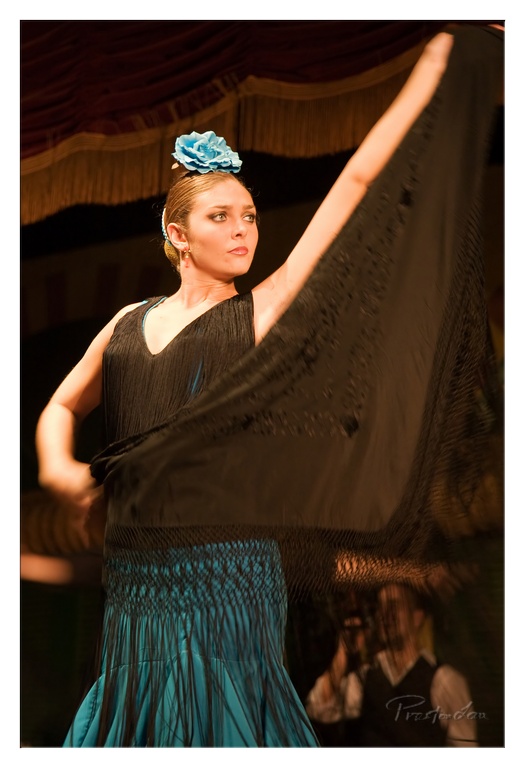

1. Overall Rating (0–10) — 7.5
This photograph captures the passion and grace of a flamenco dancer mid-performance, with her sweeping black shawl and vibrant turquoise skirt creating a dramatic visual contrast. The lighting accentuates her form and the texture of her costume, while the blurred background keeps the focus on her expressive pose. While the image is rich in emotion and movement, the slightly awkward framing and soft focus in the background reduce its overall polish.
2. Composition (0–10) — 7.0
The dancer is placed slightly off-center, creating a dynamic diagonal that draws the eye across the frame. The use of negative space on the right enhances the sense of motion, though the left side feels slightly crowded by the dancer’s arm and shawl, creating a minor imbalance.
3. Lighting (0–10) — 8.0
The warm, directional stage lighting highlights the dancer’s profile and costume, creating depth and emphasizing the texture of the shawl and fringe. The contrast between light and shadow enhances the theatricality of the moment.
4. Color & Tone (0–10) — 8.0
The deep black of the shawl and bodice contrasts beautifully with the vibrant turquoise of the skirt and the blue flower, creating a bold and harmonious palette. The warm tone of the lighting enhances the richness of the colors without overwhelming the scene.
5. Creativity (0–10) — 8.0
The photograph captures the essence of flamenco—intensity, rhythm, and theatrical expression—through both the dancer’s pose and the use of fabric as a storytelling element. The choice to freeze a moment of motion with a slightly blurred background adds narrative depth.
6. Technical Quality (0–10) — 7.5
The image is sharp on the dancer, with clear focus on her face and upper body. However, the background is softly blurred, which may be intentional but slightly reduces overall clarity. The slight noise in the darker areas suggests a high ISO setting.
7. Emotional Impact (0–10) — 8.5
The dancer’s intense gaze and poised posture convey a deep emotional commitment to her art. The viewer is drawn into the moment, feeling the rhythm and intensity of the performance, making this a powerful and evocative image.
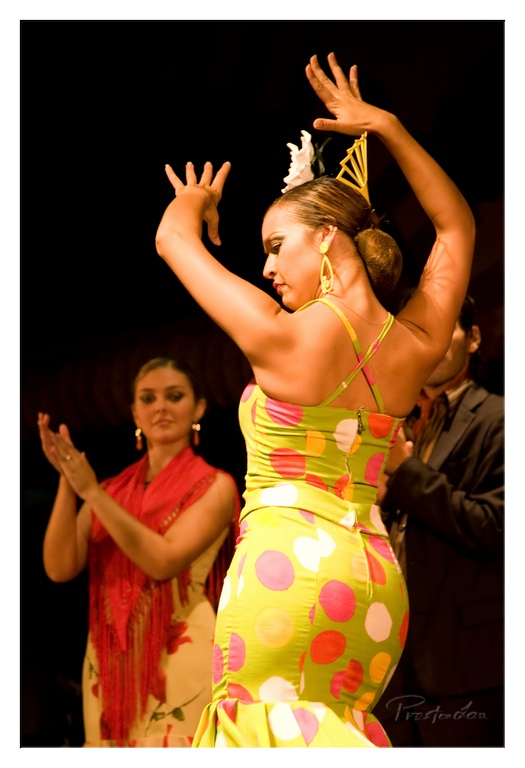

1. Overall Rating (0–10) — 8.0
This photograph captures the passion and dynamism of a flamenco performance, where movement and emotion converge in a single, powerful moment. The dancer’s poised gesture and expressive posture convey both grace and intensity, while the dark background isolates her as the focal point of the scene. The image balances technical clarity with artistic vitality, though the slightly awkward framing of the secondary figures tempers its overall elegance.
2. Composition (0–10) — 7.5
The dancer is well-placed, with her raised arms creating strong diagonal lines that draw the eye upward. The blurred background and partial inclusion of the audience members add depth, though the composition feels slightly off-center, with too much space to the right.
3. Lighting (0–10) — 8.0
The use of spotlighting creates a dramatic contrast, emphasizing the dancer’s form and costume against the dark backdrop. The warm, directional light enhances the texture of the fabric and highlights the contours of her body, adding a sense of theatricality.
4. Color & Tone (0–10) — 8.5
The bold, polka-dotted green dress bursts with energy, complemented by the warm tones of the lighting and the red scarf in the background. The palette is vibrant yet cohesive, with the contrast between the bright colors and the black background heightening visual impact.
5. Creativity (0–10) — 8.0
The image captures a moment of cultural expression with authenticity and flair. The choice to focus on the dancer’s profile and gesture rather than a frontal view lends a sense of narrative and movement, showcasing the performer’s artistry in motion.
6. Technical Quality (0–10) — 8.0
The image is sharp and well-focused on the dancer, with clean detail in the costume and facial features. The depth of field is effectively used to blur the background, and the exposure is balanced despite the high-contrast lighting.
7. Emotional Impact (0–10) — 8.5
The photograph evokes a strong sense of passion, rhythm, and cultural pride. The dancer’s poised expression and dynamic posture invite the viewer into the emotional world of flamenco, creating a compelling and immersive experience.
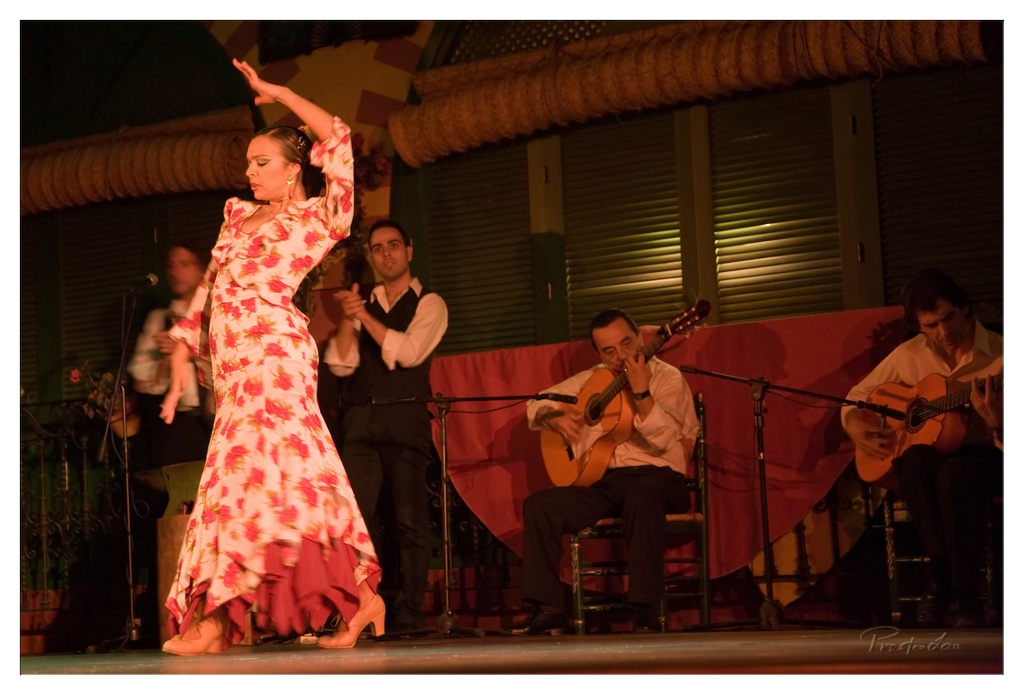

1. Overall Rating (0–10) — 7.5
This photograph captures the vibrant energy of a traditional flamenco performance, where movement and music converge in a moment of passionate expression. The dancer’s poised gesture and the musicians’ focused engagement create a compelling narrative of cultural artistry. While the lighting and composition lean toward documentary realism, the image successfully conveys the soul and rhythm of the performance, though it lacks the dramatic polish of a fully staged portrait.
2. Composition (0–10) — 6.5
The dancer is well-placed as the focal point, but the crowded stage and multiple subjects create visual distraction. The musicians, though integral, compete for attention, and the background elements slightly clutter the frame.
3. Lighting (0–10) — 7.0
Warm, directional stage lighting highlights the dancer and creates a sense of intimacy, enhancing the mood of the performance. The shadows add depth, though some areas of the background remain underexposed.
4. Color & Tone (0–10) — 7.5
The rich reds of the dancer’s dress and backdrop contrast beautifully with the warm amber tones of the lighting, creating a visually cohesive palette. The color temperature enhances the authenticity and emotional warmth of the scene.
5. Creativity (0–10) — 7.0
The image captures a dynamic cultural moment with authenticity, but the approach is more observational than artistically reinterpreted. The photographer documents the event rather than reimagining it.
6. Technical Quality (0–10) — 7.5
The image is sharp where it matters—on the dancer—and the motion is frozen effectively. The focus is consistent, and the exposure is well-managed despite the low-light environment.
7. Emotional Impact (0–10) — 8.0
The intensity of the dancer’s expression and the musicians’ engagement evoke a strong sense of passion and tradition. The viewer feels drawn into the rhythm and emotion of the performance.
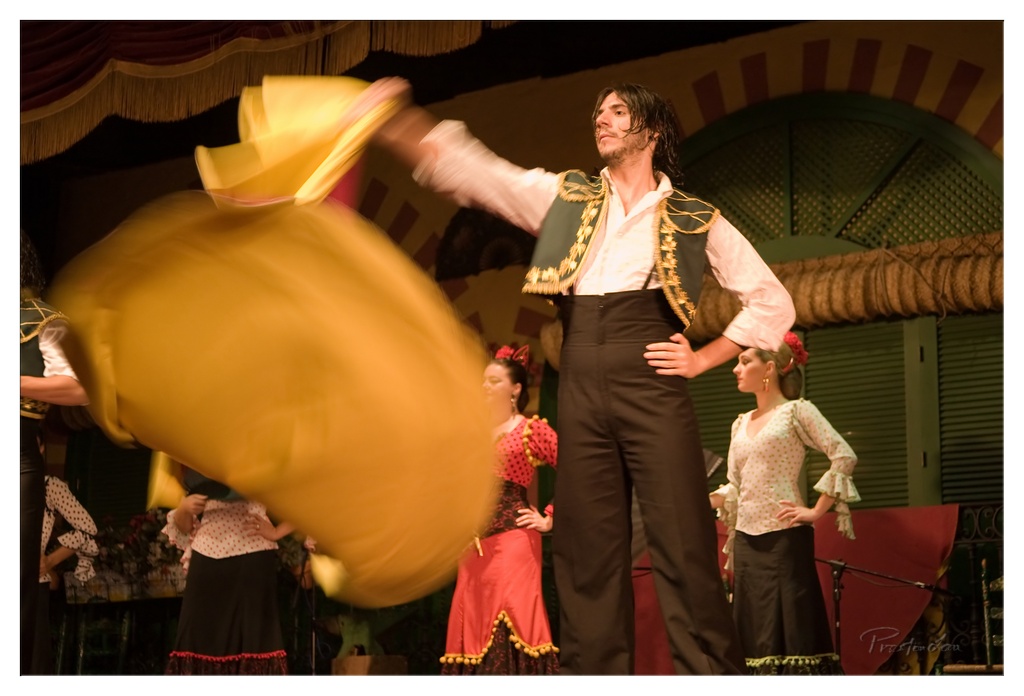

1. Overall Rating (0–10) — 7.5
This photograph captures the raw energy and theatricality of a flamenco performance, where motion and emotion collide in a single frame. The blurred yellow fan in the foreground creates a dynamic sense of movement, drawing the eye toward the central male dancer, whose poised stance and focused expression anchor the scene. While the image is rich with cultural authenticity and kinetic energy, the composition's slight imbalance and technical limitations in lighting prevent it from achieving full visual harmony.
2. Composition (0–10) — 6.5
The central dancer is well-placed, but the foreground motion blur, while expressive, partially obscures the scene and disrupts visual flow. A tighter focus on the main subject would enhance narrative clarity.
3. Lighting (0–10) — 6.0
Warm, directional stage lighting highlights the performers and creates a theatrical mood, but the deep shadows and uneven exposure reduce detail in the background and slightly flatten the depth of the stage.
4. Color & Tone (0–10) — 7.0
The rich, saturated yellows and deep reds of the costumes stand out against the darker backdrop, creating a vibrant, authentic palette. The warm tone enhances the passion of the performance, though some colors appear slightly oversaturated.
5. Creativity (0–10) — 8.0
The use of motion blur to convey energy is a strong artistic choice, and the framing captures the spontaneity of live performance. The image tells a story not just through the dancers, but through the interplay of movement and stillness.
6. Technical Quality (0–10) — 7.0
Sharp focus on the central figure is well-executed, and the image is free of major technical flaws. However, slight noise and uneven exposure in the darker areas detract from overall clarity.
7. Emotional Impact (0–10) — 8.0
The photograph conveys the intensity and soul of flamenco—its passion, pride, and drama—through both the dancers’ expressions and the kinetic energy of the movement, creating a powerful connection with the viewer.
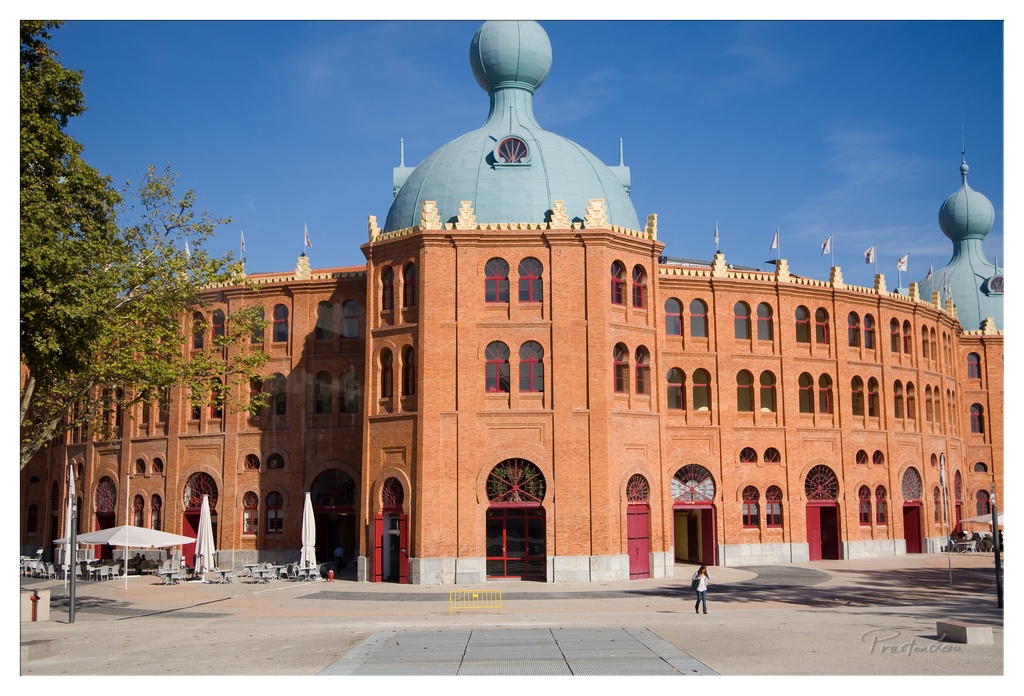

1. Overall Rating (0–10) — 7.5
This photograph captures the striking architectural grandeur of a historic brick building under a vivid blue sky, evoking a sense of cultural pride and timeless design. The bold color contrast between the warm terracotta and the cool dome creates a visually arresting composition, while the open plaza and lone figure add scale and quiet human presence. While the image is strong in composition and color, its emotional resonance is slightly restrained by the lack of dynamic interaction, making it more a portrait of place than a story of people.
2. Composition (0–10) — 8.0
The building is centered with strong symmetry, framed effectively by the tree on the left and the open plaza, creating balance and visual harmony. The diagonal lines of the pavement guide the eye toward the structure, while the lone figure provides a sense of scale and grounding.
3. Lighting (0–10) — 8.5
Bright, direct sunlight enhances the texture of the brickwork and casts crisp shadows, adding depth and dimension. The clear sky provides a clean, uncluttered backdrop that highlights the building’s silhouette and architectural details.
4. Color & Tone (0–10) — 8.0
The warm orange-red of the brick contrasts beautifully with the cool teal of the domes and the deep blue sky, creating a vibrant and harmonious palette. The tones are rich and saturated without appearing overprocessed, enhancing the image’s visual appeal.
5. Creativity (0–10) — 7.0
The image is a strong architectural study that emphasizes form and color, but its creativity lies more in observation than in narrative or conceptual innovation. The familiar subject and straightforward approach limit its originality, though the composition is thoughtfully executed.
6. Technical Quality (0–10) — 8.5
The image is sharp and well-focused, with excellent clarity in the architectural details and clean exposure. The resolution and depth of field are appropriate for the scene, capturing both the building and the surrounding space with precision.
7. Emotional Impact (0–10) — 6.5
The photograph conveys a sense of calm and dignity, inviting admiration for the building’s design and history. While it evokes appreciation for its aesthetic and cultural significance, it lacks a deeper emotional connection, remaining more observational than intimate.
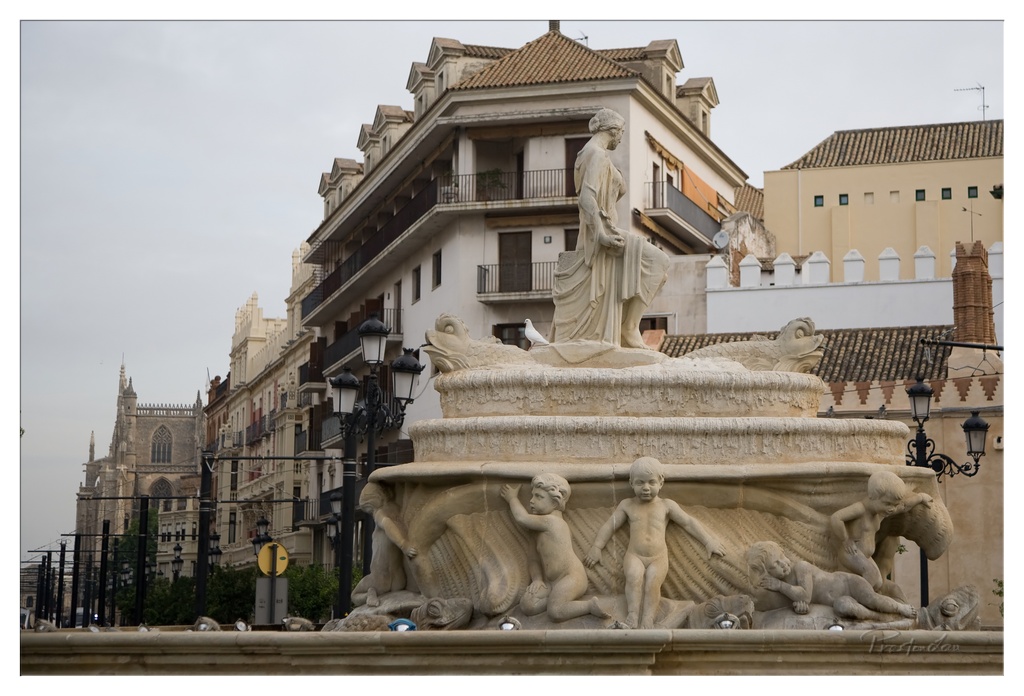

1. Overall Rating (0–10) — 7.0
This photograph captures the quiet dignity of a historic fountain set against the backdrop of a Mediterranean city, where architectural layers speak of centuries of history. The interplay between the classical sculpture and the surrounding urban fabric—balconied buildings, a distant cathedral, and period street lamps—creates a compelling narrative of continuity and place. While the overcast sky tempers the scene’s vibrancy, the image succeeds in conveying a sense of timelessness and cultural depth, though its emotional resonance is slightly muted by a lack of dynamic lighting.
2. Composition (0–10) — 7.5
The fountain is framed slightly off-center, drawing the eye upward to the central statue and toward the cathedral in the distance. The layered arrangement of the fountain, buildings, and sky creates depth, though the foreground edge slightly cuts into the base of the fountain, disrupting the visual flow.
3. Lighting (0–10) — 5.5
The diffuse, overcast light flattens shadows and softens textures, lending a somber tone to the scene. While it ensures even exposure across the stone details, the lack of directional light diminishes the sculptural drama and depth of the fountain.
4. Color & Tone (0–10) — 6.0
The palette is restrained, dominated by neutral beiges, grays, and muted earth tones, reflecting the stone and architecture. The subtle warmth in the terracotta roof tiles provides a gentle contrast, but the overall tone leans toward monochromatic, reducing visual excitement.
5. Creativity (0–10) — 7.0
The image presents a thoughtful juxtaposition of art and urban life, emphasizing historical continuity. The inclusion of the seagull perched on the fountain adds a touch of candid life, lending a quiet narrative quality to the otherwise static scene.
6. Technical Quality (0–10) — 8.0
Sharp focus is maintained across the entire frame, from the foreground figures to the distant cathedral. The exposure is balanced, with no blown highlights or crushed shadows, and the detail in the sculptural carvings is clear and well-defined.
7. Emotional Impact (0–10) — 6.5
The photograph evokes a sense of calm contemplation and historical reverence, inviting the viewer to reflect on the passage of time. While the mood is reflective, the lack of strong light or emotional contrast keeps the connection to the viewer from feeling deeply personal or stirring.
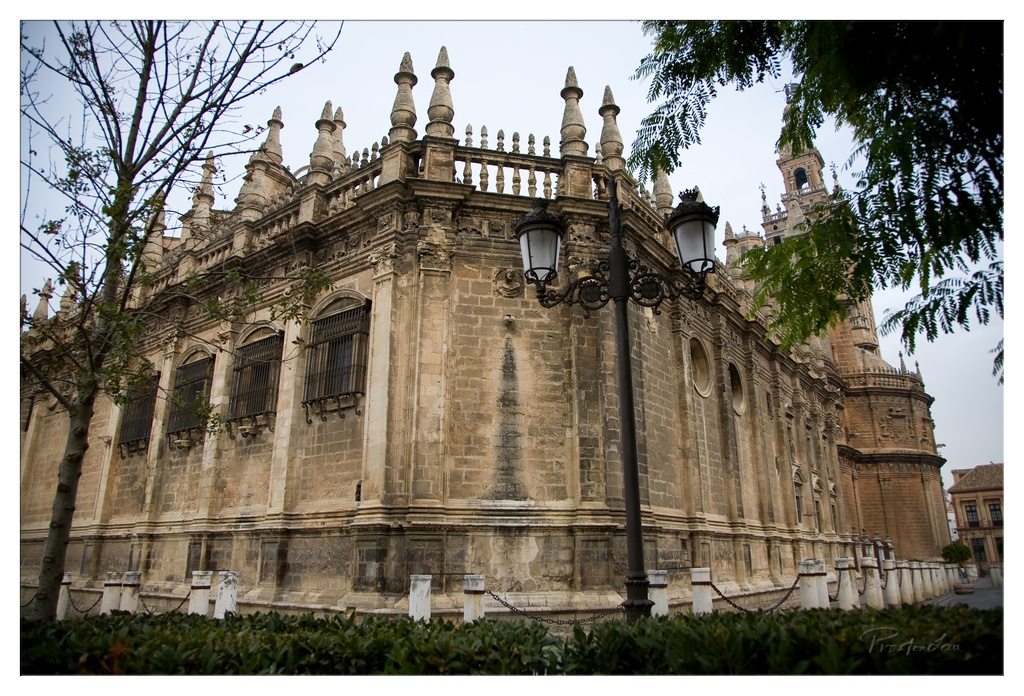

1. Overall Rating (0–10) — 7.0
This photograph captures the grandeur of a historic Spanish cathedral with a sense of quiet reverence, where architectural detail and natural framing combine to evoke timelessness. The interplay of stone textures, leafy branches, and the ornate lamppost adds depth and narrative weight, though the overcast sky tempers the image’s dramatic potential. The composition balances the monumental with the intimate, creating a moment that feels both documentary and poetic.
2. Composition (0–10) — 7.5
The low-angle perspective emphasizes the cathedral’s scale, while the framing by trees on both sides creates a natural vignette. The lamppost in the foreground adds depth and a subtle human element, guiding the eye into the scene without overpowering the architecture.
3. Lighting (0–10) — 6.0
The soft, diffused light of an overcast day evenly illuminates the stone facade, minimizing harsh shadows and allowing intricate details to emerge. While the lighting is even and flattering, it lacks the warmth or contrast that would heighten the image’s drama and mood.
4. Color & Tone (0–10) — 6.5
The muted earth tones of the stone harmonize with the green foliage, creating a natural, cohesive palette. The overall tonal range is subdued, with a slight cool cast that enhances the historical atmosphere but limits visual pop.
5. Creativity (0–10) — 7.0
The photographer blends architectural grandeur with organic elements—trees, lamppost, and shrubbery—to create a layered, narrative-rich image. The choice to frame the cathedral through foliage adds a poetic, almost hidden quality, suggesting discovery rather than display.
6. Technical Quality (0–10) — 8.0
Sharp focus across the frame, particularly on the central structure, reveals fine textures in the stonework. The exposure is well-balanced, with no blown highlights or lost shadows, and the watermark is discreet and unobtrusive.
7. Emotional Impact (0–10) — 7.0
The image conveys a contemplative stillness, inviting the viewer to pause and reflect on the passage of time. The quiet presence of the cathedral, softened by the surrounding nature, evokes a sense of reverence and permanence, making the viewer feel like a silent observer in a sacred space.
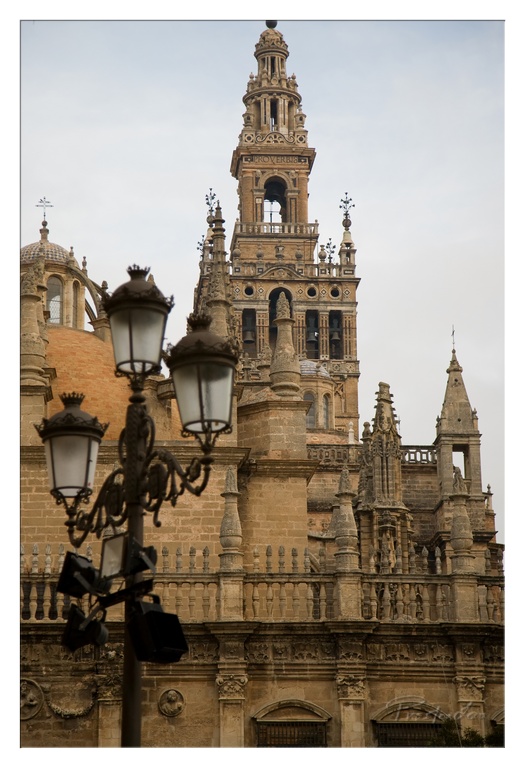

1. Overall Rating (0–10) — 7.5
This photograph captures the grandeur of Seville’s Giralda tower with a sense of historical weight and architectural reverence. The juxtaposition of the ornate, weathered stone against the vintage lamppost in the foreground creates a compelling narrative of time and place. While the overcast sky tempers the mood with a subdued tone, the image succeeds in conveying the monument’s majesty and enduring presence, though it lacks the dynamic lighting that might elevate its emotional resonance.
2. Composition (0–10) — 7.0
The lamppost in the foreground provides a strong visual anchor, leading the eye toward the tower’s intricate spire. The vertical alignment of the tower dominates the frame, creating a sense of upward movement, though the slightly off-center placement of the lamppost introduces a subtle imbalance that slightly weakens the symmetry.
3. Lighting (0–10) — 6.0
The soft, diffused light of an overcast day minimizes harsh shadows and highlights the texture of the stone, but it also flattens the image’s depth. The lack of directional light reduces contrast and diminishes the dramatic interplay between light and shadow that could have accentuated the architectural details.
4. Color & Tone (0–10) — 6.5
The palette is muted, dominated by earthy tones of beige and brown, with a cool gray sky that enhances the image’s somber, contemplative mood. While the colors are natural and harmonious, they lack vibrancy, resulting in a subdued visual impact.
5. Creativity (0–10) — 7.0
The inclusion of the lamppost as a framing device adds a layer of narrative and historical continuity, suggesting a blend of old and new. The choice to shoot from a low angle enhances the tower’s imposing scale, demonstrating thoughtful composition and a desire to convey awe.
6. Technical Quality (0–10) — 8.0
The image is sharp and clear, with excellent detail in the stonework and lamppost. The focus is precise, and the camera settings appear well-suited to the scene, capturing both foreground and background with clarity.
7. Emotional Impact (0–10) — 7.0
The photograph evokes a sense of reverence and quiet contemplation, inviting the viewer to reflect on the passage of time and the endurance of cultural landmarks. While the overcast sky tempers the emotional intensity, the image’s historical weight and visual depth create a lasting impression.
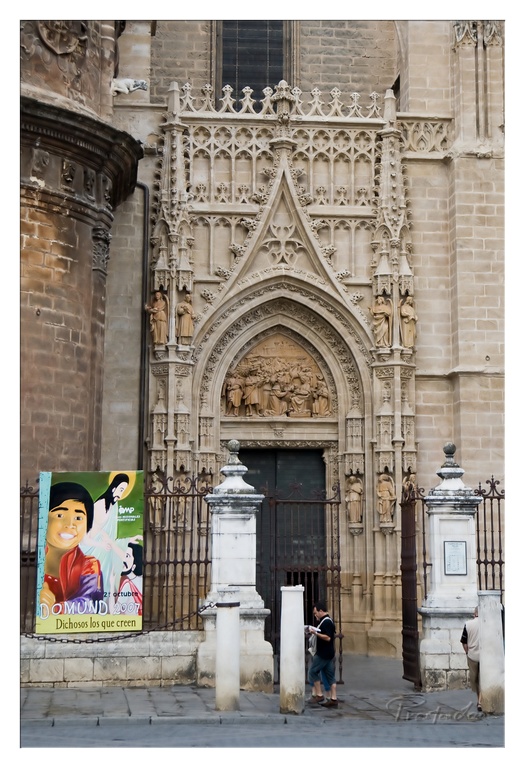

1. Overall Rating (0–10) — 6.0
This photograph captures the juxtaposition of sacred architecture and modern life, where the ornate Gothic portal of a cathedral stands in quiet contrast to a colorful, contemporary poster and a passerby absorbed in their phone. The historical grandeur of the stone carving and the intricate tracery are compelling, yet the intrusion of the poster and the casual figure disrupts the image’s solemnity, creating a tension between time and place. While the scene is rich in narrative, the composition struggles to balance its competing elements, leaving the viewer with a sense of visual dissonance rather than harmony.
2. Composition (0–10) — 5.5
The Gothic entrance dominates the frame, but the placement of the poster on the left and the pedestrian on the right creates an uneven balance. The vertical lines of the architecture pull the eye upward, but the cluttered foreground and the off-center subject weaken the overall structure.
3. Lighting (0–10) — 6.0
Natural daylight illuminates the scene evenly, allowing the textures of the stone to emerge clearly. The soft, diffused light enhances the architectural details without creating harsh shadows, though it slightly flattens the depth of the scene.
4. Color & Tone (0–10) — 5.5
The muted beige and gray tones of the stone dominate, creating a neutral backdrop that contrasts with the bright, saturated colors of the poster. While the poster adds visual interest, its artificial vibrancy feels out of place, disrupting the image’s tonal coherence.
5. Creativity (0–10) — 6.5
The photograph succeeds in capturing a compelling narrative moment—the collision of the sacred and the secular, the past and the present. The inclusion of the modern poster and the smartphone-wielding figure adds a layer of commentary on contemporary life, though the execution feels more observational than artistically refined.
6. Technical Quality (0–10) — 7.5
The image is sharp and well-focused, with fine detail visible in the stonework and the poster. The exposure is balanced, and the camera’s resolution captures the textures clearly, though the slight overexposure in the poster’s colors slightly undermines the overall realism.
7. Emotional Impact (0–10) — 5.0
The image evokes a sense of quiet melancholy, as the enduring beauty of the cathedral is overshadowed by the fleeting, transient elements of modern life. While the viewer is drawn to the story, the emotional resonance is muted by the lack of a unified visual voice.
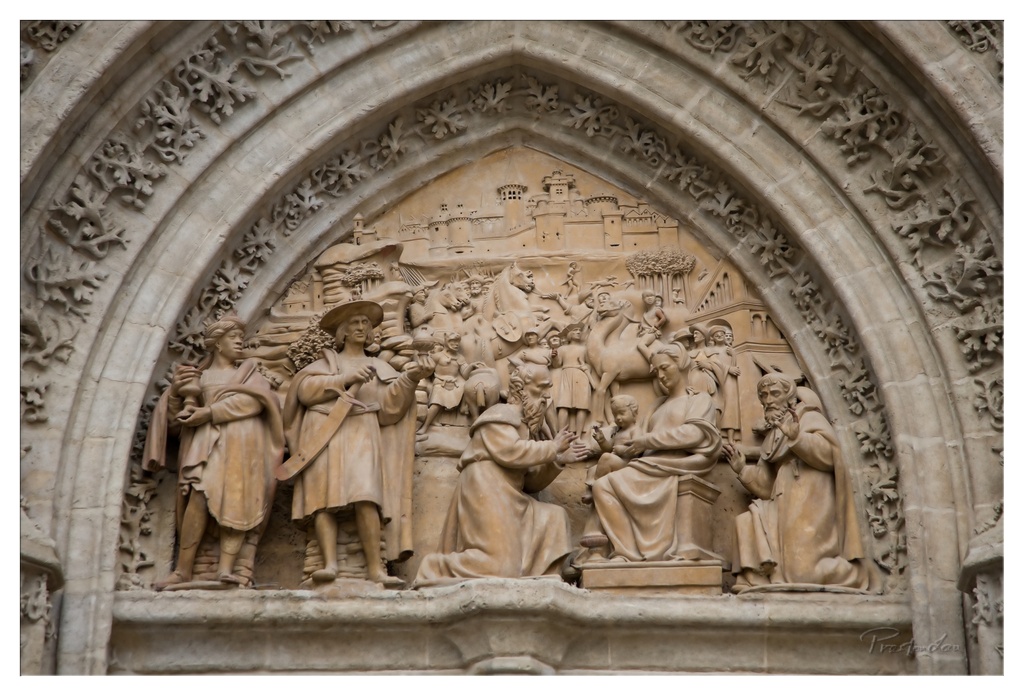

1. Overall Rating (0–10) — 8.0
This photograph captures the intricate grandeur of a Gothic stone relief with remarkable clarity, emphasizing the narrative depth and craftsmanship of the sculpture. The composition draws the eye naturally into the scene, while the warm, even lighting enhances the texture and form of the carvings. Though the image is grounded in historical documentation, it achieves a subtle artistic resonance through its balance of detail and mood.
2. Composition (0–10) — 8.0
The arched frame of the relief provides strong natural symmetry and guides the viewer’s gaze toward the central figures. The sculptural depth is well-captured, with foreground and background elements balanced to convey narrative complexity without visual clutter.
3. Lighting (0–10) — 8.5
Soft, diffused light highlights the texture of the stone and the subtle variations in relief depth, avoiding harsh shadows. The even illumination enhances the three-dimensionality of the figures and creates a contemplative, reverent atmosphere.
4. Color & Tone (0–10) — 7.5
The palette is restrained and cohesive, dominated by warm beige and earthy tones that reflect the natural stone. The tonal range is smooth, with slight contrast that separates the figures from the background without overpowering the subtlety of the carving.
5. Creativity (0–10) — 7.0
The image is a strong example of architectural photography, focusing on the storytelling within the relief. While not overtly experimental, it successfully frames the sculpture as a historical and artistic artifact, inviting reflection on its meaning and context.
6. Technical Quality (0–10) — 9.0
Sharp focus across the entire relief, precise exposure, and clean detail in the intricate carvings demonstrate excellent technical execution. The image is well-resolved, with no visible artifacts or focus errors.
7. Emotional Impact (0–10) — 7.5
The photograph conveys a sense of reverence and timelessness, allowing the viewer to connect with the narrative and artistry of the sculptor. The quiet dignity of the scene evokes contemplation, suggesting a moment suspended between history and devotion.
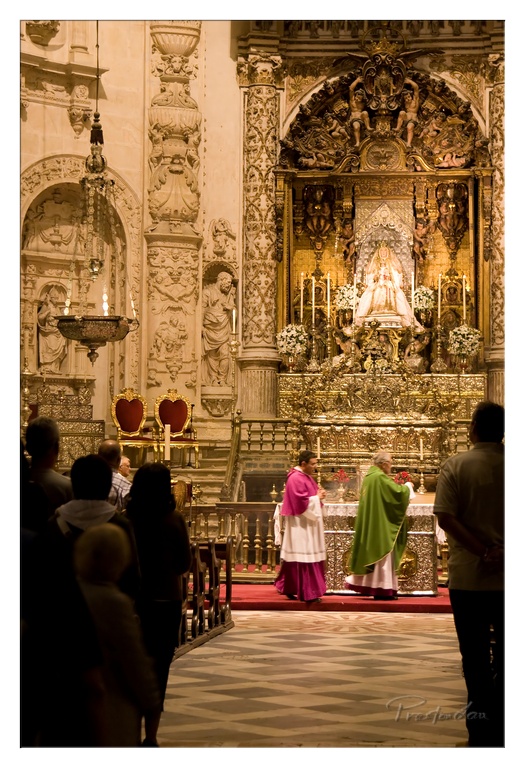

1. Overall Rating (0–10) — 7.5
This photograph captures the solemn grandeur of a religious ceremony within an ornate cathedral, where light, texture, and tradition converge in a moment of spiritual gravity. The intricate baroque details of the altar and surrounding architecture lend a sense of historical depth, while the silhouetted congregation grounds the scene in human presence. Though the image is rich in atmosphere, the lighting and composition slightly compromise the clarity of the central action, keeping it from achieving full visual and emotional resonance.
2. Composition (0–10) — 7.0
The framing balances the grandeur of the altar with the presence of worshippers, creating a layered narrative. However, the foreground silhouettes, while adding depth, slightly obstruct the view of the priests and altar, and the off-center placement of the main subjects disrupts perfect symmetry.
3. Lighting (0–10) — 7.5
The warm, directional lighting from the altar highlights the golden embellishments and casts a reverent glow across the scene, enhancing the sacred mood. The contrast between the illuminated sanctuary and the dimly lit nave creates dramatic depth, though some areas in the foreground fall into near-black shadow.
4. Color & Tone (0–10) — 8.0
The palette is dominated by warm golds, deep reds, and muted earth tones, reinforcing the ceremonial and historical atmosphere. The richness of the colors—especially the vibrant magenta and green vestments—stands out against the neutral stone, adding visual warmth and symbolic weight.
5. Creativity (0–10) — 8.0
The image captures a moment of authentic religious life within a visually opulent setting, blending sacred tradition with documentary realism. The juxtaposition of ancient architecture and living ceremony gives the photograph a narrative richness and a sense of continuity.
6. Technical Quality (0–10) — 8.0
The image is sharp and well-focused, with excellent detail in the architectural elements and vestments. The exposure is balanced overall, though some loss of detail in the shadows suggests a slight overexposure in the highlights.
7. Emotional Impact (0–10) — 8.5
There is a palpable sense of reverence and solemnity, amplified by the quiet stillness of the congregation and the ceremonial focus of the clergy. The image invites contemplation, evoking a feeling of being present at a sacred rite, even from a distance.
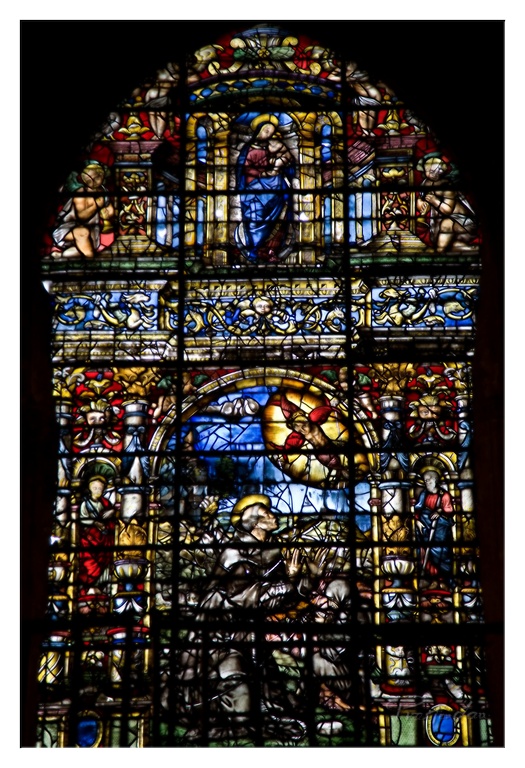

1. Overall Rating (0–10) — 8.0
This stained glass window radiates a luminous richness, capturing the spiritual grandeur of a sacred narrative with intricate detail and deep color harmony. The interplay of light through the glass creates a dynamic, almost living quality, while the composition draws the eye upward in reverence. A slight overexposure in the central panel diminishes some of the subtlety, but the overall effect remains profoundly evocative and visually compelling.
2. Composition (0–10) — 8.5
The vertical symmetry and hierarchical arrangement guide the viewer’s gaze from the lower narrative scenes to the central divine figure above, creating a sense of spiritual ascent. The leaded structure frames each element with precision, enhancing the narrative flow while maintaining balance.
3. Lighting (0–10) — 9.0
Natural light filters through the glass, transforming the scene into a radiant tableau where color and shadow dance across the panels. The soft diffusion creates depth and mood, highlighting key figures while allowing the surrounding darkness to emphasize the luminosity of the glass.
4. Color & Tone (0–10) — 9.0
A vibrant yet harmonious palette of deep blues, rich reds, and golden yellows evokes a sense of sacred opulence. The contrast between the bright stained glass and the dark surrounding frame intensifies the visual impact, while the subtle gradations within the glass add tonal richness.
5. Creativity (0–10) — 8.5
The artist’s mastery of storytelling through symbolic imagery and layered composition reflects both technical skill and spiritual intent. The integration of narrative and architecture demonstrates a creative vision that transcends mere decoration, embodying centuries of religious artistry.
6. Technical Quality (0–10) — 8.0
The image is sharp and clear, capturing the fine lines of the lead cames and the texture of the glass with precision. While the lighting is effective, the slightly uneven exposure in the central figure suggests a minor technical limitation in the capture.
7. Emotional Impact (0–10) — 9.0
The window evokes a profound sense of awe and contemplation, inviting the viewer into a quiet moment of reverence. The interplay of light, color, and sacred imagery creates an emotional resonance that feels both timeless and deeply personal.
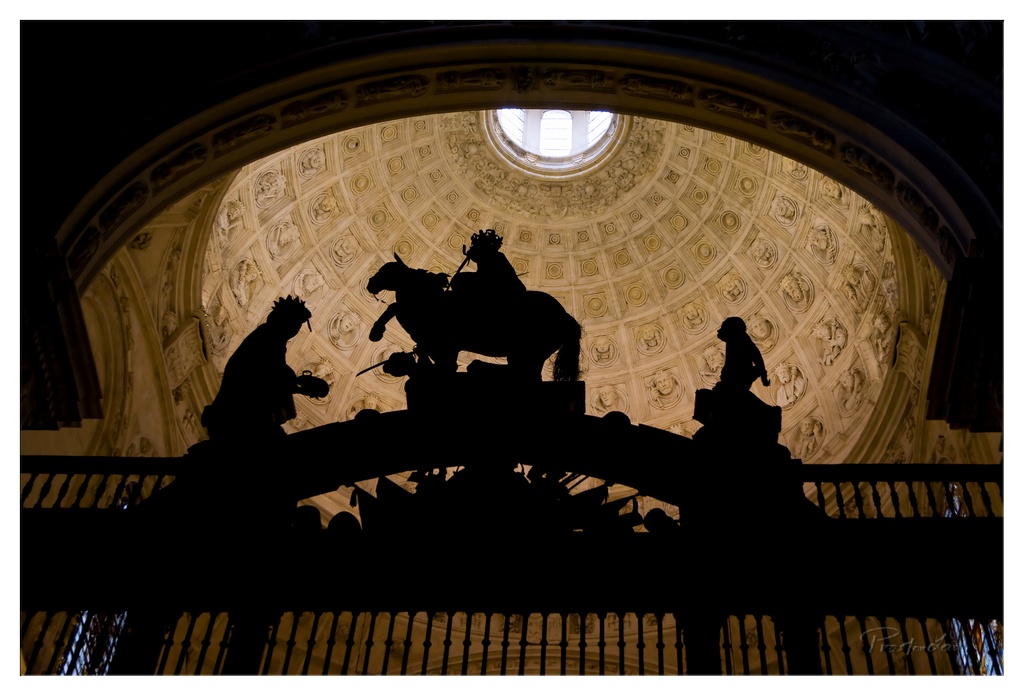

1. Overall Rating (0–10) — 8.0
This photograph masterfully captures the dramatic interplay between light and shadow within a grand architectural space, transforming a historical monument into a powerful silhouette. The silhouette of the equestrian statue stands as a commanding focal point against the luminous, intricately detailed dome, evoking a sense of timelessness and reverence. While the deep black of the foreground may obscure some texture, the image's strength lies in its bold contrast and storytelling depth, making it a compelling visual narrative of power and artistry.
2. Composition (0–10) — 8.5
The central placement of the equestrian statue within the arch frames the image with strong symmetry, drawing the eye directly to the illuminated dome. The use of leading lines from the balustrade and the architectural curve enhances depth, while the silhouetted figures on either side create visual balance and narrative intrigue.
3. Lighting (0–10) — 9.0
The lighting is exceptionally well executed, with the natural light from the oculus at the dome’s apex creating a radiant backlight that perfectly silhouettes the sculpture and highlights the architectural details. The contrast between the bright dome and the dark foreground is stark yet harmonious, giving the image a theatrical and almost sacred quality.
4. Color & Tone (0–10) — 7.5
The monochromatic palette emphasizes tone over color, with a warm, golden glow from the dome contrasting against the deep blacks of the silhouette. While the lack of vibrant color limits the image’s chromatic range, the tonal variation enhances its dramatic and timeless mood.
5. Creativity (0–10) — 8.5
The photographer transforms a potentially static architectural scene into a dynamic and symbolic image by using silhouette to emphasize form and narrative. The choice to frame the shot from below and use the oculus as a light source reflects a thoughtful, artistic approach that elevates the subject beyond mere documentation.
6. Technical Quality (0–10) — 8.0
The image is sharp and clear, with precise focus on the architectural details of the dome. The exposure is well-managed, capturing the brightness of the oculus without overexposing, and the silhouetted foreground retains its depth without losing definition.
7. Emotional Impact (0–10) — 8.5
The image evokes awe and reverence, inviting the viewer to contemplate the legacy of power and art represented by the statue and its setting. The dramatic lighting and imposing composition stir a sense of grandeur and historical weight, creating a deeply resonant and contemplative experience.
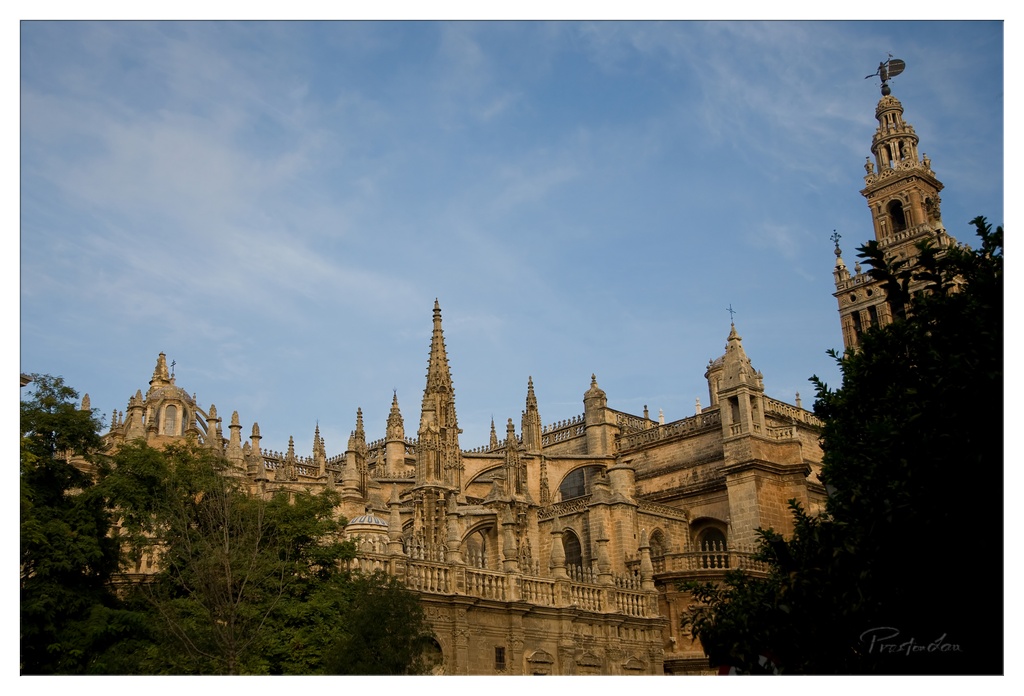

1. Overall Rating (0–10) — 7.5
This photograph captures the majestic silhouette of a Gothic cathedral against a soft, expansive sky, evoking a sense of historical grandeur and serene timelessness. The interplay of light and shadow across the stone facade highlights intricate architectural details, while the framing through tree branches adds a natural, intimate foreground. While the composition is strong, the lighting slightly flattens the depth of the stonework, and the dark foliage on the right feels a bit heavy, slightly overwhelming the visual balance.
2. Composition (0–10) — 7.0
The low-angle perspective emphasizes the cathedral’s verticality and scale, while the tree branches on both sides create a natural frame that guides the eye toward the central spires. However, the dense foliage on the right side slightly disrupts the symmetry and draws attention away from the main subject.
3. Lighting (0–10) — 7.5
The soft, golden light of late afternoon or early morning enhances the texture of the stone and casts gentle shadows that accentuate the architectural complexity. The sky provides a luminous backdrop, and the contrast between the illuminated facade and the darker foreground adds depth without overwhelming the scene.
4. Color & Tone (0–10) — 7.0
The warm, earthy tones of the stone contrast beautifully with the pale blue sky, creating a harmonious and balanced palette. The deep greens of the trees add a natural contrast, though the shadows on the right are slightly too dark, reducing tonal range in that area.
5. Creativity (0–10) — 7.5
The photographer skillfully uses natural framing and perspective to emphasize the cathedral’s awe-inspiring scale. The choice to include the trees adds a layer of narrative, suggesting the cathedral as a living part of its environment rather than a detached monument.
6. Technical Quality (0–10) — 8.0
The image is sharp and well-focused, with excellent clarity in the architectural details. The exposure is well-managed, and the dynamic range is handled effectively, preserving detail in both highlights and shadows.
7. Emotional Impact (0–10) — 8.0
There is a strong sense of reverence and awe in the image, evoking the quiet majesty of a historic landmark. The soft light and elevated viewpoint invite contemplation, making the viewer feel small in the presence of centuries of craftsmanship and faith.
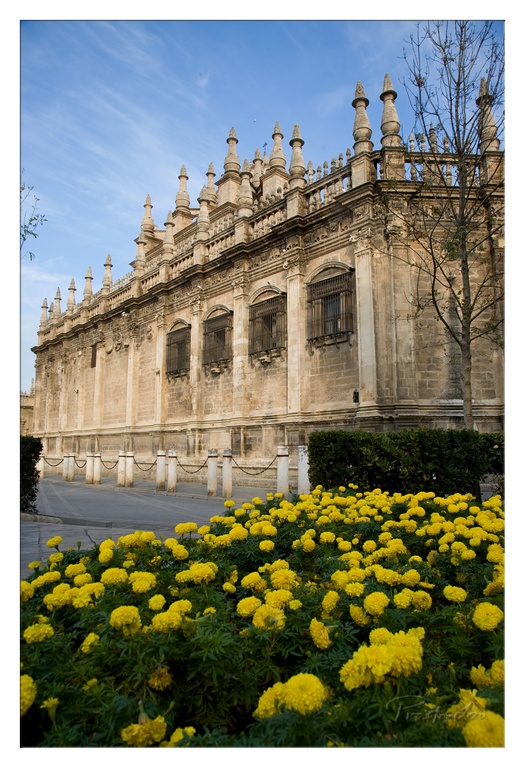

1. Overall Rating (0–10) — 7.5
This photograph beautifully juxtaposes the enduring grandeur of historic architecture with the vibrant vitality of nature, creating a harmonious dialogue between past and present. The warm stone of the building contrasts elegantly with the bright yellow marigolds in the foreground, while the clear blue sky adds a sense of openness and tranquility. The image is visually rich and emotionally resonant, though it slightly lacks the dynamic tension that would elevate it beyond a pleasant scene to a compelling narrative.
2. Composition (0–10) — 8.0
The low-angle framing emphasizes the verticality of the building and draws the eye upward, while the foreground flowers create a natural leading line toward the structure. The placement of the bare tree on the right balances the composition and adds depth without distracting from the main subject.
3. Lighting (0–10) — 8.0
Soft, natural daylight enhances the texture of the stonework and illuminates the yellow flowers with warmth and clarity. The gentle shadows add dimension to the facade, and the bright sky provides a clean, uncluttered backdrop that allows the architecture to stand out.
4. Color & Tone (0–10) — 8.5
The warm golden tones of the stone harmonize beautifully with the vivid yellow of the marigolds, while the cool blue of the sky creates a pleasing contrast. The color palette is balanced and vibrant, enhancing the visual appeal without appearing overprocessed.
5. Creativity (0–10) — 7.5
The photographer skillfully combines elements of nature and architecture to create a visually engaging scene. The use of color and composition suggests a thoughtful approach, though the subject matter remains relatively conventional, limiting its conceptual originality.
6. Technical Quality (0–10) — 8.5
The image is sharp and well-focused, with excellent clarity throughout the frame. The exposure is balanced, preserving detail in both the bright sky and the shaded areas of the building. The overall resolution and detail suggest a high-quality capture.
7. Emotional Impact (0–10) — 8.0
The photograph evokes a sense of peace, timelessness, and appreciation for cultural heritage. The juxtaposition of the ancient structure and the lively blooms creates a quiet optimism, inviting the viewer to pause and reflect on the beauty of enduring traditions and the renewal of nature.
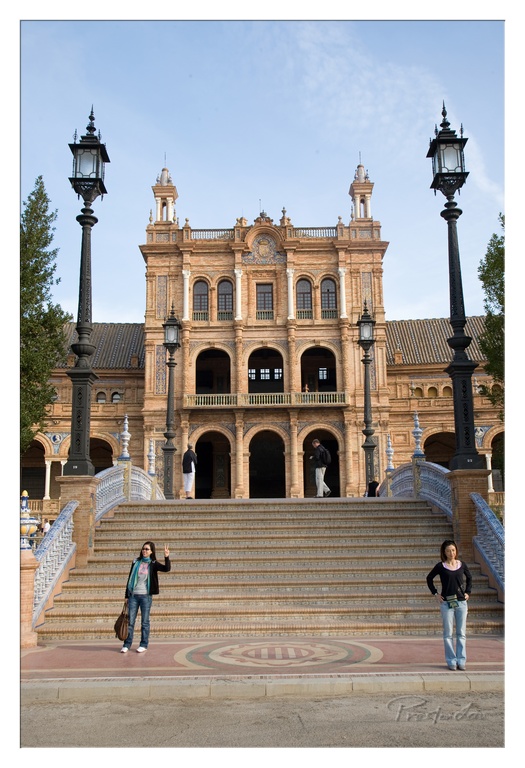

1. Overall Rating (0–10) — 7.0
This photograph captures the grandeur of the Plaza de España with a sense of scale and cultural richness, anchored by the ornate architecture and the presence of visitors who lend a human dimension to the scene. The symmetrical composition and warm tones evoke a feeling of place and time, though the image’s potential is slightly diminished by a lack of dynamic lighting and a somewhat generic tourist aesthetic. It succeeds as a travel portrait, but could feel more artistically resonant with stronger visual storytelling.
2. Composition (0–10) — 7.5
The symmetrical framing around the central staircase and building creates a balanced, formal composition. The placement of the two women on either side of the steps adds visual interest and scale, while the lampposts act as framing devices that guide the eye toward the main structure.
3. Lighting (0–10) — 6.5
The bright, even daylight provides clear visibility and highlights the architectural details, but the flatness of the light lacks depth and shadow, reducing the dramatic impact. The clear sky contributes to a neutral mood, emphasizing documentation over atmosphere.
4. Color & Tone (0–10) — 7.0
The warm terracotta tones of the building harmonize beautifully with the blue sky and the colorful mosaic details, creating a rich, inviting palette. The contrast between the warm architecture and cool sky adds visual interest, though the colors feel slightly muted.
5. Creativity (0–10) — 6.5
The image is a strong example of architectural travel photography, capturing a well-known landmark with clarity and presence. However, it relies on familiar composition and subject matter, offering little in the way of originality or conceptual depth.
6. Technical Quality (0–10) — 8.0
The image is sharp and well-focused, with clean detail throughout the building and foreground. The exposure is balanced, and the depth of field is appropriate for capturing both the architecture and the people.
7. Emotional Impact (0–10) — 6.0
The photograph conveys a sense of place and travel, evoking feelings of curiosity and appreciation for cultural heritage. While the emotional resonance is moderate, the image invites the viewer to imagine standing in the scene—yet it doesn’t deeply stir the senses or provoke introspection.
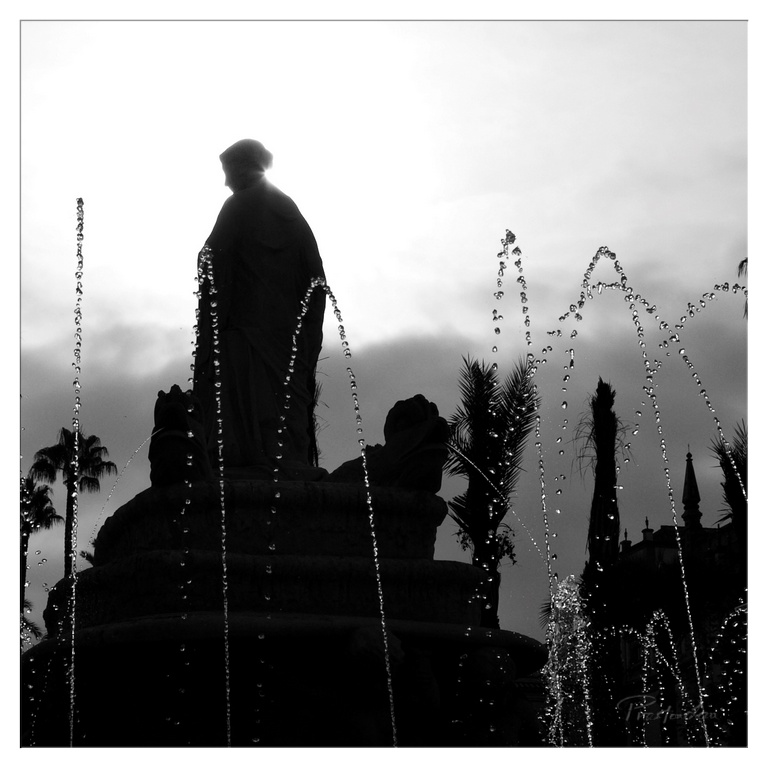

1. Overall Rating (0–10) — 7.0
This black-and-white photograph captures a striking interplay between light and motion, transforming a public fountain into a poetic silhouette. The contrast between the dark statue and the luminous water jets creates a dramatic, almost theatrical atmosphere, while the scattered droplets add a sense of delicate movement. Though the composition is strong, the lack of tonal range in the sky slightly flattens the depth, keeping the image from achieving full visual resonance.
2. Composition (0–10) — 7.5
The statue is centered with strong vertical emphasis, drawing the eye upward, while the cascading water jets create dynamic diagonal lines that guide the viewer through the frame. The inclusion of palm trees and architectural elements in the background adds depth, though the right side feels slightly more cluttered than the left.
3. Lighting (0–10) — 8.0
Backlighting is masterfully used to render the statue as a bold silhouette, emphasizing form over detail. The bright, overcast sky creates a high-contrast environment, and the water droplets catch the light, appearing as sparkling points that enhance the sense of motion.
4. Color & Tone (0–10) — 8.5
The monochromatic palette enhances the image’s dramatic mood, with deep blacks and luminous whites creating a stark, graphic quality. The absence of color allows the textures—of the stone, water, and foliage—to take center stage, while the subtle tonal gradations in the sky add atmospheric depth.
5. Creativity (0–10) — 7.5
The photographer transforms a common urban scene into a contemplative, almost spiritual moment by emphasizing form, light, and movement. The choice to capture water in mid-air, suspended like a constellation of droplets, adds a layer of poetic imagination to the otherwise straightforward subject.
6. Technical Quality (0–10) — 8.0
The image is sharp and well-exposed, with clear definition in the water trails and the statue’s silhouette. The focus is precise, and the grain is minimal, suggesting a high-quality capture with careful attention to camera settings and timing.
7. Emotional Impact (0–10) — 7.0
The photograph evokes a sense of stillness amid motion, inviting quiet reflection. The solitary figure of the statue, framed by the rhythmic arc of water, suggests themes of time, permanence, and the fleeting beauty of momentary light—creating a contemplative and slightly melancholic mood.
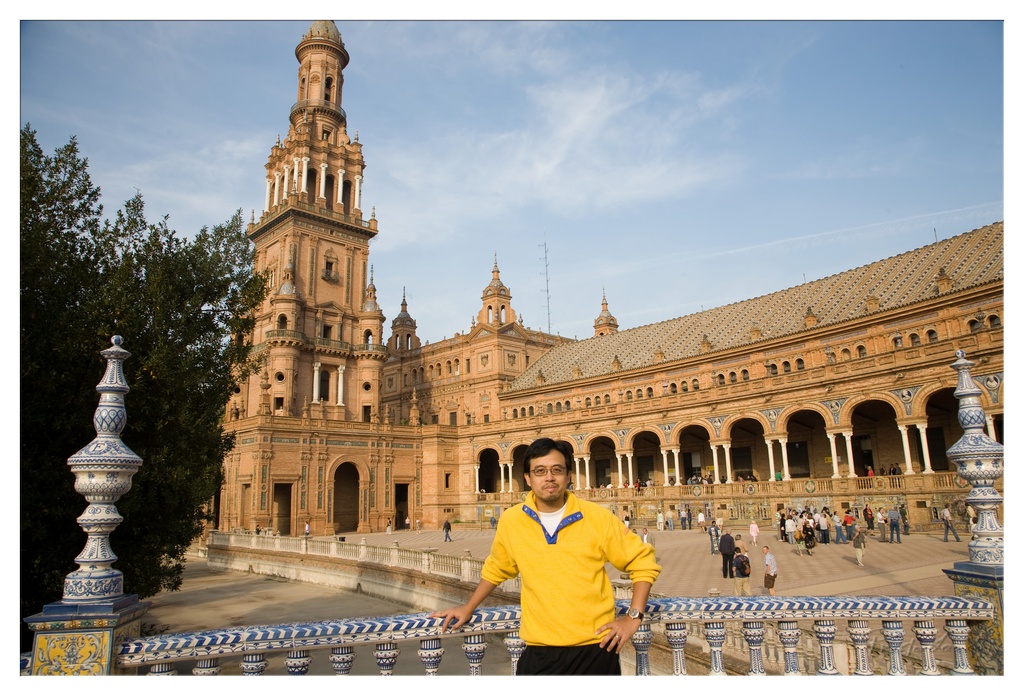

1. Overall Rating (0–10) — 7.5
This photograph captures a vibrant moment at the Plaza de España in Seville, blending personal presence with architectural grandeur. The subject’s warm smile and confident stance create a sense of joy and connection to the iconic setting, while the rich textures of the ceramic tiles and the ornate tower lend a sense of cultural depth. While the composition is strong and the colors vivid, the slightly flat lighting and busy background keep the image from feeling fully immersive.
2. Composition (0–10) — 7.0
The subject is well-placed in the foreground, drawing immediate attention, while the tower and colonnades create a layered, dynamic backdrop. The symmetry of the railing and architecture grounds the image, though the wide framing includes distracting background activity.
3. Lighting (0–10) — 6.5
Natural daylight illuminates the scene evenly, but lacks the golden warmth of sunrise or sunset, resulting in a somewhat neutral tone. The sky is slightly overexposed, washing out subtle cloud details.
4. Color & Tone (0–10) — 8.0
The warm terracotta tones of the building contrast beautifully with the cool blue of the sky and the bright yellow of the subject’s shirt. The ceramic tiles add pops of vivid blue and white, enhancing the visual richness and cultural authenticity.
5. Creativity (0–10) — 7.5
The image successfully merges personal storytelling with architectural homage, using the iconic location as a narrative backdrop. The choice to place the subject in the foreground gives the photograph a personal, travelogue feel.
6. Technical Quality (0–10) — 8.0
Sharp focus on the subject and clear detail in the architecture suggest strong technical execution. The exposure is well-balanced, though minor overexposure in the sky slightly detracts from the overall polish.
7. Emotional Impact (0–10) — 7.0
The photograph evokes a sense of travel, discovery, and personal fulfillment. The subject’s expression conveys genuine delight, inviting viewers to imagine themselves in the moment, though the distance created by the crowd and scale of the architecture limits intimacy.
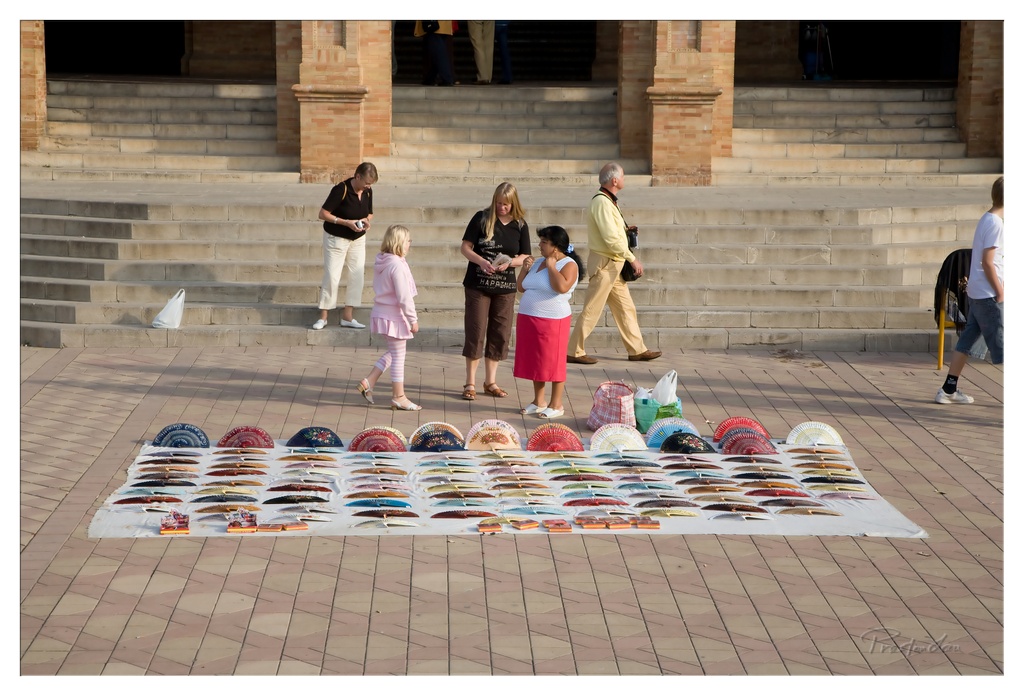

1. Overall Rating (0–10) — 6.0
This photograph captures a lively street market scene with a vendor’s colorful wares laid out on the pavement, offering a glimpse into daily commerce in a public space. The arrangement of the hats creates a strong visual rhythm, and the warm sunlight enhances the vibrancy of the colors, lending the image a candid, documentary feel. However, the composition feels slightly unbalanced, and the scattered figures, while adding life, don’t fully coalesce into a cohesive narrative, leaving the image feeling more like a snapshot than a carefully composed statement.
2. Composition (0–10) — 5.5
The wide framing includes too much empty space at the top, with the stairs and architectural elements overpowering the central action. The vendor’s display is well-centered, but the diagonal movement of the people creates visual tension without clear direction.
3. Lighting (0–10) — 7.0
The late afternoon sunlight casts long, soft shadows and enriches the warm tones of the brick and textiles, creating a natural and inviting glow. The light enhances the texture and color of the hats, though some areas are slightly overexposed.
4. Color & Tone (0–10) — 7.5
The palette is rich and varied, with the bright, multicolored hats standing out against the muted terracotta and beige surroundings. The warm color temperature enhances the sense of a sunny, bustling day, and the contrast between the vivid goods and the neutral pavement draws the eye effectively.
5. Creativity (0–10) — 6.5
The image successfully captures a moment of everyday life with a strong emphasis on pattern and color. While not particularly original in concept, the arrangement of the hats creates a visually engaging grid that elevates the scene beyond mere documentation.
6. Technical Quality (0–10) — 7.0
The image is sharp and well-focused, with fine detail visible in both the hats and the background. The exposure is balanced, though slight overexposure in the highlights slightly reduces dynamic range.
7. Emotional Impact (0–10) — 6.0
The scene evokes a sense of casual activity and cultural authenticity, but the emotional resonance is muted by the lack of a clear focal point or narrative thread. The viewer is invited to observe, but not deeply moved.
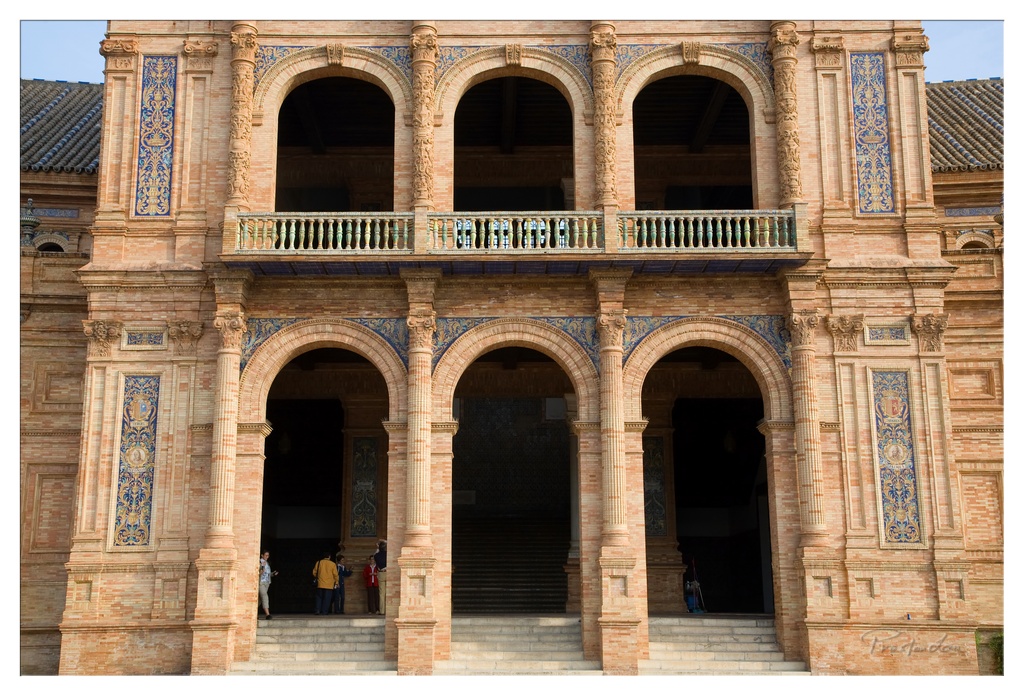

1. Overall Rating (0–10) — 7.5
This photograph captures the grandeur of a historic Spanish architectural facade with rich detail and a strong sense of cultural depth. The interplay of warm terracotta brick and vibrant blue tilework creates a visually compelling contrast, emphasizing the craftsmanship of the structure. While the composition is strong, the presence of people introduces a slight distraction, and the lighting, though natural, lacks the dramatic flair that could elevate the image into something truly cinematic.
2. Composition (0–10) — 7.0
The symmetrical arrangement of arches and columns creates a balanced and harmonious frame, drawing the eye toward the central staircase. The inclusion of visitors adds a sense of scale and life, though their placement slightly disrupts the formal symmetry. A tighter crop could enhance focus on the architectural details.
3. Lighting (0–10) — 6.5
Natural daylight illuminates the facade evenly, highlighting textures and tile patterns without harsh shadows. However, the flatness of the light reduces depth and dimensionality, and the sky appears slightly overexposed, detracting from the overall mood.
4. Color & Tone (0–10) — 8.0
The warm, earthy tones of the brick contrast beautifully with the cool, intricate blue and gold tilework, creating a rich and inviting palette. The colors are well-saturated and harmonious, enhancing the visual appeal of the architecture.
5. Creativity (0–10) — 7.5
The image successfully captures the essence of Andalusian design, blending cultural heritage with photographic documentation. While not overtly experimental, the choice to frame the building in a way that emphasizes both its symmetry and human scale demonstrates thoughtful storytelling.
6. Technical Quality (0–10) — 8.0
The image is sharp and well-focused, with excellent clarity in the architectural details. The exposure is balanced overall, though minor issues in the sky’s brightness suggest slight overexposure in highlights.
7. Emotional Impact (0–10) — 7.0
The photograph evokes a sense of awe and reverence for historical craftsmanship, inviting the viewer to appreciate the artistry of the structure. The human figures add a touch of relatability, grounding the grandeur in everyday experience.
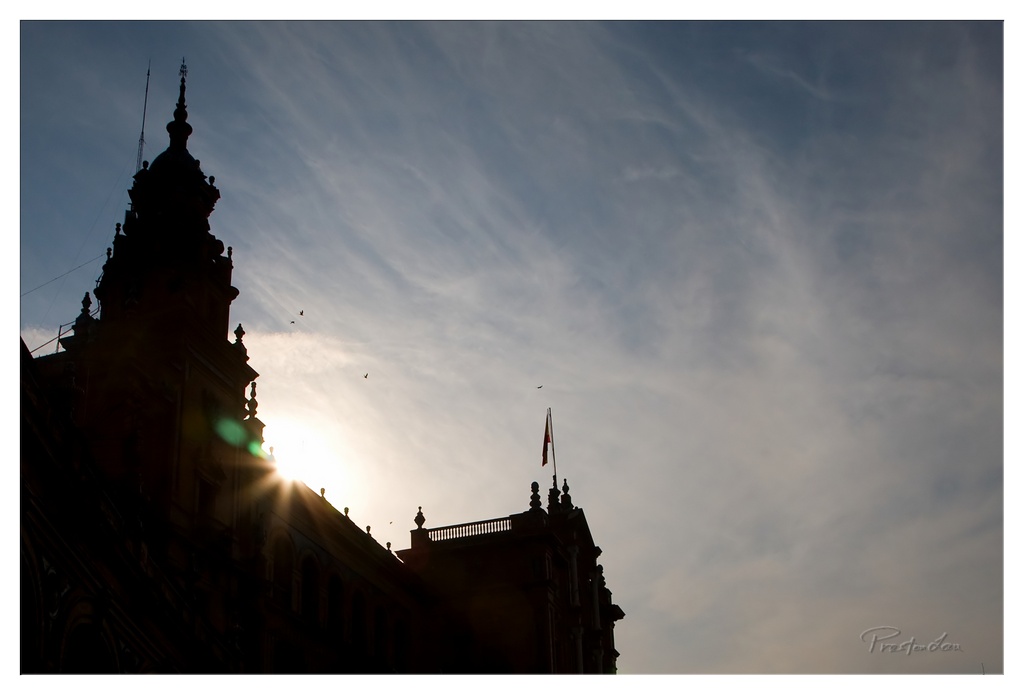

1. Overall Rating (0–10) — 7.0
This photograph captures a moment of serene grandeur, where the silhouetted architecture of a historic building stands in quiet contrast against a luminous sky. The sun, positioned just behind the structure, creates a radiant burst of light that imbues the scene with a spiritual and almost reverent atmosphere. While the composition is strong, the lack of detail in the silhouette limits the viewer’s ability to fully appreciate the building’s craftsmanship, leaving the image feeling more atmospheric than informative.
2. Composition (0–10) — 7.5
The diagonal placement of the building leads the eye upward, creating a sense of verticality and grandeur. The negative space on the right balances the frame, allowing the sky and light to dominate without overwhelming the subject.
3. Lighting (0–10) — 8.0
The backlighting is masterfully used, creating a dramatic silhouette and a radiant sunburst that enhances the mood. The soft, wispy clouds catch the light beautifully, adding texture and depth to the sky.
4. Color & Tone (0–10) — 6.5
The palette is limited to warm golds and cool grays, which work well together but lack vibrancy. The tones are atmospheric, but the absence of rich color reduces the visual impact.
5. Creativity (0–10) — 7.0
The choice to capture the scene in silhouette is bold and effective, emphasizing form and light over detail. The inclusion of the flag and birds adds subtle narrative elements, suggesting both place and movement.
6. Technical Quality (0–10) — 7.5
The image is sharp and well-exposed, with clear detail in the sky and a strong sun flare that adds visual interest. The focus is precise, and the exposure correctly captures the contrast between light and shadow.
7. Emotional Impact (0–10) — 7.5
The photograph evokes a sense of awe and tranquility, capturing a fleeting moment of beauty in an urban setting. The interplay of light and shadow creates a contemplative mood that resonates with the viewer.
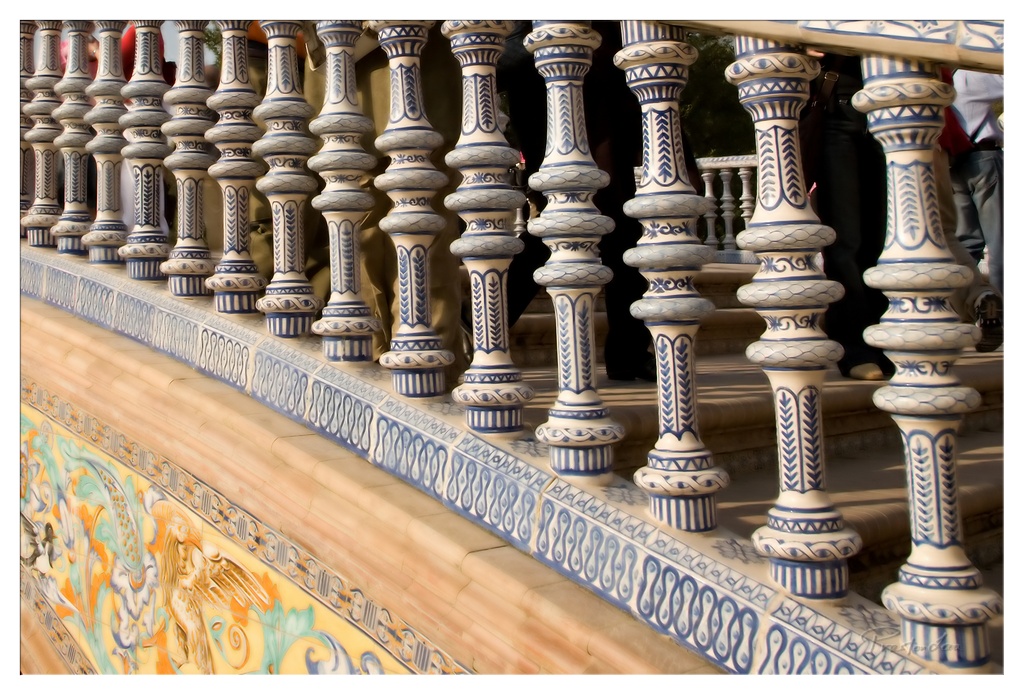

1. Overall Rating (0–10) — 7.5
This photograph captures the ornate elegance of a tiled balustrade, where intricate patterns and vibrant colors speak to a rich cultural heritage. The rhythmic repetition of the columns draws the eye through the frame, while the warm sunlight enhances the depth and texture of the ceramics. Though the background figures are slightly distracting, the image succeeds in conveying both architectural beauty and a sense of place, balancing form and narrative with quiet confidence.
2. Composition (0–10) — 8.0
The diagonal alignment of the balustrade creates a strong leading line, guiding the viewer through the frame with a sense of movement. The tight framing emphasizes pattern and repetition, while the inclusion of the colorful mural in the lower-left corner adds visual contrast and depth.
3. Lighting (0–10) — 8.5
Natural sunlight illuminates the scene with a warm, golden glow, enhancing the richness of the glazed tiles and casting subtle shadows that accentuate their three-dimensional forms. The light direction adds depth and texture, making the patterns pop with clarity.
4. Color & Tone (0–10) — 8.0
The blue-and-white ceramic patterns are complemented by the warm, earthy tones of the wall and the vibrant hues of the mural, creating a dynamic yet harmonious palette. The contrast between cool and warm tones adds visual interest and enhances the cultural richness of the scene.
5. Creativity (0–10) — 7.5
The photograph transforms an architectural detail into a compelling visual narrative, emphasizing pattern and rhythm. While the subject is rooted in tradition, the framing and lighting give it a contemporary artistic sensibility.
6. Technical Quality (0–10) — 8.5
Sharp focus across the ceramic balusters ensures clarity in the intricate designs. The image is well-exposed, with balanced highlights and shadows, and the colors are rich and true to life.
7. Emotional Impact (0–10) — 7.0
The photograph evokes a sense of wonder and appreciation for craftsmanship, inviting the viewer to pause and admire the artistry embedded in everyday structures. The subtle presence of people in the background adds a quiet human touch, grounding the scene in lived experience.
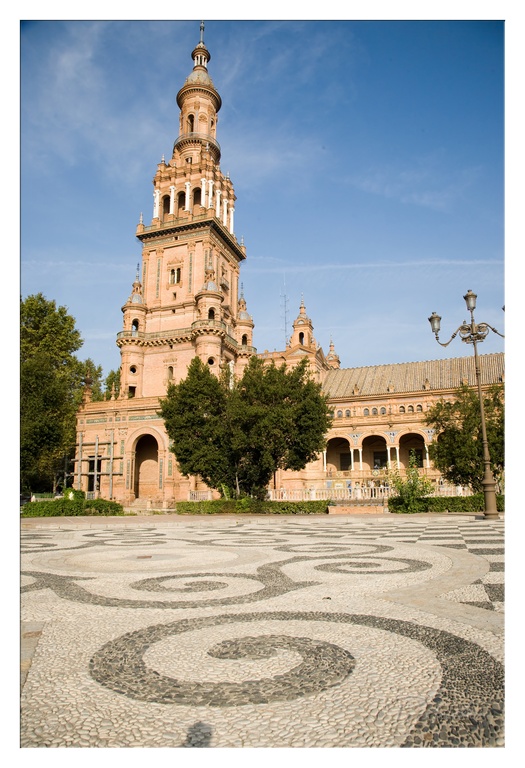

1. Overall Rating (0–10) — 7.5
This photograph captures the grandeur of the Plaza de España in Seville with a striking sense of architectural harmony and cultural richness. The interplay between the ornate tower, the sweeping mosaic pavement, and the clear blue sky creates a visually compelling scene that feels both timeless and inviting. While the composition is strong, the image could benefit from slightly more dynamic lighting and a more deliberate framing to elevate its artistic impact.
2. Composition (0–10) — 7.0
The low-angle perspective emphasizes the monumentality of the tower, while the swirling patterns of the pavement draw the eye toward the center of the frame. The placement of the lamppost and trees adds depth and balance, though the right side feels slightly underutilized.
3. Lighting (0–10) — 7.5
Natural daylight enhances the warm terracotta tones of the building and casts soft shadows that define its intricate details. The bright, clear sky adds contrast and depth, though a touch of golden-hour warmth would have intensified the mood.
4. Color & Tone (0–10) — 7.0
The palette is rich and cohesive, with earthy pinks and beiges complemented by the deep gray of the mosaic and the vibrant blue of the sky. The tonal range is well-balanced, though the overall coolness of the scene slightly tempers the warmth of the architecture.
5. Creativity (0–10) — 7.5
The photographer captures a well-known landmark with a fresh eye, using the unique geometry of the pavement to create a dynamic visual journey. The choice to include the shadow of the photographer adds a subtle, personal touch.
6. Technical Quality (0–10) — 8.0
The image is sharp and detailed, with excellent focus across the frame. The exposure is well-managed, preserving both highlights and shadows without over-processing.
7. Emotional Impact (0–10) — 7.0
The photograph evokes a sense of awe and tranquility, inviting the viewer to imagine the history and stories embedded in the plaza. While it captures the beauty of the site, the emotional resonance is slightly restrained by the lack of human presence.
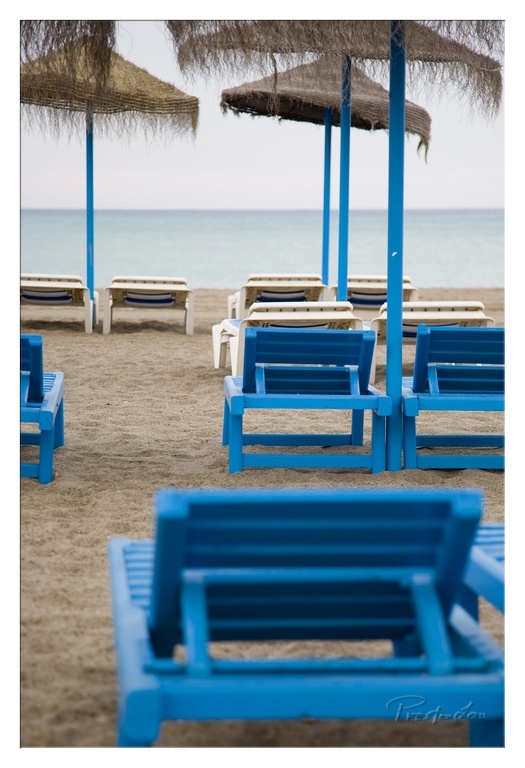

1. Overall Rating (0–10) — 7.0
This photograph captures a serene and slightly melancholic beach scene, where the vibrant blue lounge chairs contrast beautifully with the muted tones of the sand and sea. The shallow depth of field draws the eye into the tranquil space, emphasizing solitude and stillness. While the image is visually striking, its emotional weight is tempered by a lack of human presence, leaving the scene feeling more like a staged retreat than a lived moment.
2. Composition (0–10) — 7.5
The arrangement of chairs and umbrellas creates a strong sense of rhythm and repetition, leading the eye toward the horizon. The use of foreground blur and leading lines enhances depth, though the central placement of the umbrellas slightly flattens the visual dynamic.
3. Lighting (0–10) — 6.5
Soft, diffused light from an overcast sky creates even illumination, minimizing harsh shadows and contributing to the calm mood. However, the lack of strong sunlight or golden hour warmth tempers the image’s visual energy.
4. Color & Tone (0–10) — 8.0
The cool color palette—dominated by blues and muted grays—evokes a quiet, contemplative atmosphere. The contrast between the vivid blue chairs and the subdued background enhances visual interest and reinforces the theme of isolation.
5. Creativity (0–10) — 7.0
The photographer effectively uses repetition and selective focus to transform a familiar beach scene into something introspective. The absence of people and the careful framing suggest a deliberate narrative of emptiness and anticipation.
6. Technical Quality (0–10) — 8.0
The image is sharp in the midground, with clean detail and well-managed focus. The shallow depth of field is executed skillfully, and the watermark is subtle and unobtrusive.
7. Emotional Impact (0–10) — 7.5
The image evokes a sense of peaceful solitude and quiet longing, inviting the viewer to imagine the stories that might unfold in this empty space. The emotional resonance lies in its stillness and the unspoken narrative of a place waiting for life to return.
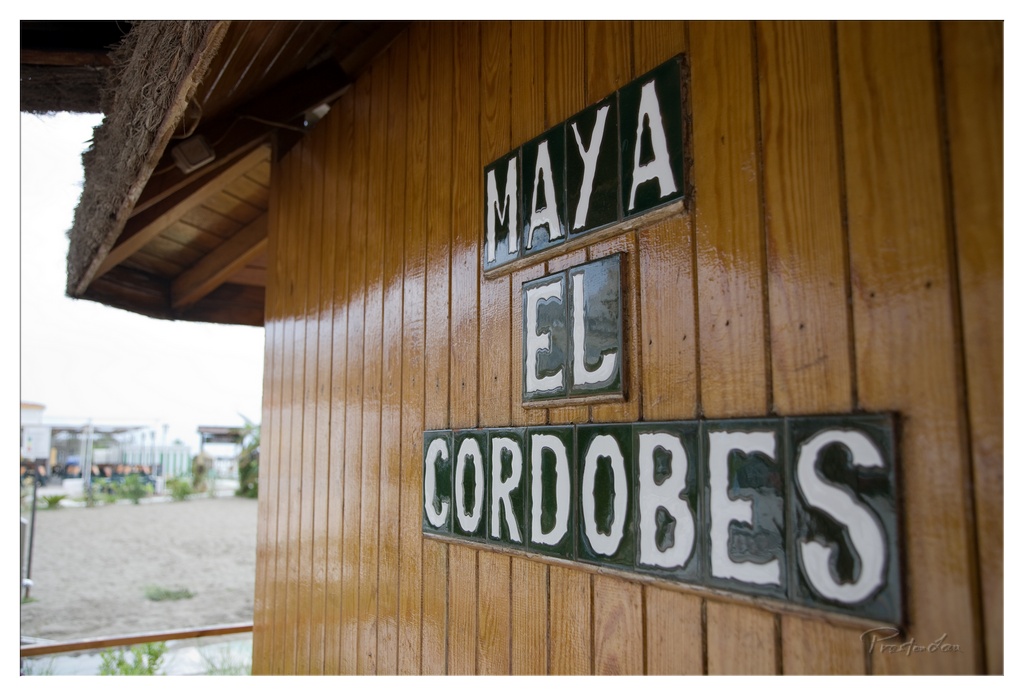

1. Overall Rating (0–10) — 6.0
This photograph captures a quiet, sun-drenched moment at a rustic wooden structure, where the name "MAYA EL CORDOBES" is prominently displayed in bold, tile letters. The warm wood grain and natural textures evoke a sense of authenticity and place, grounding the image in a Mediterranean or Andalusian coastal atmosphere. While the composition is grounded and visually clear, it lacks a compelling narrative or emotional depth, feeling more like a casual snapshot than a fully realized portrait of the location.
2. Composition (0–10) — 6.5
The sign is well-framed and centered, drawing the eye with its strong vertical lines and clear typography. The shallow depth of field blurs the background, effectively isolating the subject and emphasizing the name. However, the left edge of the frame cuts off the thatched roof abruptly, slightly disrupting the balance and suggesting a more casual framing than intentional design.
3. Lighting (0–10) — 7.0
Soft, diffused daylight illuminates the scene evenly, enhancing the natural grain of the wood and giving the tiles a subtle sheen. The overcast sky prevents harsh shadows, allowing the textures and details to remain visible without loss of detail or contrast. The lighting supports the calm, understated mood of the image.
4. Color & Tone (0–10) — 6.5
The palette is warm and earthy, dominated by the golden brown of the wood and the dark green of the tiles. The white lettering creates a crisp contrast, while the muted background tones keep the focus on the sign. The overall tone is natural but restrained, lacking a strong color temperature or vibrancy that would elevate the mood.
5. Creativity (0–10) — 6.0
The image relies on a straightforward, documentary-style approach, capturing a place with clarity and authenticity. While the choice of subject and texture is evocative, there’s little experimentation in perspective or editing. The photograph tells a story of location and identity, but it doesn’t push the boundaries of visual storytelling.
6. Technical Quality (0–10) — 7.5
The focus is sharp on the sign, with a smooth bokeh effect in the background that effectively separates the subject. The image is well-exposed, with no noticeable noise or artifacts. The watermark is discreet, and the overall clarity suggests careful handling of both camera and post-processing.
7. Emotional Impact (0–10) — 5.5
The image conveys a sense of quiet place and cultural identity, inviting curiosity about the name and its significance. However, the emotional resonance is muted—more observational than evocative. It prompts questions rather than stirring strong feelings, leaving the viewer to wonder about the story behind "Maya El Cordobes" without offering much emotional connection.
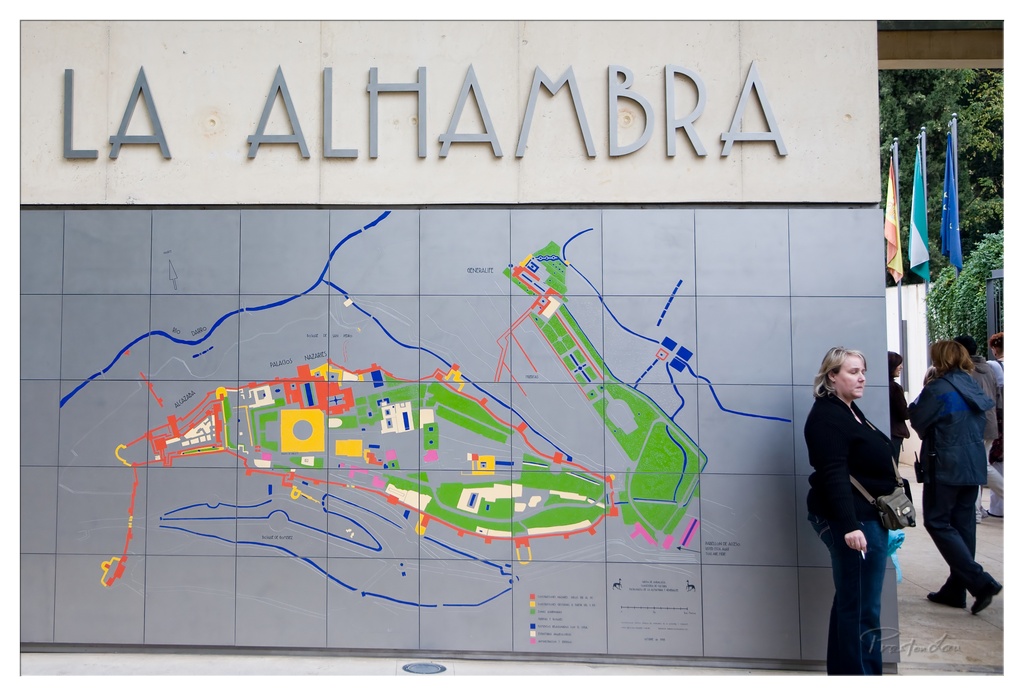

1. Overall Rating (0–10) — 6.0
This photograph captures a quiet moment of observation at the entrance to La Alhambra, where a large, detailed map serves as both guide and cultural marker. The composition balances human presence with historical context, grounding the viewer in a place of layered significance. While the image effectively conveys the location’s identity, its visual energy is tempered by a somewhat passive atmosphere and a lack of dramatic lighting or dynamic framing.
2. Composition (0–10) — 6.5
The map dominates the frame, creating a strong visual anchor, while the woman on the right adds scale and narrative. However, the placement of the figures feels slightly off-center and underdeveloped, reducing the overall compositional harmony.
3. Lighting (0–10) — 6.0
Natural daylight provides even illumination, clearly revealing the details of the map and signage. The light is functional but unremarkable, lacking the warmth or contrast that might elevate the mood.
4. Color & Tone (0–10) — 6.5
The palette is largely neutral—grays and muted tones—punctuated by the soft greens and reds of the map. While the colors are distinct, they remain subdued, giving the image a documentary rather than artistic quality.
5. Creativity (0–10) — 6.0
The image presents a straightforward yet meaningful scene—blending history, travel, and human interaction. While it offers a clear narrative, it leans more toward documentation than creative interpretation.
6. Technical Quality (0–10) — 7.5
Sharp focus, clean detail, and well-balanced exposure contribute to a technically sound image. The clarity of the map and text is excellent, enhancing the photograph’s informational value.
7. Emotional Impact (0–10) — 5.5
The image evokes a sense of contemplation and travel, but the emotional resonance is limited by the distance between the viewer and the subjects. It feels more like a snapshot than a moment of connection.
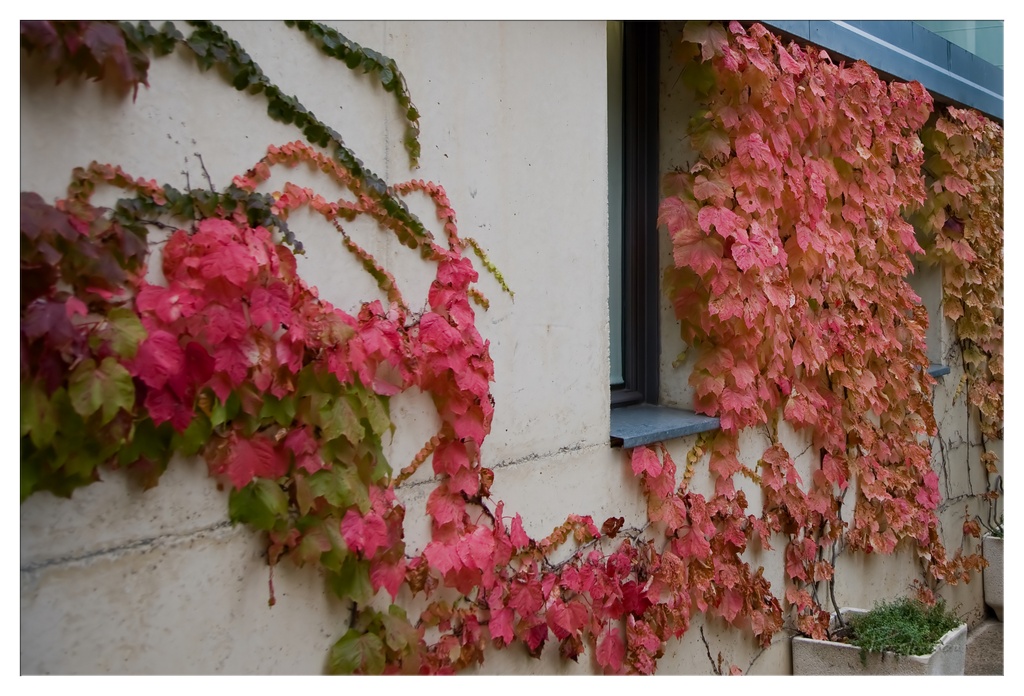

1. Overall Rating (0–10) — 7.5
This photograph captures the quiet beauty of autumn’s transformation, where vibrant red and pink ivy climbs a weathered wall like a living tapestry. The contrast between the warm, fiery leaves and the muted, textured stone creates a compelling visual rhythm, evoking a sense of time passing and nature reclaiming urban spaces. While the composition is strong, the scene feels slightly overexposed in the highlights, softening the detail in the brightest leaves.
2. Composition (0–10) — 7.0
The framing follows the natural flow of the ivy, creating a diagonal movement from the lower left to the upper right, drawing the eye across the image. The window acts as a subtle anchor, grounding the composition and adding depth. However, the left side feels slightly more cluttered, and a tighter crop could enhance balance.
3. Lighting (0–10) — 6.5
The light is soft and diffused, likely from an overcast sky, which evenly illuminates the wall and prevents harsh shadows. This enhances the texture of the stone and the delicate veins in the leaves. However, the highlights on the red foliage appear slightly blown out, reducing detail in the most vibrant areas.
4. Color & Tone (0–10) — 8.0
The color palette is rich and autumnal, with deep pinks and purples contrasting beautifully against the neutral beige wall. The warm tones evoke a cozy, nostalgic mood, while the green stems provide a subtle complementary contrast. The overall tonal range is well-balanced, though the slight overexposure in the highlights tempers the richness.
5. Creativity (0–10) — 7.5
The image captures a common seasonal moment with an artistic eye, transforming a simple wall covered in ivy into a study of texture, color, and form. The choice to frame the ivy as a natural mosaic, with the window as a quiet punctuation, shows thoughtful composition and a clear aesthetic vision.
6. Technical Quality (0–10) — 7.5
The focus is sharp on the central cluster of leaves, with a gentle depth of field that softens the background slightly. The image is clear and well-exposed overall, though the highlights in the upper right show signs of being pushed too bright. The noise level is minimal, and the details are crisp where they matter most.
7. Emotional Impact (0–10) — 7.0
There’s a quiet melancholy in the scene—of change, of the seasons turning, of life clinging to the edges of human structures. The image invites contemplation, evoking a sense of peaceful decay and natural beauty persisting in the urban landscape. It doesn’t shout, but it lingers.
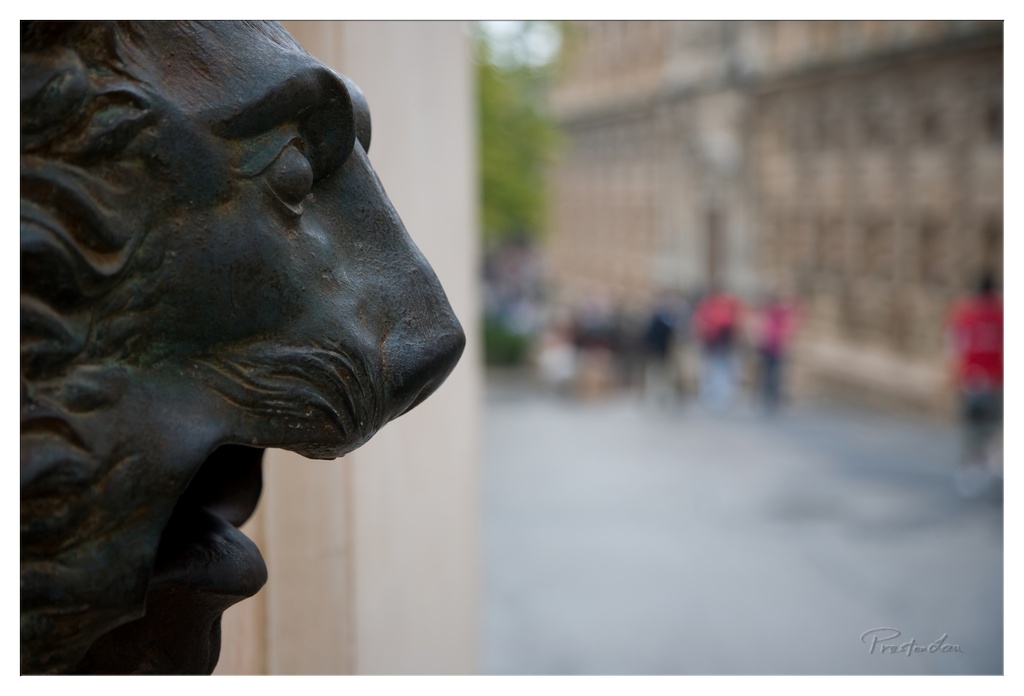

1. Overall Rating (0–10) — 7.5
This photograph masterfully juxtaposes the stillness of a sculpted lion with the fleeting motion of a city street, creating a quiet dialogue between permanence and transience. The sharp focus on the lion’s weathered face draws the eye immediately, while the blurred background suggests life unfolding beyond, imbuing the image with a contemplative, almost cinematic quality. The shallow depth of field is both a technical and artistic triumph, though the slightly muted tones hold it back from full emotional resonance.
2. Composition (0–10) — 8.0
The lion’s profile dominates the left side, creating a strong diagonal that leads the eye toward the blurred activity on the right. The use of negative space and off-center framing enhances the sense of observation, as if the viewer is peering through a window into a moment of urban life.
3. Lighting (0–10) — 7.0
Soft, diffused daylight gently highlights the texture of the bronze, emphasizing the lion’s age and craftsmanship. The light remains even across the subject, avoiding harsh shadows while still giving depth to the sculpture’s contours.
4. Color & Tone (0–10) — 6.5
The palette is subdued, with earthy browns and muted greens on the sculpture balanced against the gray and soft reds in the background. While harmonious, the colors lack vibrancy, lending a slightly somber tone that may limit the image’s visual punch.
5. Creativity (0–10) — 8.0
The conceptual contrast between the static guardian and the blurred, transient crowd is compelling. The photographer transforms a simple architectural detail into a narrative about time, duty, and the passage of life—elevating a street scene into something poetic.
6. Technical Quality (0–10) — 8.5
Exceptional sharpness on the lion’s face and precise control of depth of field demonstrate strong technical execution. The focus is crisp where it matters, and the blur is smooth and intentional, with no distracting artifacts.
7. Emotional Impact (0–10) — 7.5
The image evokes a sense of quiet reflection and nostalgia, inviting the viewer to pause and consider the silent witnesses of history. The contrast between the enduring lion and the fleeting people creates a subtle melancholy, making the photograph linger in the mind.
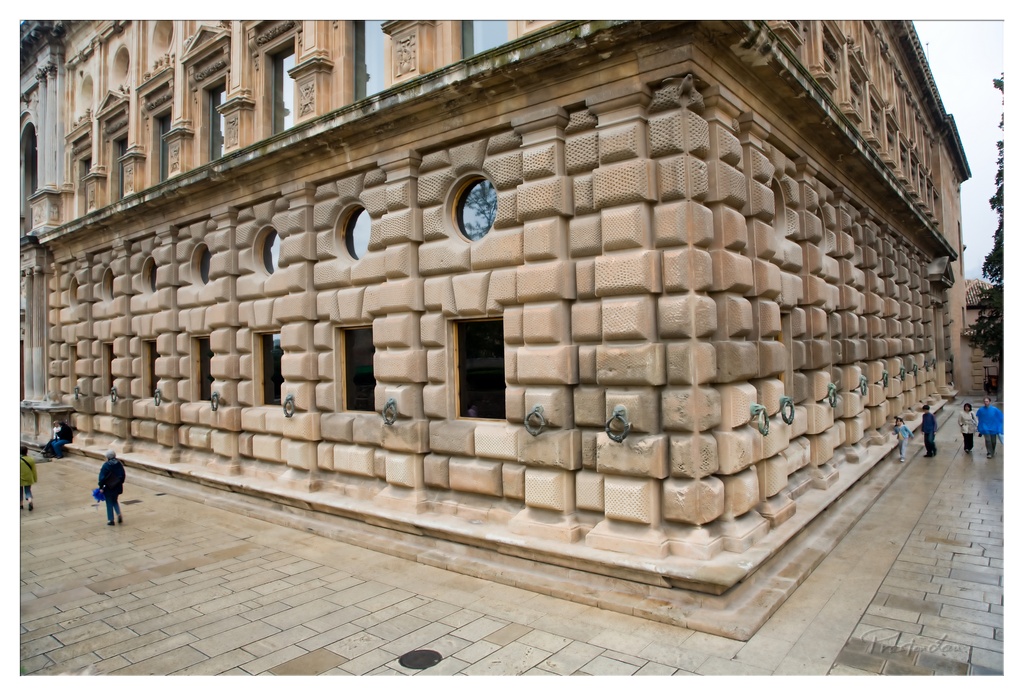

1. Overall Rating (0–10) — 7.0
This photograph captures the striking architectural contrast between the ornate, classical upper facade and the bold, textured lower wall of a historic building, creating a compelling visual dialogue between tradition and modernity. The use of human scale adds life to the scene, grounding the monumental structure in everyday reality. While the lighting is somewhat flat, the composition effectively emphasizes the building’s unique design, making it both informative and visually engaging.
2. Composition (0–10) — 7.5
The diagonal alignment of the building’s corner leads the eye through the frame, with the textured wall dominating the foreground. The inclusion of pedestrians provides scale and movement, enhancing the sense of place without distracting from the architectural focus.
3. Lighting (0–10) — 5.5
The overcast sky produces soft, diffused light that minimizes harsh shadows and allows the texture of the stone to be clearly visible. However, the lack of strong directional light results in a somewhat muted atmosphere, reducing the dramatic impact of the architecture.
4. Color & Tone (0–10) — 6.5
The palette is dominated by warm, earthy tones of beige and tan, which harmonize with the stone and pavement. While the colors are consistent and natural, the lack of vibrancy and contrast gives the image a subdued, almost monochromatic quality.
5. Creativity (0–10) — 7.0
The photograph successfully highlights an unusual architectural juxtaposition, blending historical and contemporary elements in a way that invites curiosity. The choice to frame the building at an angle adds visual interest and emphasizes its unique form.
6. Technical Quality (0–10) — 8.0
The image is sharp and well-focused, with fine detail visible in the stone texture and window frames. The exposure is balanced, and there are no significant technical flaws, though the lack of dynamic range limits tonal depth.
7. Emotional Impact (0–10) — 6.0
The image evokes a sense of quiet contemplation and architectural wonder, inviting the viewer to appreciate the craftsmanship and historical layers of the structure. While it does not elicit strong emotion, it effectively communicates the dignity and presence of the building in its urban context.
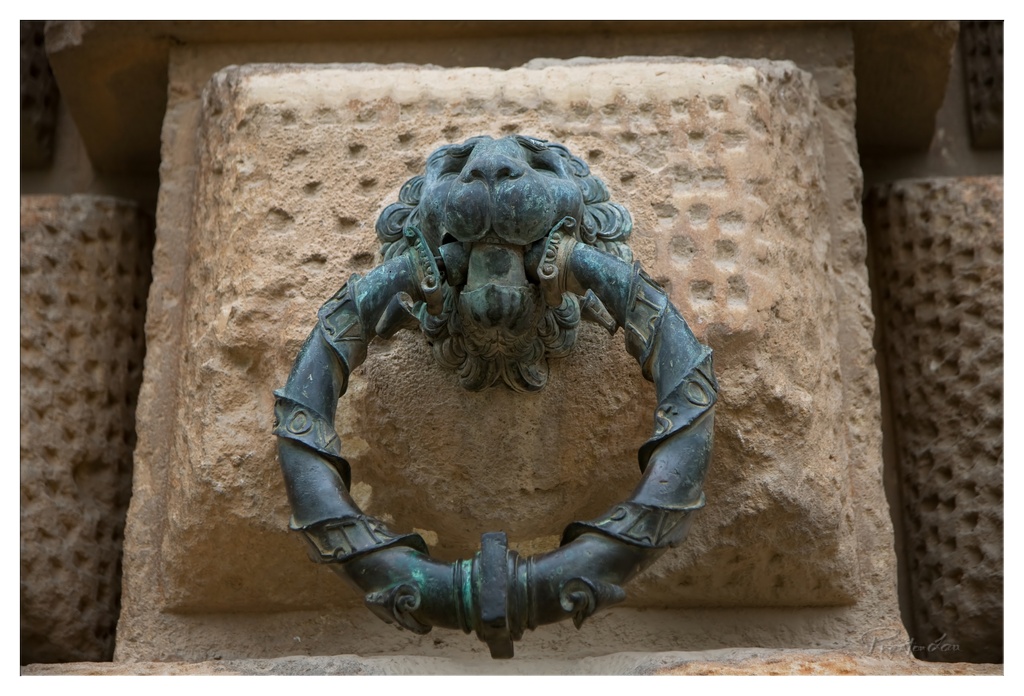

1. Overall Rating (0–10) — 7.5
This photograph captures the quiet dignity of a historic lion knocker, where age and craftsmanship converge in a single, weathered frame. The patina of the bronze and the texture of the stone create a tactile sense of time passed, while the centered composition lends the subject a stately presence. Though the image is visually rich, a touch more contrast and atmospheric depth could elevate its narrative weight beyond mere documentation.
2. Composition (0–10) — 8.0
The subject is perfectly centered, creating a balanced and symmetrical composition that draws the eye directly to the lion’s fierce visage. The surrounding stone texture provides natural framing, enhancing the sense of permanence and structure.
3. Lighting (0–10) — 6.5
Soft, diffused light highlights the knocker’s contours without harsh shadows, emphasizing texture and form. However, the lighting is somewhat flat, slightly muting the richness of the patina and reducing the image’s dramatic depth.
4. Color & Tone (0–10) — 7.0
The muted palette of verdigris green and warm stone tones evokes a sense of antiquity and resilience. The subtle color harmony supports the historical mood, though a slightly warmer cast could enhance the organic feel of the materials.
5. Creativity (0–10) — 7.5
The image transforms a mundane architectural detail into a characterful portrait, using framing and focus to elevate the knocker into a symbol of strength and endurance. The choice to isolate the subject from its surroundings demonstrates thoughtful storytelling.
6. Technical Quality (0–10) — 8.5
Sharp focus on the knocker ensures crisp detail, while a shallow depth of field gently blurs the background, enhancing subject isolation. The image is technically sound and well-executed.
7. Emotional Impact (0–10) — 7.0
There’s a quiet reverence in the image, inviting contemplation of history and craftsmanship. The lion’s open mouth and weathered expression evoke a sense of guardianship and silent watchfulness, creating a subtle emotional connection with the viewer.
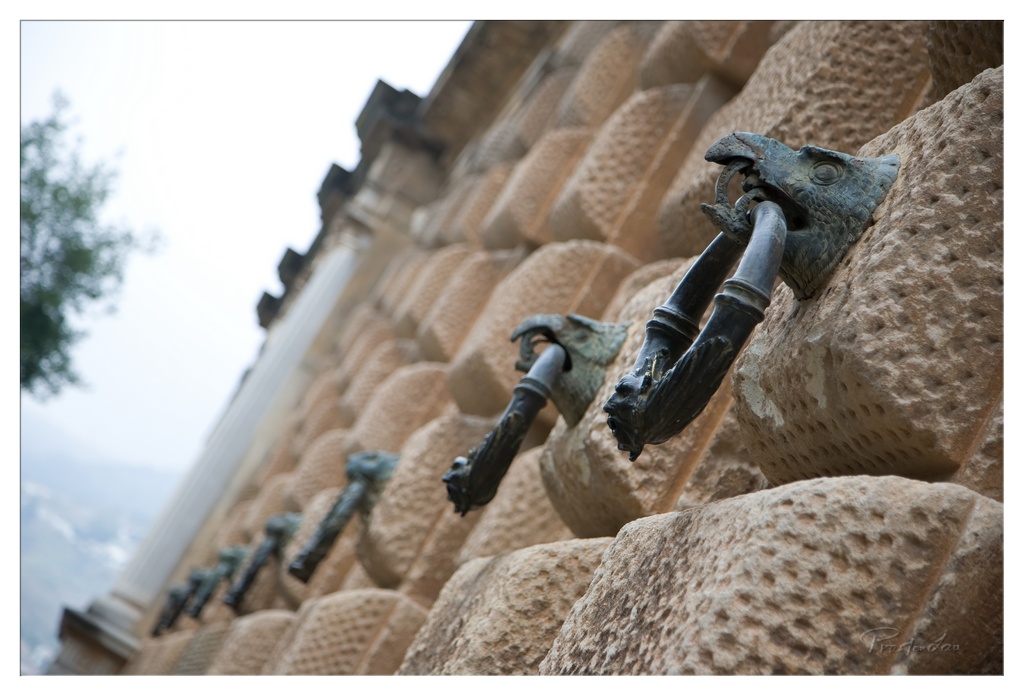

1. Overall Rating (0–10) — 7.0
This photograph captures the quiet grandeur of a historic stone façade, where weathered textures and ornate metal fixtures speak to time and craftsmanship. The diagonal line of the fountain spouts draws the eye through the frame, creating a sense of rhythm and depth, while the soft focus in the background adds a dreamy, almost nostalgic quality. The image’s strength lies in its ability to balance architectural detail with atmospheric subtlety, though the muted lighting tempers its overall impact.
2. Composition (0–10) — 7.5
The diagonal alignment of the spouts creates a strong leading line that guides the viewer through the frame. The low-angle perspective emphasizes the scale and texture of the stone, while the blurred background adds depth and isolates the subject.
3. Lighting (0–10) — 6.0
Diffuse, overcast light softens shadows and highlights the texture of the stonework without creating harsh contrasts. While the lighting is even and flattering, it lacks the warmth or drama that could enhance the mood.
4. Color & Tone (0–10) — 6.5
The palette is restrained, dominated by earthy beiges and muted metallics, which harmonize well with the aged materials. The lack of vibrant color limits visual excitement but reinforces the image’s historical and contemplative tone.
5. Creativity (0–10) — 7.0
The choice to focus on the repeating pattern of the spouts and the interplay of stone and metal is both thoughtful and visually engaging. The composition suggests a narrative of endurance and tradition, elevating a simple architectural detail into a poetic observation.
6. Technical Quality (0–10) — 7.5
The focus is sharp on the foreground elements, with a well-controlled depth of field that blurs the background effectively. The image is clean, with no noticeable noise or distortion, demonstrating solid technical execution.
7. Emotional Impact (0–10) — 6.5
The photograph evokes a sense of quiet reverence for the past, inviting contemplation of the craftsmanship and history embedded in the structure. While not emotionally overwhelming, it lingers with a subtle melancholy and beauty.
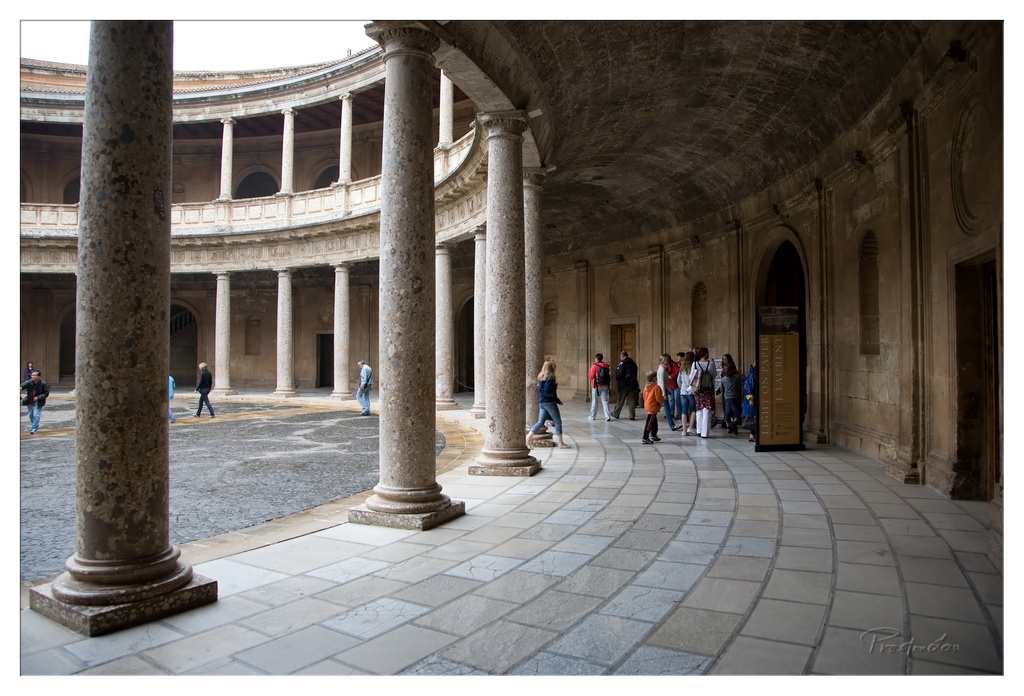

1. Overall Rating (0–10) — 7.5
This photograph captures the grandeur and quiet rhythm of a historic courtyard, where ancient stone columns and arched walkways speak of centuries of human passage. The composition draws the eye along the sweeping curve of the colonnade, emphasizing both architectural symmetry and the subtle presence of visitors as living echoes of the past. While the lighting is somewhat flat and the color palette restrained, the image succeeds in conveying a sense of timelessness and reverence, though it lacks the dramatic contrast or emotional punch that would elevate it into the realm of the truly iconic.
2. Composition (0–10) — 8.0
The curved colonnade creates a strong leading line that guides the viewer’s gaze through the space, while the placement of the foreground pillar anchors the frame. The balance between architectural elements and human figures adds scale and narrative depth.
3. Lighting (0–10) — 6.0
Diffuse, overcast light softens the scene, minimizing harsh shadows but also reducing textural contrast in the stone. The even illumination supports clarity but lacks the dynamic quality that could enhance mood.
4. Color & Tone (0–10) — 6.5
The palette is dominated by muted earth tones—beiges, grays, and soft browns—that reinforce the historical atmosphere. While cohesive, the lack of vibrancy or tonal range gives the image a slightly subdued appearance.
5. Creativity (0–10) — 7.0
The photographer captures a well-known architectural space with a respectful and observational approach, emphasizing rhythm and proportion. The inclusion of tourists grounds the scene in the present, offering a subtle commentary on the continuity of human experience.
6. Technical Quality (0–10) — 8.0
The image is sharp and well-focused, with clean details in the stonework and a clear sense of depth. The wide-angle perspective is handled effectively, avoiding excessive distortion.
7. Emotional Impact (0–10) — 7.0
The photograph evokes a contemplative stillness, inviting the viewer to imagine the stories embedded in the walls and arches. The quiet presence of people adds a human touch, fostering a sense of connection across time.
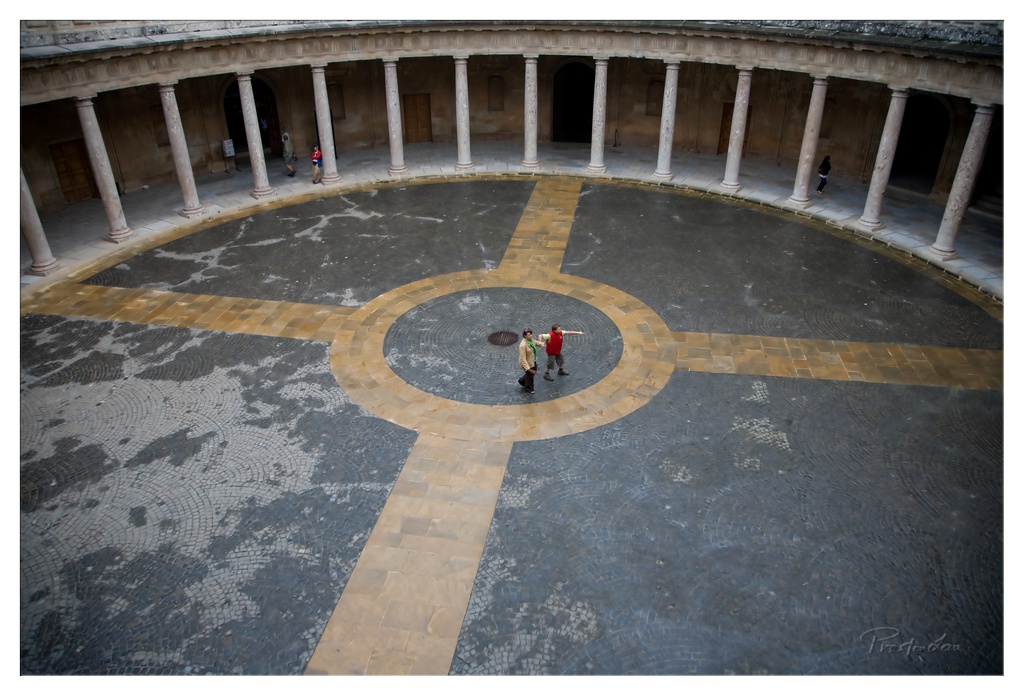

1. Overall Rating (0–10) — 7.5
This photograph captures the quiet grandeur of a historic cloister, where architectural symmetry meets human presence in a moment of contemplative stillness. The elevated vantage point emphasizes the geometric elegance of the courtyard, while the two figures at the center add a narrative thread—small yet meaningful—against the vast stone expanse. The image balances historical gravitas with subtle human warmth, though its subdued lighting and muted tones slightly temper its emotional pull.
2. Composition (0–10) — 8.0
The circular design of the courtyard creates a strong focal point, with the central figures perfectly placed at the convergence of the cross-shaped walkway. The high-angle perspective enhances the symmetry and depth, drawing the eye naturally from the outer colonnade to the heart of the space. The inclusion of distant figures along the colonnade adds scale and narrative, though the framing could be tighter to reduce visual clutter.
3. Lighting (0–10) — 6.0
The light is diffused and even, likely from an overcast sky, which softens shadows and allows the intricate floor patterns to be clearly visible. However, the lack of directional light or contrast diminishes the sense of depth and atmosphere, giving the scene a slightly flat, documentary quality rather than a dramatic or poetic one.
4. Color & Tone (0–10) — 6.5
The palette is composed of earthy, neutral tones—warm beiges, soft grays, and muted golds—that reflect the aged stone and contribute to the historical mood. While harmonious, the colors lack vibrancy and saturation, resulting in a subdued, almost monochromatic effect that limits the visual impact.
5. Creativity (0–10) — 7.0
The photograph demonstrates strong compositional awareness and a clear intent to highlight architectural beauty and human scale within a historical setting. The use of symmetry and perspective creates a visually engaging narrative, though the approach is more observational than experimental, limiting its originality.
6. Technical Quality (0–10) — 8.0
The image is sharp and well-focused, with excellent clarity in the intricate floor patterns and architectural details. The high resolution and clean execution support the photograph’s documentary and aesthetic aims, and the watermark is unobtrusive.
7. Emotional Impact (0–10) — 7.0
There’s a quiet contemplative mood, evoking a sense of timelessness and reverence for the space. The human figures, though small, invite viewers to imagine themselves within the cloister, creating a subtle emotional connection. The stillness of the scene resonates with a meditative calm, though the muted tones and lack of dynamic lighting keep the emotional response subdued.
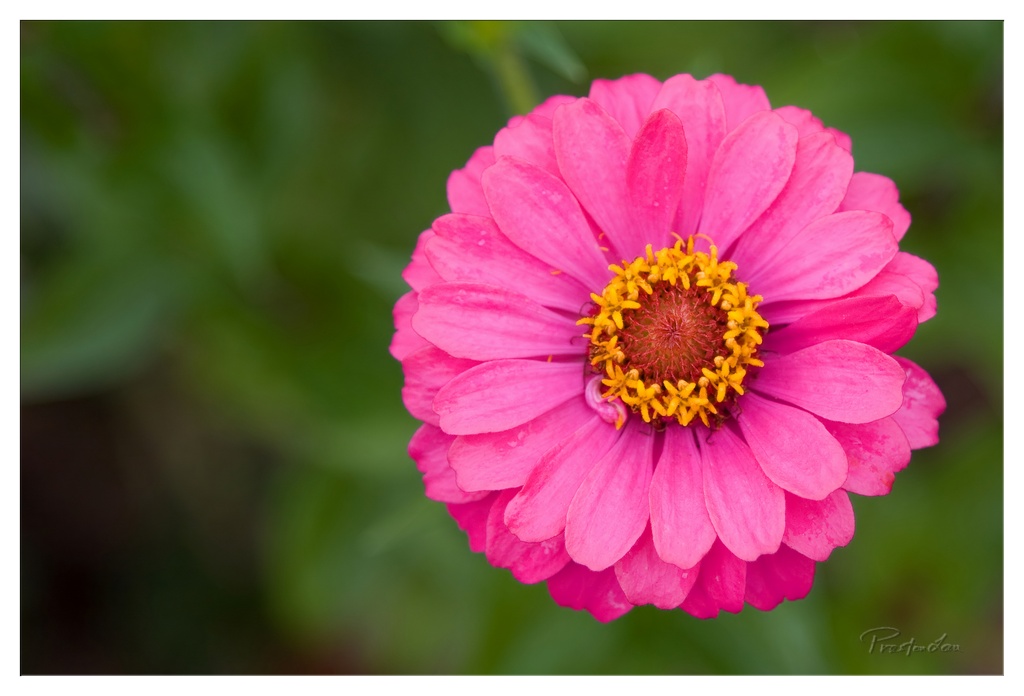

1. Overall Rating (0–10) — 8.0
This photograph captures the vibrant energy of a zinnia in full bloom, its vivid pink petals radiating warmth and life against a soft, blurred green backdrop. The composition draws the eye effortlessly to the flower’s intricate center, where the bright yellow stamens create a striking contrast. While the image is technically strong and emotionally inviting, its simplicity borders on conventional, leaving room for more narrative depth or dynamic tension.
2. Composition (0–10) — 7.5
The flower is slightly off-center, creating a gentle asymmetry that feels natural and organic. The use of a shallow depth of field isolates the subject beautifully, though a tighter crop could enhance intimacy and visual impact.
3. Lighting (0–10) — 8.0
Soft, diffused natural light highlights the texture and translucency of the petals without harsh shadows. The even illumination enhances the flower’s vividness and gives the image a calm, serene quality.
4. Color & Tone (0–10) — 9.0
The bold magenta of the petals contrasts beautifully with the golden-yellow center and the muted green background, creating a harmonious and visually striking palette. The tones are rich and saturated without appearing unnatural.
5. Creativity (0–10) — 7.0
While the subject is classic and the composition is skillfully executed, the approach is more observational than inventive. The image celebrates natural beauty in a familiar way, lacking a unique conceptual twist or unexpected perspective.
6. Technical Quality (0–10) — 9.0
The focus is sharp on the flower’s center, with smooth bokeh in the background. The image is clean, well-exposed, and shows excellent control over detail and depth.
7. Emotional Impact (0–10) — 8.5
The photograph evokes a sense of joy, vitality, and quiet wonder—qualities inherent in the beauty of a single bloom. It invites the viewer to pause and appreciate the delicate intricacy of nature, creating a moment of peaceful connection.
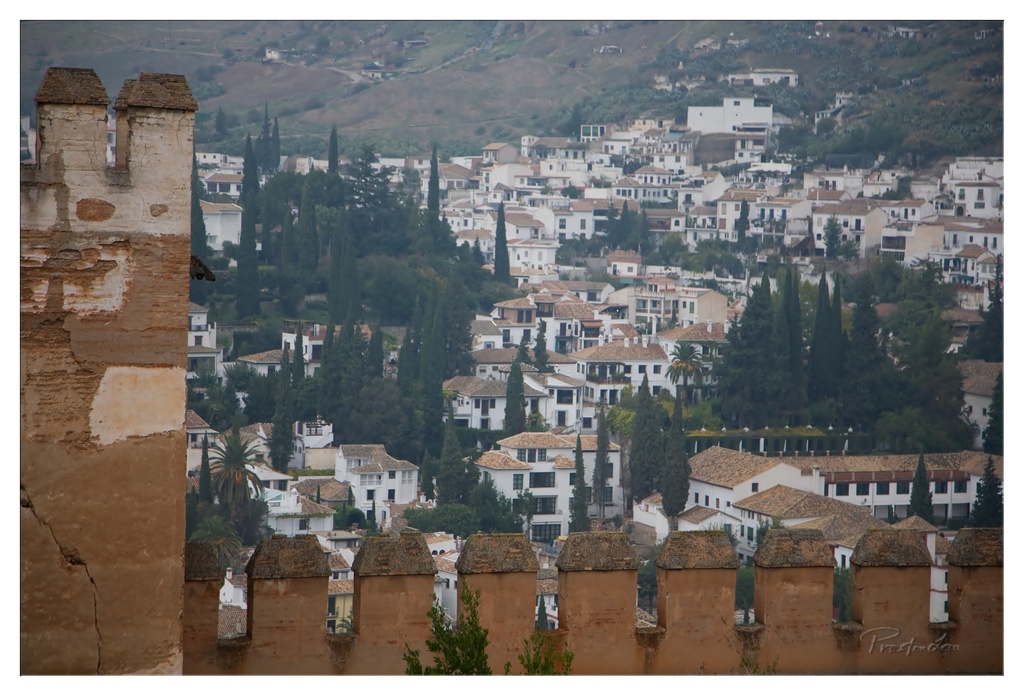

1. Overall Rating (0–10) — 7.0
This photograph captures the timeless elegance of a Mediterranean hillside town, viewed from the historic ramparts of a fortress. The weathered stone in the foreground grounds the image in history, while the white-washed buildings and lush greenery create a harmonious contrast that speaks to the region’s cultural and natural beauty. The slightly overcast lighting lends a soft, contemplative mood, though the image’s potential for greater vibrancy is slightly restrained by its muted palette.
2. Composition (0–10) — 7.5
The crenellated wall in the foreground creates a strong framing device, guiding the eye into the expansive town below. The diagonal line of the battlements adds visual rhythm, while the placement of the ancient tower on the left balances the composition and reinforces the sense of depth.
3. Lighting (0–10) — 6.0
The diffused, overcast light softens shadows and evenly illuminates the scene, creating a calm, atmospheric quality. However, the lack of direct sunlight diminishes the texture and warmth of the buildings and foliage, resulting in a slightly flat appearance.
4. Color & Tone (0–10) — 6.5
The palette is dominated by earthy terracotta, muted greens, and soft whites, which harmonize well but lack vivid contrast. The overall tone is subdued, emphasizing mood over vibrancy, which suits the contemplative nature of the scene.
5. Creativity (0–10) — 7.0
The choice to frame the view through the ancient fortifications adds a narrative layer, suggesting a dialogue between past and present. The perspective invites the viewer to imagine the history unfolding from this vantage point, giving the image a thoughtful, almost cinematic quality.
6. Technical Quality (0–10) — 7.5
The image is sharp and well-focused, with clear detail in both the foreground and background. The depth of field is appropriately managed, allowing the viewer to take in the full scope of the landscape without distraction.
7. Emotional Impact (0–10) — 7.0
There’s a quiet sense of nostalgia and timelessness in the image, evoking a feeling of peaceful observation from a place of historical significance. The viewer is drawn into a moment of stillness, as if pausing to reflect on the layers of history beneath the sun-drenched rooftops.
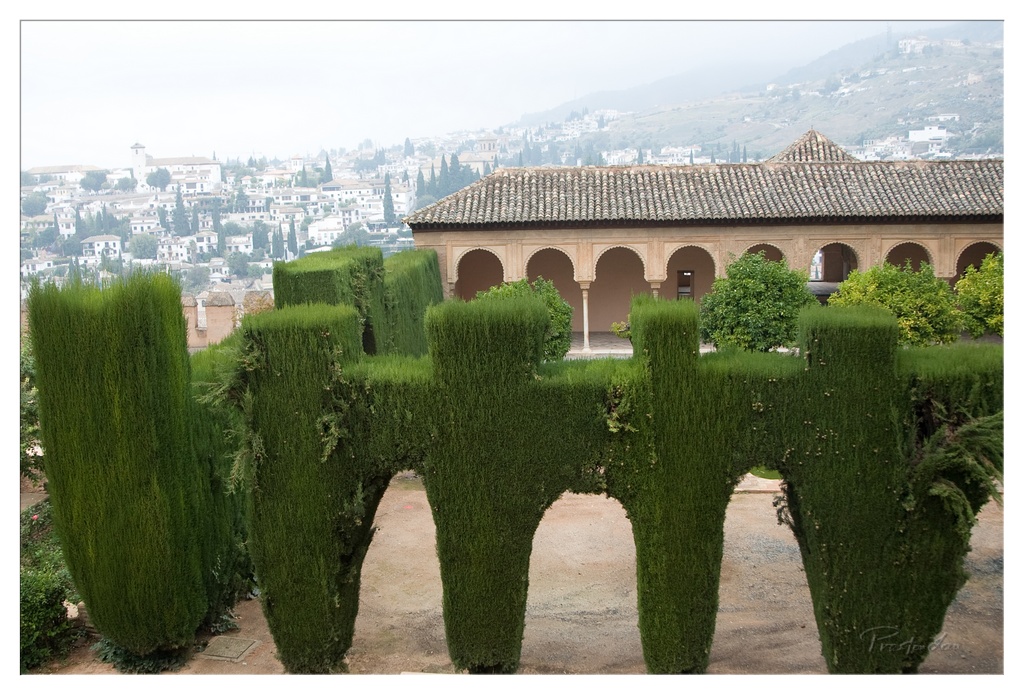

1. Overall Rating (0–10) — 7.0
This photograph captures the serene grandeur of the Alhambra’s gardens, where disciplined horticulture meets historical elegance. The sculpted hedges in the foreground create a rhythmic, almost architectural frame, drawing the eye toward the arched colonnade and the sprawling city beyond. While the overcast sky tempers the vibrancy of the scene, the image succeeds in conveying a sense of timelessness and quiet contemplation, though it feels slightly restrained by its muted atmosphere.
2. Composition (0–10) — 7.5
The layered composition—hedges in the foreground, colonnade in the midground, and cityscape in the background—creates depth and visual interest. The arching hedges act as a natural frame, guiding the viewer’s gaze toward the central structure, though the slight asymmetry in the hedge formation slightly disrupts balance.
3. Lighting (0–10) — 5.5
Diffuse, overcast light flattens the scene, reducing shadows and depth. While it evenly illuminates the hedges and architecture, the lack of directional light diminishes texture and atmosphere, giving the image a subdued, almost melancholic quality.
4. Color & Tone (0–10) — 6.0
The dominant green of the hedges is rich but somewhat desaturated due to the lighting, while the earthy tones of the building and distant city are muted. The overall palette feels restrained, with limited contrast between the elements, contributing to a soft, hazy effect.
5. Creativity (0–10) — 7.0
The use of the sculpted hedges as a framing device is inventive and echoes the architectural symmetry of the Alhambra. The juxtaposition of natural and man-made forms, along with the expansive view, offers a thoughtful narrative about place, history, and design.
6. Technical Quality (0–10) — 7.5
The image is sharp and well-focused, with clear detail in the foliage and architecture. The exposure is balanced, and the noise level is low, indicating strong technical execution despite the challenging lighting conditions.
7. Emotional Impact (0–10) — 6.5
The photograph evokes a sense of calm and reflection, inviting the viewer to pause and absorb the layered beauty of the site. While the mood is contemplative, the lack of dramatic lighting or color limits its emotional resonance, leaving the viewer with a quiet impression rather than a powerful emotional punch.
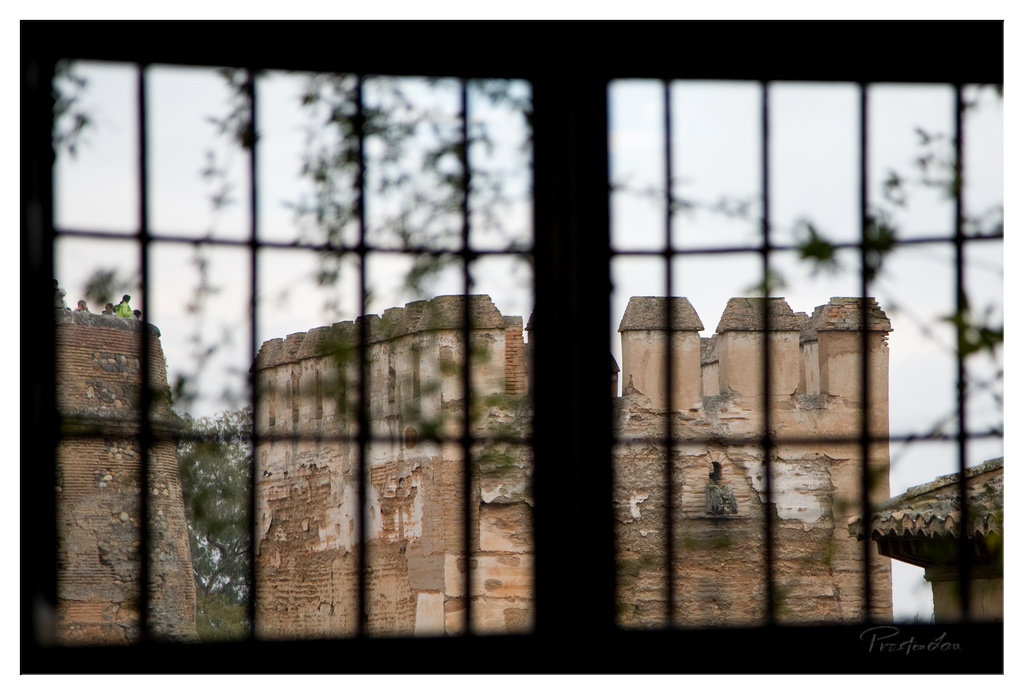

1. Overall Rating (0–10) — 7.0
This photograph captures a contemplative view of ancient stone towers framed by a dark, grid-like window, evoking a sense of timelessness and confinement. The interplay of the rigid bars and the weathered architecture creates a layered narrative of history and observation. While the mood is compelling and the framing intentional, the slightly overexposed sky and muted tones temper the image’s emotional depth, leaving it just short of transcendent.
2. Composition (0–10) — 7.5
The window’s grid acts as a strong structural frame, guiding the eye toward the castle towers while creating a sense of separation between viewer and subject. The off-center placement of the towers adds visual interest, though the right side feels slightly more weighted than the left.
3. Lighting (0–10) — 6.0
The soft, diffused light enhances the texture of the stone, but the overexposed sky lacks detail and drains contrast from the upper portion of the frame. The dark bars absorb light, creating a stark contrast that emphasizes the grid’s dominance.
4. Color & Tone (0–10) — 6.5
The palette is restrained, dominated by earthy browns and grays, with a pale, washed-out sky. While the tonal harmony is cohesive, the lack of vibrancy gives the image a muted, almost melancholic feel.
5. Creativity (0–10) — 7.5
The use of the window as a framing device is both literal and metaphorical, suggesting themes of confinement, history, and perspective. The inclusion of faint foliage adds a touch of life, subtly bridging the ancient and the natural.
6. Technical Quality (0–10) — 7.0
The focus is sharp on the central structure, and the depth of field is well-managed, allowing the bars to remain distinct while still letting the towers show detail. The image is clean, with minimal noise.
7. Emotional Impact (0–10) — 7.0
The photograph evokes a quiet introspection, inviting the viewer to reflect on time, memory, and the passage of history. The framing creates a sense of looking from within, enhancing the emotional resonance of solitude and observation.
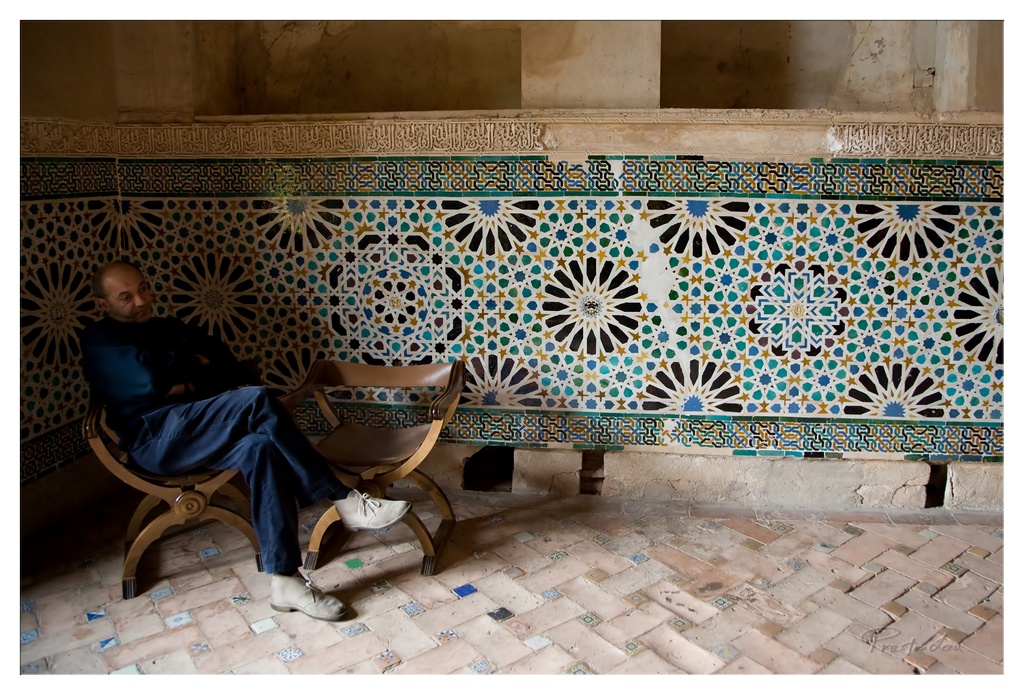

1. Overall Rating (0–10) — 7.5
This photograph captures a quiet, contemplative moment within a space rich with cultural and architectural detail, where the juxtaposition of the solitary figure against the ornate tilework creates a compelling narrative of presence and place. The warm, earthy tones and the intricate patterns lend a sense of timelessness, while the man’s relaxed posture adds a human element that grounds the scene. Though the lighting and framing are somewhat restrained, the image succeeds in evoking a meditative stillness and invites the viewer to linger in its quiet elegance.
2. Composition (0–10) — 7.0
The man is positioned off-center, creating a balanced yet dynamic composition that draws the eye across the frame. The expansive tile wall dominates the background, providing a rich visual texture that contrasts with the simplicity of the subject. The low angle and slight depth of field help to frame the subject within his environment, though the composition could benefit from tighter cropping to enhance focus.
3. Lighting (0–10) — 6.5
Natural light enters from the left, casting soft shadows that accentuate the texture of the tiles and the contours of the man’s form. The lighting is even and natural, enhancing the warmth of the scene without creating harsh contrasts. However, the shadows on the floor and the right side of the frame suggest a slightly underexposed moment, slightly diminishing the richness of the colors.
4. Color & Tone (0–10) — 8.0
The palette is rich and harmonious, with deep blues, greens, and golds in the tilework creating a vibrant contrast against the muted terracotta floor and the man’s dark clothing. The colors are warm and saturated, lending a sense of authenticity and cultural depth. The tonal range is well-balanced, allowing the intricate patterns to stand out without overwhelming the composition.
5. Creativity (0–10) — 7.5
The image demonstrates a strong sense of place and narrative, capturing the quiet dignity of a person in a space of historical and artistic significance. The fusion of human presence with elaborate architecture suggests a story of continuity and belonging. While not overtly experimental, the approach is thoughtful and evocative, emphasizing atmosphere over action.
6. Technical Quality (0–10) — 8.0
The image is sharp and clear, with fine detail visible in both the tilework and the textures of the man’s clothing. The focus is well-managed, and the depth of field is appropriate for the scene. The color balance and exposure are largely accurate, with only minor loss of detail in the shadows.
7. Emotional Impact (0–10) — 7.0
The photograph conveys a sense of calm and introspection, inviting the viewer to reflect on the relationship between people and the spaces they inhabit. The man’s composed demeanor and the serene setting create a mood of quiet contemplation, though the emotional resonance is somewhat tempered by the distance created by the composition.
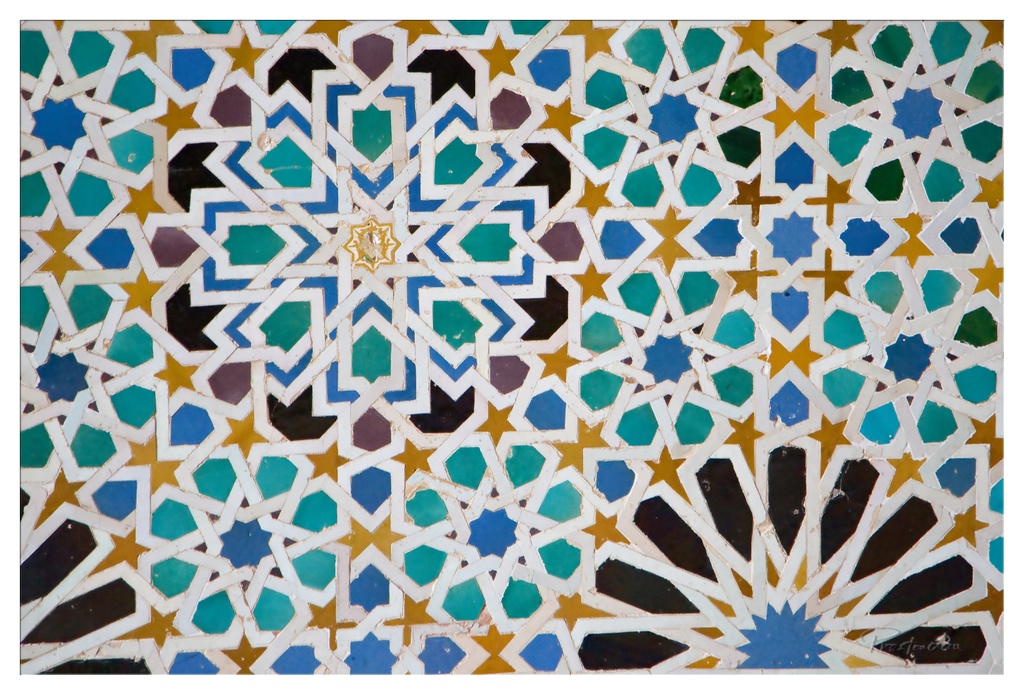

1. Overall Rating (0–10) — 8.0
This photograph captures the intricate beauty of traditional Islamic tilework, where geometry and color converge into a mesmerizing visual rhythm. The composition draws the eye into a kaleidoscopic dance of star and polygonal motifs, evoking a sense of timeless craftsmanship. While the image excels in pattern and detail, its full potential is slightly restrained by the absence of a strong focal point or narrative context.
2. Composition (0–10) — 7.5
The symmetrical layout centers the most elaborate motif, creating a natural focal point. However, the repetition of patterns across the frame results in a visually busy composition that risks overwhelming the viewer, with no clear narrative or leading line to guide the eye.
3. Lighting (0–10) — 7.0
The lighting is even and diffuse, allowing the colors and details of the tiles to emerge clearly without harsh shadows. The subtle variations in tone across the surface enhance the three-dimensional quality of the mosaic, though a touch more contrast would add depth.
4. Color & Tone (0–10) — 8.5
The rich palette of turquoise, gold, black, and white creates a harmonious and visually striking contrast. The warm gold tones punctuate the cooler blues and greens, adding vibrancy and a sense of warmth that elevates the overall aesthetic.
5. Creativity (0–10) — 8.0
The image showcases a strong appreciation for cultural artistry, with a focus on symmetry and pattern that feels both traditional and artistically compelling. The photographer’s choice to emphasize the complexity of the design rather than a singular subject reflects a thoughtful, contemplative approach.
6. Technical Quality (0–10) — 9.0
The photograph is sharp and well-focused, capturing the fine details of the mosaic with clarity. The white grout lines are crisp, and the image is free of noticeable digital noise or distortion, indicating high technical execution.
7. Emotional Impact (0–10) — 7.5
The image evokes a sense of awe and reverence for craftsmanship, inviting quiet contemplation. While it doesn’t elicit strong emotion, the visual richness and cultural depth create a meditative and immersive experience.
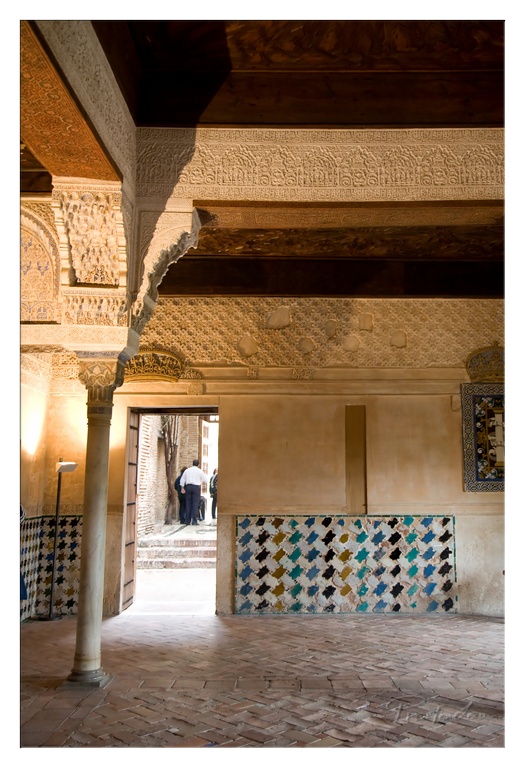

1. Overall Rating (0–10) — 7.5
This photograph captures the quiet grandeur of an Andalusian courtyard, where intricate stonework and vibrant tilework speak to centuries of artistic refinement. The interplay of light and shadow through the archway enhances the architectural depth, while the distant figures add a subtle sense of scale and life. Though the composition is strong, a slightly more deliberate framing could elevate the image from a mere document to a more contemplative portrait of space and history.
2. Composition (0–10) — 7.0
The archway acts as a natural frame, drawing the eye into the depth of the courtyard and guiding attention toward the figures beyond. The diagonal of the tiled wall and the leading lines of the floor tiles create a dynamic sense of movement, though the off-center placement of the column slightly disrupts balance.
3. Lighting (0–10) — 8.0
Soft, directional light filters through the opening, casting deep shadows that accentuate the texture of the carved stonework and the warm tones of the terracotta floor. The contrast between light and shadow enhances the three-dimensionality of the space, creating a dramatic and inviting atmosphere.
4. Color & Tone (0–10) — 7.5
The earthy palette of ochre and beige walls is beautifully complemented by the vibrant blue, green, and black mosaic tiles, which provide a striking visual anchor. The warm tones of the terracotta and wood enhance the Mediterranean feel, while the overall tonal range remains rich and balanced.
5. Creativity (0–10) — 7.0
The image captures the essence of Moorish architecture with authenticity and respect, using natural light and composition to highlight the intricate details. While not overtly experimental, the choice to include the human element adds a narrative layer, inviting viewers to imagine themselves in the space.
6. Technical Quality (0–10) — 8.5
Sharp focus throughout the frame ensures that both the foreground details and distant elements are clear. The exposure is well-managed, preserving detail in both the bright doorway and the shadowed recesses, with minimal noise.
7. Emotional Impact (0–10) — 8.0
The image evokes a sense of timelessness and reverence, inviting quiet reflection on the craftsmanship and cultural legacy embedded in the architecture. The presence of people adds a human touch, grounding the grandeur in relatable experience and enhancing the viewer's emotional connection to the space.
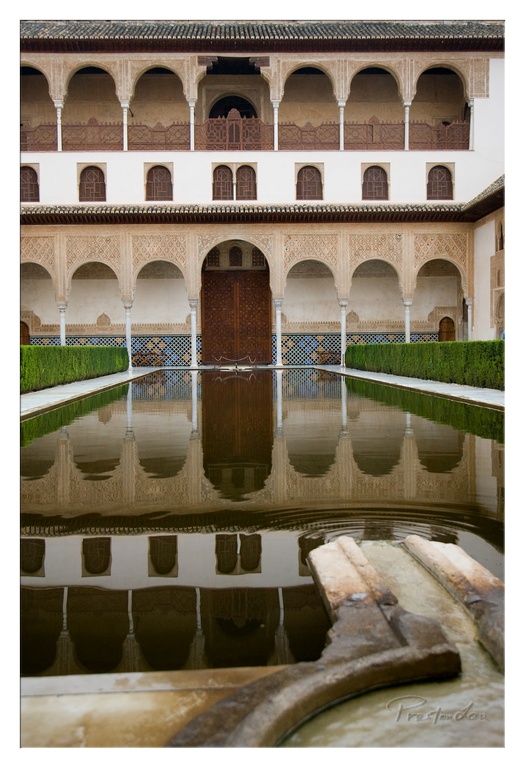

1. Overall Rating (0–10) — 8.0
This photograph captures the serene symmetry and architectural grandeur of a Moorish courtyard, where reflection and geometry converge in a moment of quiet harmony. The still water acts as a perfect mirror, doubling the intricate arches and tilework, while the low perspective draws the viewer into the scene with immersive depth. Though the image is technically strong and visually balanced, its restrained color palette and formal composition limit its emotional immediacy, offering elegance over intimacy.
2. Composition (0–10) — 9.0
The image is masterfully composed with strong symmetry, centered framing, and a low-angle perspective that emphasizes the receding lines of the courtyard and its reflection. The foreground stone edge and hedges guide the eye toward the central doorway, creating a natural visual path.
3. Lighting (0–10) — 8.0
Soft, diffused daylight enhances the texture of the stonework and tiles without harsh shadows, allowing the intricate details to emerge. The calm surface of the water reflects the architecture with clarity, indicating ideal lighting conditions for capturing reflections.
4. Color & Tone (0–10) — 7.0
The palette is restrained, dominated by earthy beiges, muted greens, and deep browns, which lend a timeless, contemplative mood. The blue tile accents provide subtle contrast, but the overall tonal range is slightly flat, reducing the vibrancy of the scene.
5. Creativity (0–10) — 8.0
The photographer leverages symmetry and reflection to transform a familiar architectural space into a meditative visual experience. The choice of low angle and tight framing elevates the subject beyond mere documentation, creating a contemplative and almost spiritual atmosphere.
6. Technical Quality (0–10) — 9.0
Sharp focus across the frame, precise exposure, and excellent clarity in both the architecture and its reflection demonstrate high technical control. The image is clean, well-framed, and free of distracting artifacts.
7. Emotional Impact (0–10) — 7.5
The image evokes a sense of peace, timelessness, and reverence for tradition. The stillness of the water and the quiet symmetry invite introspection, though the distance of the subject from the viewer tempers the emotional connection.
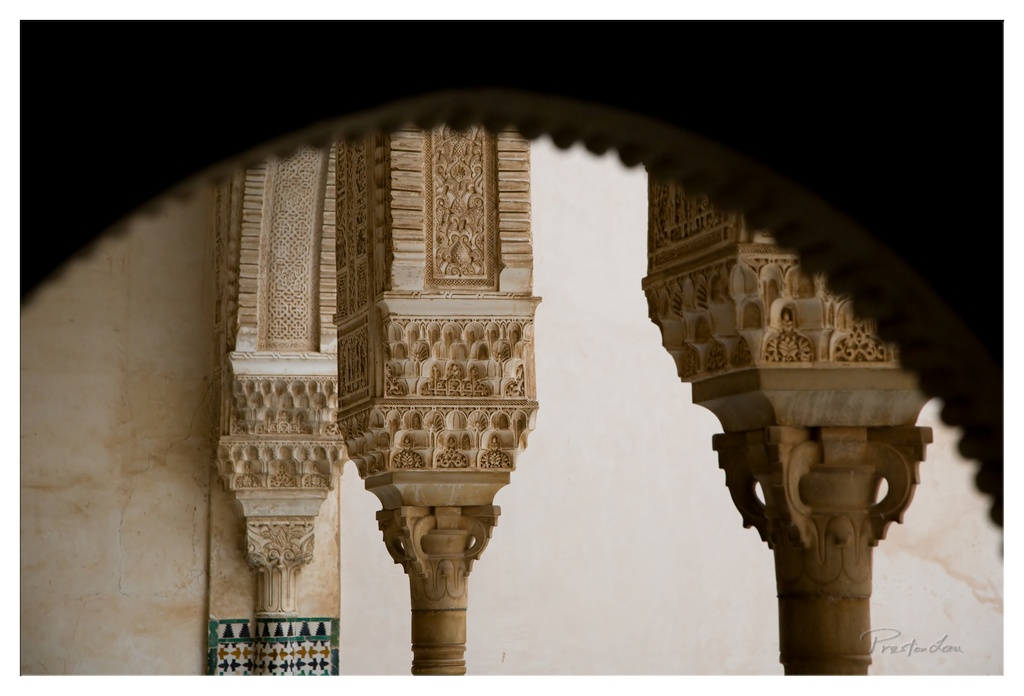

1. Overall Rating (0–10) — 8.0
This photograph captures the quiet grandeur of Moorish architecture with a masterful sense of depth and reverence. The framing through the dark arch creates a natural vignette, drawing the eye to the intricate carvings and rhythmic columns that speak to centuries of craftsmanship. While the composition is strong and the subject rich in detail, the lighting's flatness slightly tempers the image’s atmospheric potential, leaving it just shy of transcendent.
2. Composition (0–10) — 8.5
The arch frames the scene perfectly, creating a layered, almost theatrical view that emphasizes the symmetry and repetition of the columns. The placement of the central column slightly off-center adds visual interest, while the negative space enhances the sense of depth.
3. Lighting (0–10) — 6.5
The light is even and soft, revealing the texture of the stonework without harsh shadows. However, the lack of directional contrast diminishes the three-dimensionality of the carvings, giving the scene a slightly flat appearance.
4. Color & Tone (0–10) — 7.5
The warm, earthy tones of the stone are rendered with rich subtlety, complemented by the cool green and blue tile accents. The tonal range is balanced, though a touch more vibrancy in the tilework could have heightened the visual drama.
5. Creativity (0–10) — 8.0
The use of the arch as a framing device is both elegant and effective, transforming a static architectural study into a narrative moment. The photographer’s choice to isolate the columns within the frame imbues the image with a contemplative, almost sacred quality.
6. Technical Quality (0–10) — 8.0
The image is sharp and well-focused, with fine detail visible in the stonework. The exposure is clean, and the composition is technically sound, though minor post-processing could enhance contrast and depth.
7. Emotional Impact (0–10) — 7.5
The photograph evokes a sense of awe and timelessness, inviting the viewer to pause and reflect on the artistry and history embedded in the structure. The quiet stillness of the scene resonates with a deep cultural dignity.
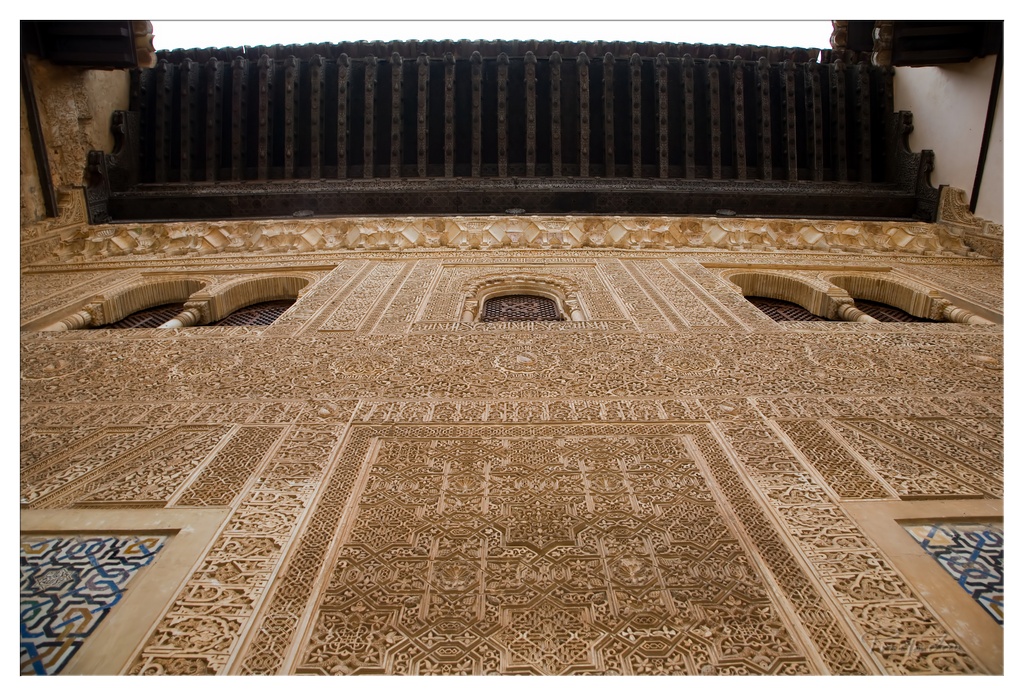

1. Overall Rating (0–10) — 8.0
This photograph captures the breathtaking intricacy of Moorish architecture with a reverent stillness, allowing the viewer to absorb the weight of history and artistry. The low-angle perspective emphasizes the grandeur of the carved stonework, while the deep, shadowed arches and ornate lattice above create a sense of vertical ascension. While the image’s technical clarity is strong, the lack of human presence keeps it from fully conveying the lived experience of the space—though this may be intentional, it slightly limits its emotional reach.
2. Composition (0–10) — 8.5
The low-angle view creates a powerful sense of scale and symmetry, drawing the eye upward along the intricate carvings. The central arch and repeating geometric patterns guide the viewer’s gaze through the frame, while the framing of the upper balcony adds architectural balance and depth.
3. Lighting (0–10) — 7.0
Natural light from above softly illuminates the stonework, enhancing the texture and depth of the carvings. However, the shadows beneath the balcony and in the recessed arches are slightly underexposed, obscuring some detail and creating a contrast that feels more dramatic than illuminating.
4. Color & Tone (0–10) — 8.0
The warm, earthy tones of the stone create a harmonious palette, complemented by the subtle blue and white tilework in the corners. The tonal range is rich, with a balanced contrast that highlights the craftsmanship without appearing oversaturated or unnatural.
5. Creativity (0–10) — 8.5
The choice of perspective and focus on pattern and repetition reflects a deep appreciation for architectural detail. The image transforms a static structure into a visual meditation on rhythm, geometry, and cultural legacy, offering a fresh yet respectful interpretation of a well-documented space.
6. Technical Quality (0–10) — 8.0
Sharp focus across the frame ensures the delicate carvings are rendered with clarity. The exposure is well-managed, though the darker areas could benefit from slight recovery to reveal more detail in the shadows.
7. Emotional Impact (0–10) — 7.5
The image evokes a sense of awe and reverence, inviting quiet contemplation. While the absence of people creates a timeless stillness, it also distances the viewer—this is less a moment of human experience and more a tribute to architectural splendor, which, while beautiful, feels slightly detached.
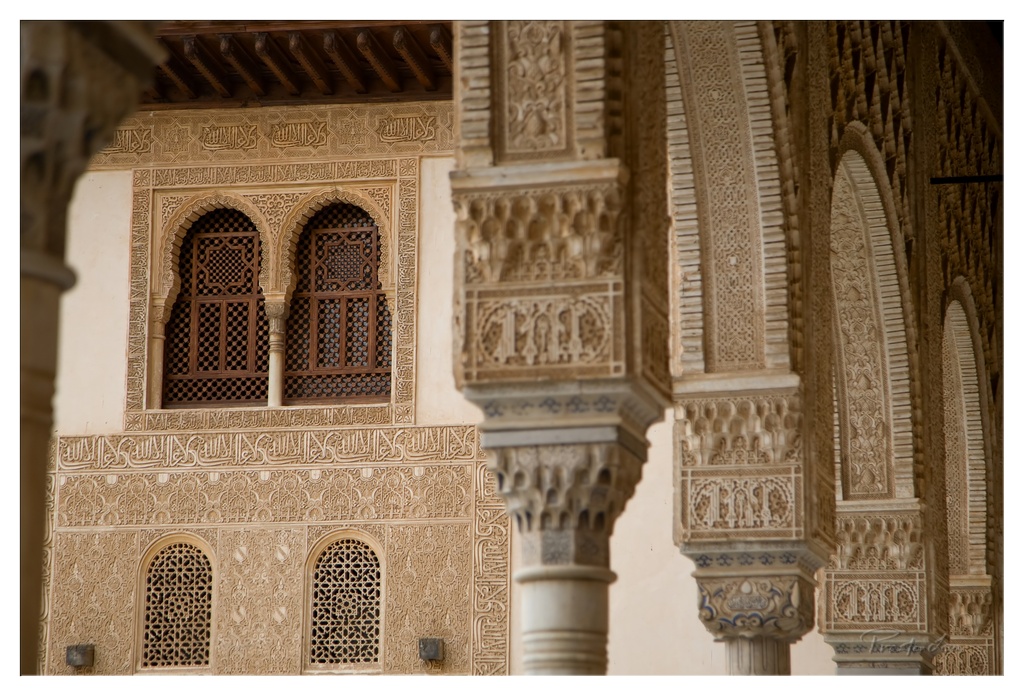

1. Overall Rating (0–10) — 8.0
This photograph captures the intricate elegance of Moorish architecture with a sense of reverence and stillness, drawing the viewer into a world of ornate detail and historical depth. The layered composition and warm, earthy tones evoke a meditative atmosphere, though the slightly soft focus in parts tempers its overall impact. The image succeeds in conveying both the grandeur and the quiet intimacy of the space, making it a compelling visual narrative.
2. Composition (0–10) — 8.5
The layered framing through arches and columns creates a strong sense of depth and perspective, guiding the eye naturally toward the central window. The balance between foreground and background elements is well-managed, with the architectural repetition adding rhythm and visual harmony.
3. Lighting (0–10) — 7.5
Soft, diffused light enhances the textures of the stonework and carvings without harsh shadows, allowing the intricate details to emerge naturally. The subtle gradient of light across the walls adds dimension and a sense of quiet timelessness.
4. Color & Tone (0–10) — 8.0
The warm, sandy tones of the stone are complemented by the deep brown of the wooden latticework, creating a cohesive and inviting palette. The restrained use of color emphasizes texture and form, while the subtle blue accents in the tilework provide a delicate contrast.
5. Creativity (0–10) — 8.5
The photographer’s choice to frame the scene through arches and columns transforms a static architectural view into a layered, almost painterly composition. The focus on pattern and rhythm, rather than a single focal point, reflects a thoughtful and expressive approach to documenting cultural heritage.
6. Technical Quality (0–10) — 7.5
Sharp focus is maintained on the central architectural details, though the edges of the frame show slight softness, likely due to lens depth or post-processing. The exposure is well-balanced, with no blown highlights or lost shadows.
7. Emotional Impact (0–10) — 8.0
The image evokes a sense of awe and tranquility, inviting contemplation of the craftsmanship and history embedded in the structure. The stillness of the scene resonates with a quiet dignity, allowing the viewer to feel a personal connection to the space.
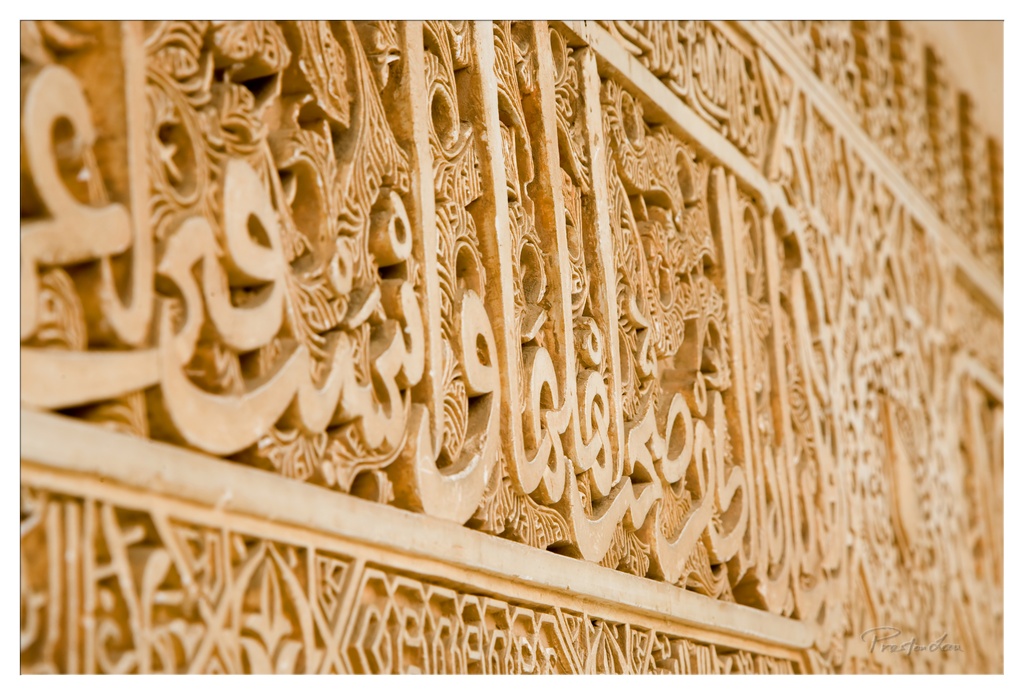

1. Overall Rating (0–10) — 8.0
This photograph captures the intricate beauty of Islamic calligraphy and geometric ornamentation with a reverence that feels both intimate and grand. The warm, golden light enhances the texture and depth of the stone carvings, inviting the viewer to trace the flowing script with their eyes. While the shallow depth of field creates a dreamlike softness, it slightly obscures the full complexity of the craftsmanship, holding back a more complete appreciation of the artistry.
2. Composition (0–10) — 8.0
The diagonal sweep of the calligraphy guides the eye through the frame with a natural rhythm, creating a sense of movement across the stone surface. The tight cropping emphasizes detail while maintaining a balanced composition, though the absence of contextual framing limits the sense of scale and place.
3. Lighting (0–10) — 9.0
Warm, directional light enhances the relief of the carvings, casting subtle shadows that accentuate the three-dimensional quality of the inscriptions. The softness of the light adds a meditative glow, evoking a sense of timelessness and sacred stillness.
4. Color & Tone (0–10) — 8.5
The monochromatic palette of warm beige and golden tones is harmonious and evocative, reinforcing the ancient and spiritual character of the subject. The tonal range is rich yet restrained, allowing the texture of the stone to remain the focal point.
5. Creativity (0–10) — 8.0
The photographer’s choice to focus on the interplay between script and shadow reveals a deep respect for the cultural and artistic significance of the work. The image transcends mere documentation, offering a contemplative interpretation of sacred geometry and language.
6. Technical Quality (0–10) — 8.5
Sharp focus on the central calligraphy, paired with a smooth depth of field, demonstrates precise control. The fine detail in the carving is captured clearly, and the image is free of distracting artifacts or noise.
7. Emotional Impact (0–10) — 8.5
The photograph evokes a quiet sense of awe and reverence, drawing the viewer into a moment of stillness and reflection. The beauty of the craftsmanship and the warmth of the light combine to create a deeply resonant, almost spiritual experience.
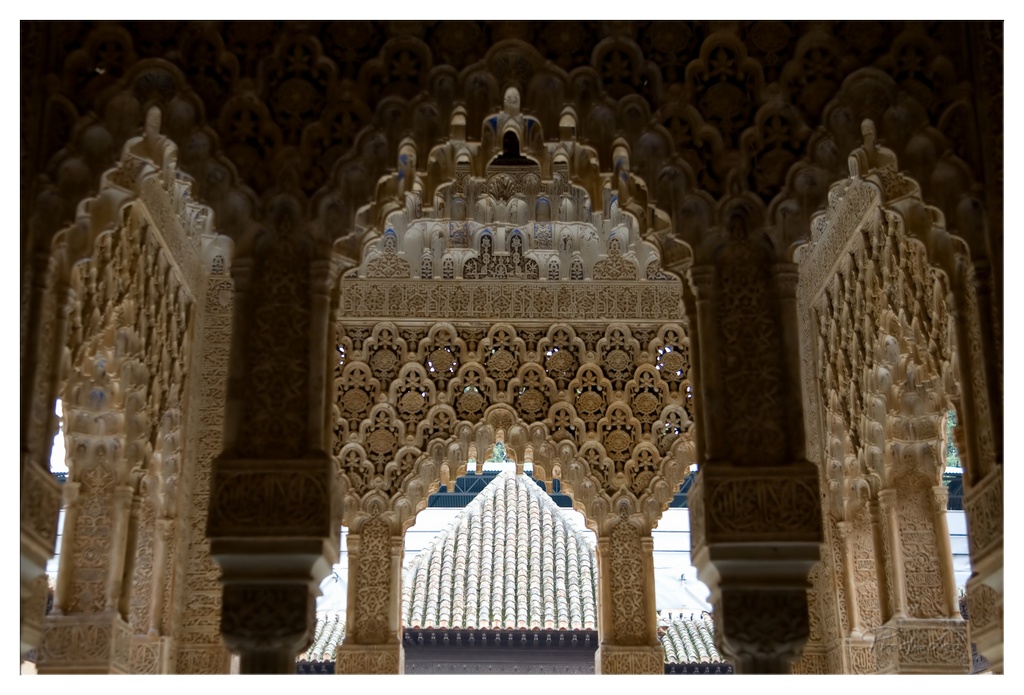

1. Overall Rating (0–10) — 8.0
This photograph captures the breathtaking intricacy of Moorish architecture, where light and shadow dance across layers of carved stonework to reveal a world of ornate detail. The framing through the arches creates a powerful sense of depth and discovery, drawing the viewer into the heart of the structure. While the low-light conditions lend a somber tone, the image succeeds in conveying both the grandeur and intimacy of the space, though a touch more brightness might better highlight the craftsmanship.
2. Composition (0–10) — 8.5
The layered arches create a natural frame that guides the eye toward the central dome, emphasizing symmetry and depth. The repetition of patterns and diminishing scale enhance the sense of perspective, making the composition feel both balanced and dynamic.
3. Lighting (0–10) — 7.0
The interplay of light and shadow enhances the texture of the carvings, with soft light filtering in from above to accentuate the three-dimensional quality of the stonework. However, the overall darkness in the foreground slightly obscures details and reduces the image’s luminous quality.
4. Color & Tone (0–10) — 7.5
The warm, earthy tones of the stone create a cohesive and harmonious palette, enhanced by subtle hints of blue and white in the background tiles. The tonal contrast between light and shadow adds depth, though the muted saturation slightly dampens the visual impact.
5. Creativity (0–10) — 8.0
The photographer’s choice to frame the shot through the arches introduces a narrative element—inviting the viewer to step through and explore. This perspective transforms a static architectural detail into a moment of visual storytelling.
6. Technical Quality (0–10) — 8.0
The image is sharp and well-focused, with fine detail visible in the carvings. The exposure is well-handled despite the challenging lighting conditions, though slight noise in the shadows suggests a higher ISO was used.
7. Emotional Impact (0–10) — 8.5
The photograph evokes a sense of awe and reverence, capturing the quiet majesty of a sacred space. The layered composition and intricate detail invite contemplation, allowing the viewer to feel the weight of history and artistry.
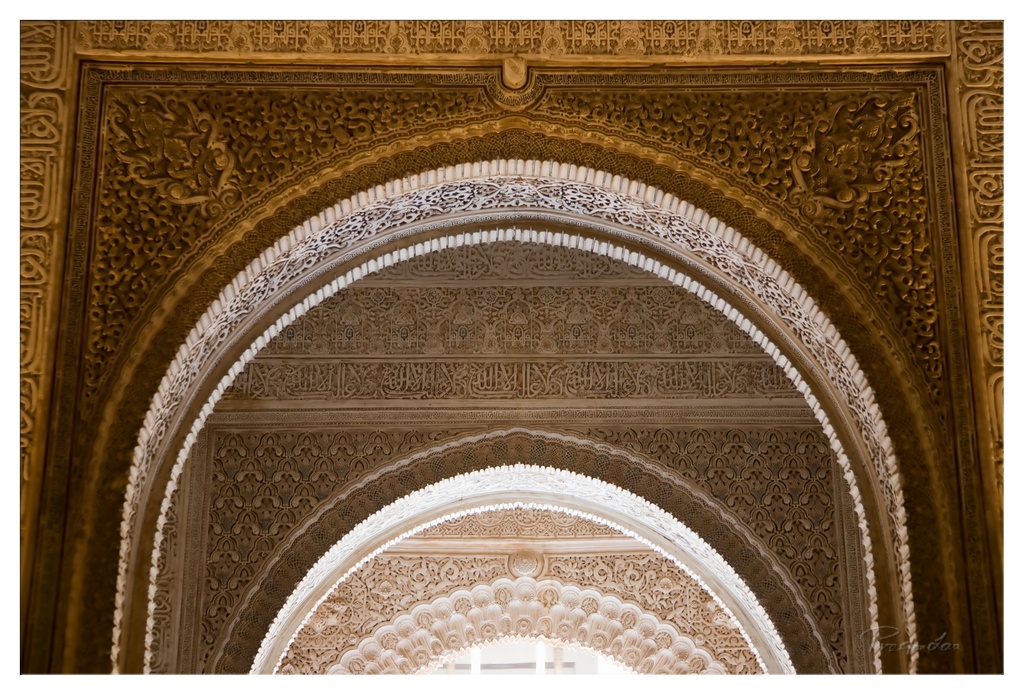

1. Overall Rating (0–10) — 8.5
This photograph captures the breathtaking intricacy of Moorish architecture, where layers of carved stonework unfold like a visual poem. The repetition of arches creates a mesmerizing sense of depth and rhythm, drawing the eye into the heart of the structure. While the warm, golden tones enhance the richness of the carvings, the image’s strength lies in its ability to convey both historical grandeur and quiet spiritual resonance.
2. Composition (0–10) — 9.0
The layered arches create a strong sense of perspective and symmetry, guiding the viewer’s gaze through the frame with elegant precision. The centered composition enhances the feeling of balance and harmony, while the diminishing scale of the arches builds visual depth.
3. Lighting (0–10) — 8.0
Soft, diffused light gently illuminates the intricate carvings, enhancing texture without creating harsh shadows. The light source appears to come from behind, backlit through the arches, which adds a luminous glow to the stonework and emphasizes the delicate details.
4. Color & Tone (0–10) — 8.5
The warm, earthy palette of golds and beiges evokes a sense of antiquity and reverence. The subtle tonal variations across the stone add dimension, while the contrast between the lighter carved details and the deeper shadows enhances visual richness.
5. Creativity (0–10) — 9.0
The photographer’s choice to frame the shot through successive arches creates a dynamic visual journey, transforming a static architectural detail into a narrative of depth and continuity. The use of repetition and perspective demonstrates a strong artistic vision.
6. Technical Quality (0–10) — 9.0
The image is sharp and detailed, with excellent focus across the planes of the arches. The exposure is well-balanced, preserving texture and depth without overexposure in the highlights.
7. Emotional Impact (0–10) — 8.5
The photograph evokes awe and contemplation, inviting the viewer to pause and reflect on the craftsmanship and cultural significance of the space. The quiet elegance of the architecture resonates with a timeless serenity.
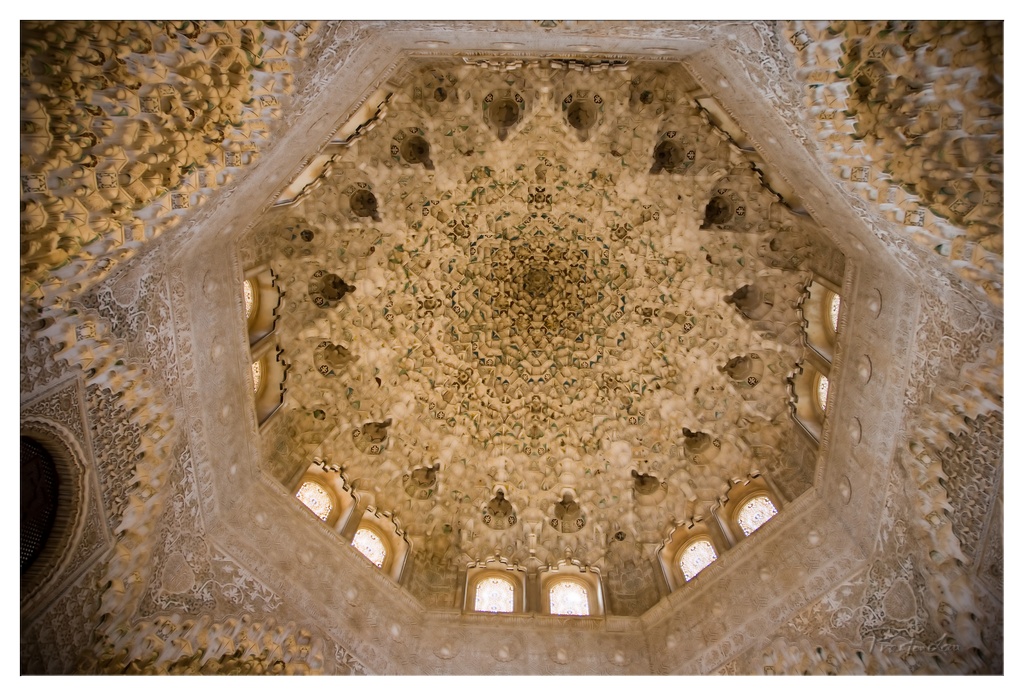

1. Overall Rating (0–10) — 8.0
This photograph captures the breathtaking intricacy of an Islamic architectural dome, where light filters through arched windows to reveal a mesmerizing tapestry of geometric and floral motifs. The rich detail and symmetrical composition evoke a sense of spiritual grandeur and historical depth, though the image’s slightly warm color cast and uneven lighting detract from the full majesty of the space. With a tighter focus on the central design and more balanced exposure, it could achieve greater visual harmony.
2. Composition (0–10) — 8.5
The central, symmetrical placement of the dome draws the eye inward, emphasizing its radial complexity. The octagonal frame and evenly spaced windows create a strong sense of order and rhythm, while the slight tilt adds subtle dynamism without disrupting balance.
3. Lighting (0–10) — 7.0
Natural light from the arched windows illuminates the ceiling from below, enhancing texture and depth. However, some areas remain shadowed, and the overall warmth of the light slightly mutes the contrast and crispness of the intricate carvings.
4. Color & Tone (0–10) — 7.5
The warm, golden tones evoke the ambient glow of stone and aged plaster, reinforcing the historical atmosphere. While the palette is cohesive, a touch more vibrancy in the green and blue inlays would heighten the visual richness and contrast.
5. Creativity (0–10) — 8.0
The upward-looking perspective and careful framing transform a static architectural detail into a dynamic visual journey. The image successfully captures the interplay between light, pattern, and space, reflecting both reverence for the structure and an artistic eye.
6. Technical Quality (0–10) — 8.0
The photograph is sharp and detailed, capturing the fine textures of the stucco and tilework. The focus is consistent across the frame, and the depth of field is well managed, allowing the central motifs to stand out clearly.
7. Emotional Impact (0–10) — 8.5
The image conveys awe and tranquility, inviting the viewer to contemplate the craftsmanship and spiritual intent behind the design. The interplay of light and shadow creates a meditative mood, making the space feel both intimate and vast.
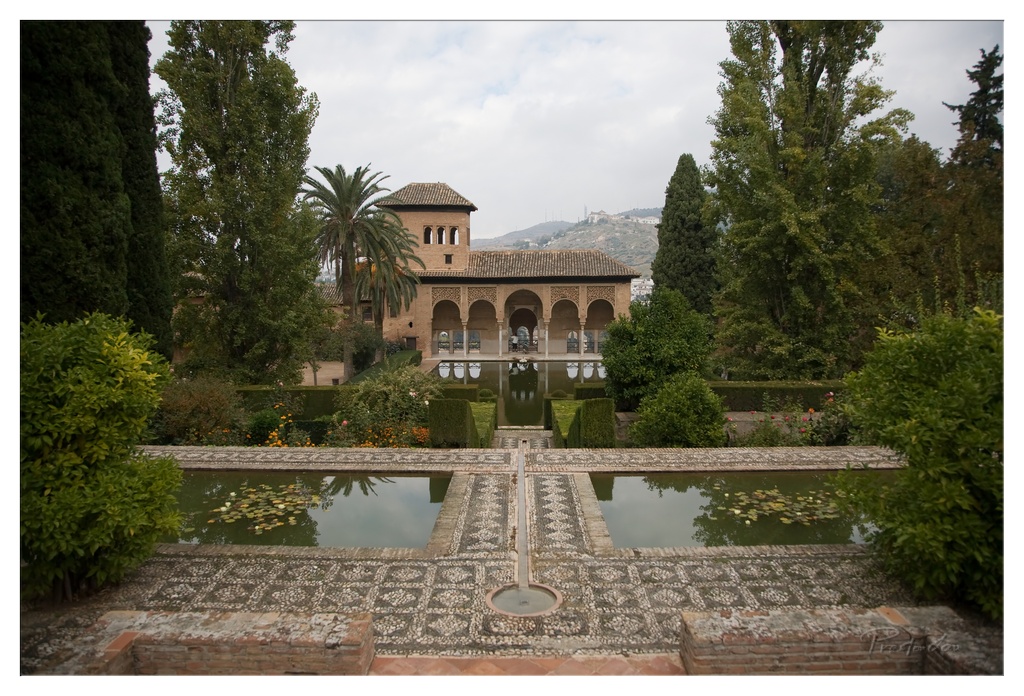

1. Overall Rating (0–10) — 8.0
This photograph captures the serene grandeur of the Alhambra’s gardens, where architecture and nature converge in harmonious symmetry. The composition draws the eye through layered planes—water, mosaic, and stone—toward the historic pavilion, evoking a sense of timeless tranquility. While the overcast sky tempers the warmth of the scene, the image succeeds in conveying the quiet dignity of a place steeped in history and artistry.
2. Composition (0–10) — 8.5
The central axis of the fountain and water channels creates a strong sense of symmetry and balance. The framing by the foreground hedges and the distant building guides the viewer’s gaze with clarity and intention, enhancing the depth and scale of the space.
3. Lighting (0–10) — 6.0
Soft, diffused light from the overcast sky minimizes harsh shadows and allows for even exposure across the scene. While the lighting is gentle and suitable for the mood, it lacks the dramatic contrast and golden warmth that could elevate the textures of the tilework and foliage.
4. Color & Tone (0–10) — 7.0
The palette is rich in natural greens and earthy terracotta tones, complemented by the muted blues of the water. The tonal range is balanced, with the dark mosaic tiles providing visual interest against the lighter stone and reflections, though the overall tone is slightly subdued due to the cloud cover.
5. Creativity (0–10) — 7.5
The image leverages the inherent symmetry and cultural significance of the location to create a contemplative, almost meditative atmosphere. While the approach is traditional, the careful composition and attention to detail reflect a thoughtful interpretation of a well-known site.
6. Technical Quality (0–10) — 8.0
The image is sharp and detailed, particularly in the foreground mosaic and architectural elements. The focus is consistent across the frame, and the exposure is well-managed, preserving detail in both highlights and shadows.
7. Emotional Impact (0–10) — 8.5
There is a profound sense of peace and stillness in the photograph, inviting the viewer to pause and reflect. The quiet beauty of the space, combined with the subtle interplay of water, light, and structure, evokes a deep emotional connection to history, nature, and quiet contemplation.
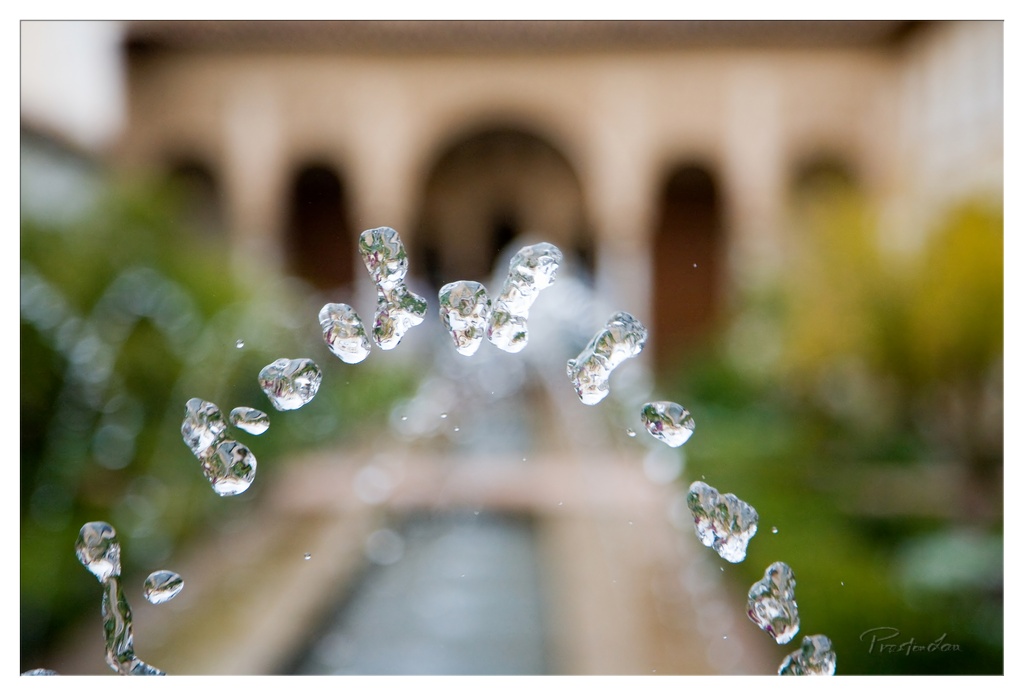

1. Overall Rating (0–10) — 7.5
This photograph captures a delicate interplay between motion and stillness, where suspended water droplets form a luminous arc against a softly blurred architectural backdrop. The shallow depth of field creates an ethereal quality, transforming a simple fountain moment into a poetic visual narrative. While the image is visually striking, the lack of a clear focal point slightly diminishes its narrative power, leaving the viewer with beauty but not a strong emotional anchor.
2. Composition (0–10) — 7.0
The curved arrangement of water droplets creates a natural leading line that draws the eye toward the center of the frame, while the blurred arches in the background provide a sense of symmetry and depth. However, the framing feels slightly unbalanced, with the droplet arc leaning toward the left, which subtly disrupts visual harmony.
3. Lighting (0–10) — 8.0
Soft, diffused daylight enhances the transparency and refractive quality of the water droplets, allowing them to catch light and sparkle. The even exposure and gentle shadows contribute to a calm, serene mood, perfectly complementing the subject's fluid motion.
4. Color & Tone (0–10) — 7.5
The palette is restrained and cohesive, dominated by cool tones of water and muted earthy hues in the background. The subtle contrast between the clear, reflective droplets and the warm, soft focus backdrop creates visual interest without overwhelming the scene.
5. Creativity (0–10) — 8.0
The photographer captures a fleeting moment with artistic intent, transforming a common scene into something delicate and dreamlike. The use of selective focus and the intentional framing of the droplets suggest a strong conceptual vision, elevating the image beyond mere documentation.
6. Technical Quality (0–10) — 8.5
The image is sharp where it matters—on the water droplets—while the background is appropriately blurred, demonstrating precise control over depth of field. The fine detail in the droplets’ textures and reflections reveals high resolution and technical mastery.
7. Emotional Impact (0–10) — 7.0
The image evokes a sense of tranquility and quiet wonder, inviting the viewer to pause and appreciate the beauty in transient moments. While emotionally resonant, the lack of a strong narrative element keeps the emotional connection from fully taking hold.
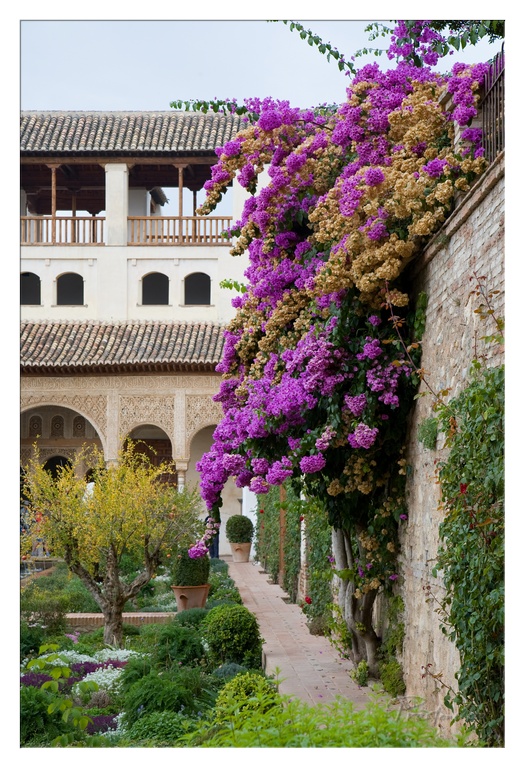

1. Overall Rating (0–10) — 8.0
This photograph captures the serene elegance of a Moorish garden, where vibrant floral bursts contrast beautifully with the architectural harmony of the Alhambra. The composition draws the eye along a winding path, inviting contemplation and quiet immersion. While the image is rich in color and texture, its potential for deeper emotional resonance is slightly held back by a lack of dramatic lighting or dynamic perspective.
2. Composition (0–10) — 8.0
The diagonal flow of the bougainvillea and the path creates a strong leading line, guiding the viewer through the scene with natural grace. The balance between the lush greenery and the stonework is well-considered, with the architecture framing the floral display effectively.
3. Lighting (0–10) — 6.5
Soft, diffused daylight evenly illuminates the scene, preserving detail without harsh shadows. While the light is flattering, it lacks the warmth or contrast that might elevate the mood and highlight the textures of the stone and petals.
4. Color & Tone (0–10) — 8.5
The vivid purple of the bougainvillea stands out against the earthy tones of the wall and the muted greens of the garden, creating a striking yet harmonious palette. The tonal range is rich, with subtle variations in hue that enhance the visual depth.
5. Creativity (0–10) — 7.5
The image captures a classic, almost timeless scene, but its strength lies in its authenticity rather than innovation. The interplay of natural and architectural elements is thoughtfully presented, offering a fresh view of a well-known space.
6. Technical Quality (0–10) — 8.0
The photograph is sharp and clear, with fine detail visible in both the flowers and the intricate stonework. Focus is consistent across the frame, and the exposure is well-balanced.
7. Emotional Impact (0–10) — 7.5
The image evokes a sense of peace and quiet beauty, inviting the viewer to imagine the gentle sounds of a sunlit courtyard. The lush, blooming garden suggests renewal and tranquility, creating a strong emotional connection to place and history.
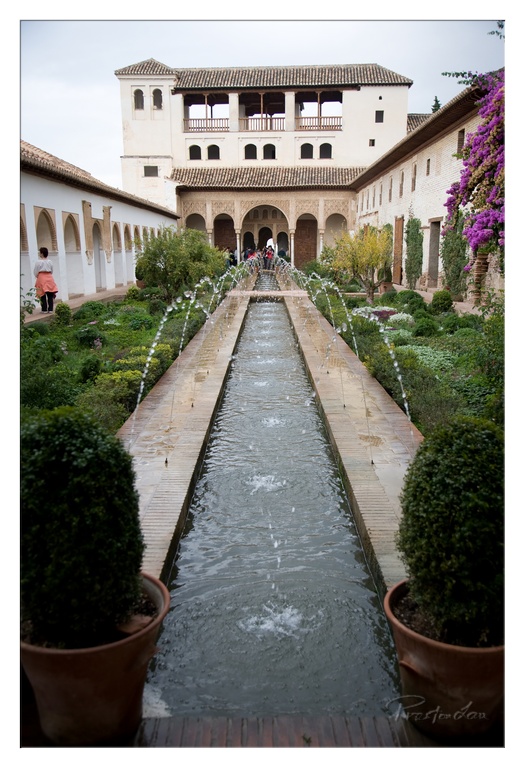

1. Overall Rating (0–10) — 8.0
This photograph captures the serene grandeur of a Moorish courtyard, where water, architecture, and greenery converge in harmonious balance. The long central fountain draws the eye toward the ornate arches and tiled façade, evoking a sense of timelessness and quiet contemplation. While the overcast sky tempers the warmth of the scene, the composition’s symmetry and depth lend it a cinematic elegance that elevates it beyond mere documentation.
2. Composition (0–10) — 9.0
The strong central axis created by the fountain guides the viewer’s gaze toward the architectural focal point, with symmetrical framing and foreground potted shrubs adding depth and balance. The placement of the lone figure on the left provides scale without disrupting harmony.
3. Lighting (0–10) — 6.0
Diffused, overcast light softens shadows and creates a muted mood, which suits the contemplative tone but reduces the richness of textures and architectural detail. The lack of direct sunlight tempers the image’s vibrancy.
4. Color & Tone (0–10) — 7.0
The palette is restrained—whites and earthy terracotta dominate, punctuated by the vibrant purple of the flowering vine and the deep green of the shrubbery. The tonal range is gentle, with subtle contrast that enhances the tranquil atmosphere.
5. Creativity (0–10) — 8.0
The image successfully captures the cultural and spiritual essence of the space, using symmetry and perspective to convey order and reflection. The choice to include the distant visitors adds a quiet narrative layer without disrupting the scene’s tranquility.
6. Technical Quality (0–10) — 8.5
Sharp focus across the frame, clean detail in the water and stonework, and a well-managed depth of field contribute to a technically strong image. The watermark is discreet and does not detract from the composition.
7. Emotional Impact (0–10) — 8.0
The photograph evokes a deep sense of peace and reverence, inviting the viewer to pause and reflect. The quiet presence of the people, the gentle movement of water, and the timeless architecture combine to create a meditative, almost sacred atmosphere.
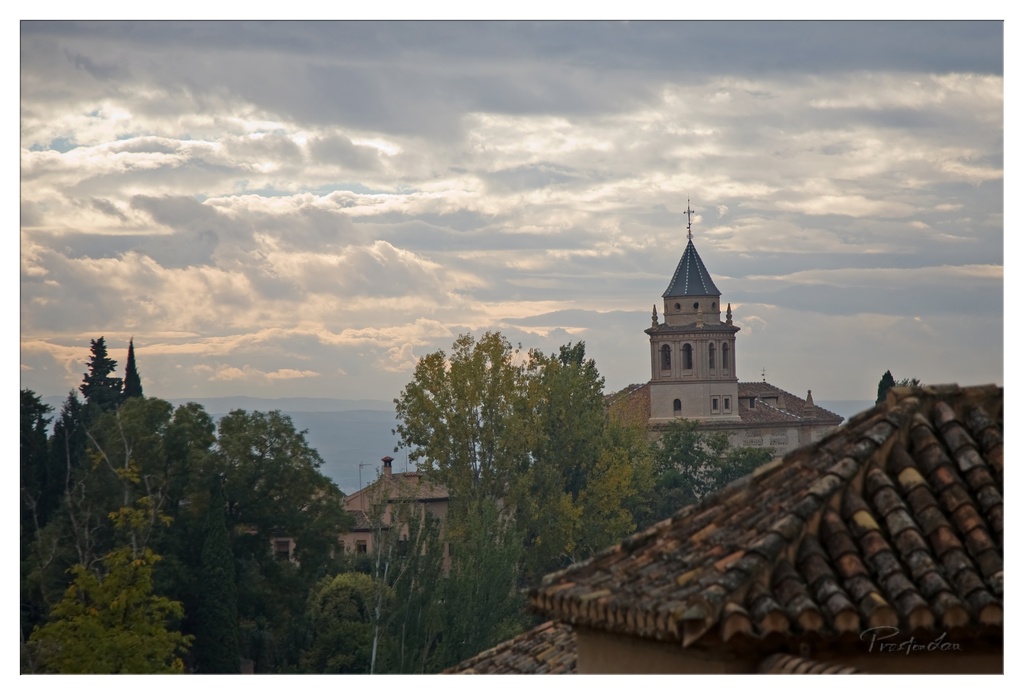

1. Overall Rating (0–10) — 7.0
This photograph captures a serene, contemplative moment in a historic European town, where the interplay of light and shadow lends a timeless quality to the scene. The church tower rises above the treetops with quiet dignity, framed by a dramatic sky that suggests both transition and permanence. While the image is rich in atmosphere, a more deliberate use of contrast and focus could elevate its emotional resonance and visual clarity.
2. Composition (0–10) — 7.5
The foreground roofline anchors the image, creating depth and guiding the eye toward the central tower. The placement of the tower slightly off-center adds balance, while the trees provide a natural frame that enhances the sense of place.
3. Lighting (0–10) — 7.0
Soft, diffused light filters through the clouds, casting a gentle glow on the tower and creating a moody, atmospheric quality. The interplay of light and shadow adds dimension, though the overall brightness is somewhat flat, limiting the dramatic effect.
4. Color & Tone (0–10) — 6.5
The palette is composed of muted earth tones—terracotta, olive, and soft grays—that harmonize well and evoke a sense of history. However, the colors lack vibrancy, giving the image a slightly subdued and desaturated appearance.
5. Creativity (0–10) — 7.0
The image successfully captures a moment of quiet beauty, using the landscape and architecture to tell a story of place and time. The choice to include the textured roof in the foreground adds a layer of intimacy and perspective.
6. Technical Quality (0–10) — 7.5
The image is sharp and well-exposed, with clear detail in both the foreground and background. The focus is consistent, and there is minimal noise, indicating strong technical execution.
7. Emotional Impact (0–10) — 7.0
The photograph evokes a sense of peace and nostalgia, inviting the viewer to pause and reflect. The overcast sky and quiet town create a contemplative mood that resonates on a personal level.
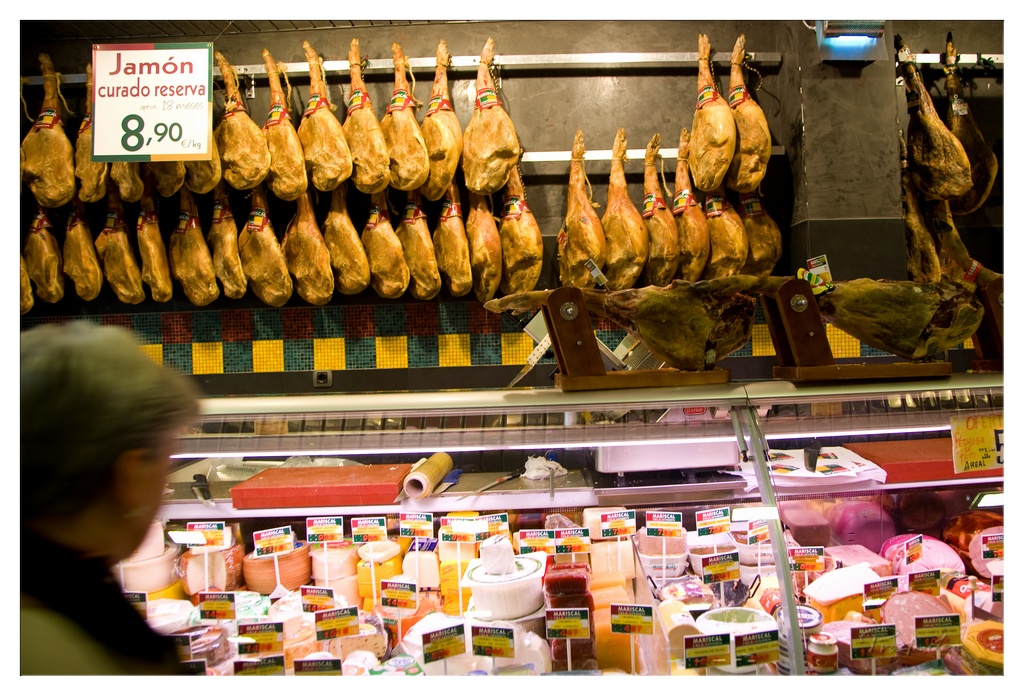

1. Overall Rating (0–10) — 7.0
This photograph captures the rich, sensory atmosphere of a traditional Spanish deli, where cured ham and artisan cheeses create a tapestry of cultural authenticity. The warm glow of the display lighting enhances the golden hues of the jamón, while the blurred figure in the foreground adds a subtle human presence, grounding the scene in everyday life. Though the composition feels slightly busy, the image succeeds in conveying both the abundance and tradition of the setting.
2. Composition (0–10) — 6.0
The layered arrangement of hanging jamón and stacked cheeses creates visual depth, but the cluttered foreground and off-center framing reduce compositional harmony. A tighter focus on the ham or a more deliberate subject placement would improve balance.
3. Lighting (0–10) — 7.0
The warm, directional lighting from within the display case enhances the textures and rich tones of the cured meats and cheeses, creating a cozy, inviting mood. The contrast between the lit display and the darker background adds depth and draws the eye to the main subject.
4. Color & Tone (0–10) — 6.5
The warm, golden tones of the jamón dominate, complemented by the colorful labels and the mosaic tile backdrop. The overall palette is rich and inviting, though the slight overexposure in the cheese case reduces tonal subtlety.
5. Creativity (0–10) — 7.0
The image captures a moment of cultural specificity with strong narrative potential. The juxtaposition of the human silhouette against the meticulously arranged food products suggests a story of tradition and daily ritual, elevating the scene beyond mere documentation.
6. Technical Quality (0–10) — 7.5
The focus is sharp on the central display, with clear detail in the jamón and labels. The slight motion blur on the figure in the foreground is intentional and adds dynamism, though minor chromatic aberration is visible along high-contrast edges.
7. Emotional Impact (0–10) — 7.0
The photograph evokes a sense of warmth, authenticity, and sensory indulgence, inviting the viewer to imagine the taste and aroma of the cured meats and cheeses. The presence of a real person, even in silhouette, adds a layer of intimacy and connection to the scene.
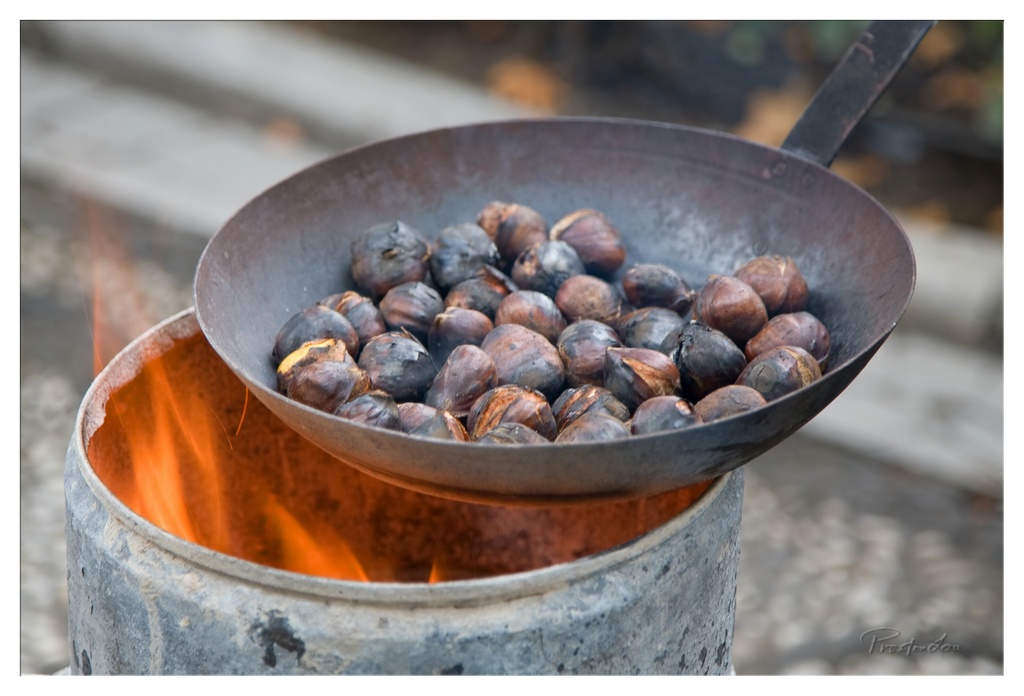

1. Overall Rating (0–10) — 7.5
This photograph captures the rustic warmth of chestnuts roasting over an open flame, evoking a sense of tradition and simple pleasure. The interplay of glowing fire and charred nuts creates a tactile, sensory experience, while the shallow depth of field draws focus to the heart of the action. The image is grounded in authenticity, though a more deliberate composition could elevate its visual narrative.
2. Composition (0–10) — 6.5
The pan is slightly off-center, with the flame anchoring the lower left, creating a diagonal energy that guides the eye. The depth of field effectively isolates the subject, but the background clutter slightly distracts from the central focus.
3. Lighting (0–10) — 8.0
The warm, flickering light from the fire casts a rich glow on the chestnuts and pan, enhancing texture and creating a natural contrast with the cooler, muted surroundings. The directional light emphasizes form and movement.
4. Color & Tone (0–10) — 7.0
The dominant palette of deep browns, blacks, and vibrant orange creates a cohesive, earthy tone. The warmth of the fire contrasts sharply with the cool gray of the metal, adding visual interest and emotional resonance.
5. Creativity (0–10) — 7.5
The image captures a moment of everyday life with poetic intention, transforming a simple act into a sensory experience. The use of natural light and organic textures gives it a timeless, almost nostalgic quality.
6. Technical Quality (0–10) — 8.0
Sharp focus on the chestnuts and pan, with a well-managed depth of field. The exposure is balanced, capturing both the brightness of the flames and the detail in the dark shells.
7. Emotional Impact (0–10) — 8.0
The photograph evokes comfort, memory, and the quiet joy of seasonal rituals. The warmth of the fire and the familiar sight of roasting chestnuts stir a deep sense of nostalgia and sensory delight.
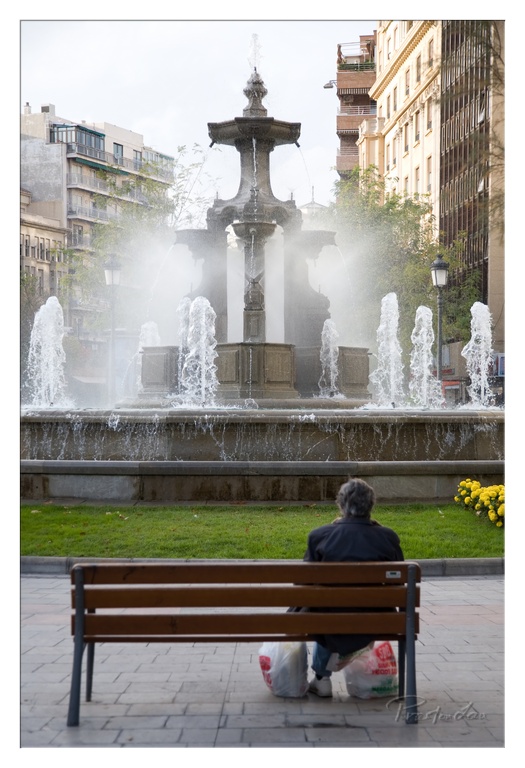

1. Overall Rating (0–10) — 6.8
This photograph captures a quiet urban moment, where the motion of a fountain contrasts with the stillness of a solitary figure, evoking a sense of contemplative solitude. The composition draws the eye toward the central monument, while the muted, overcast light lends a melancholic tone. Though the image is visually balanced and thoughtfully framed, it lacks a strong emotional hook, leaving the viewer with a sense of observation rather than connection.
2. Composition (0–10) — 7.0
The subject is placed off-center in the foreground, creating a natural visual path toward the fountain. The symmetry of the fountain provides balance, though the slightly cluttered background slightly distracts from the central focus.
3. Lighting (0–10) — 5.5
Diffused daylight from an overcast sky creates even illumination but flattens the scene, reducing texture and depth. The lack of shadows limits the sense of dimension, softening the visual impact.
4. Color & Tone (0–10) — 6.0
The palette is subdued, dominated by grays and earth tones, with the yellow flowers providing a small but effective pop of color. The overall tone is restrained, reinforcing the quiet, reflective mood.
5. Creativity (0–10) — 6.5
The juxtaposition of stillness and motion—person, bench, and fountain—creates a narrative tension. The framing suggests a story, but the execution remains conventional, with little stylistic risk or surprise.
6. Technical Quality (0–10) — 7.5
The image is sharp and well-focused, with clean detail in the fountain and bench. The exposure is balanced, and the digital clarity enhances the realism of the scene.
7. Emotional Impact (0–10) — 6.0
The solitude of the figure invites introspection, but the emotional distance created by the overcast lighting and neutral tone prevents a deeper resonance. The viewer is invited to observe, but not to feel.
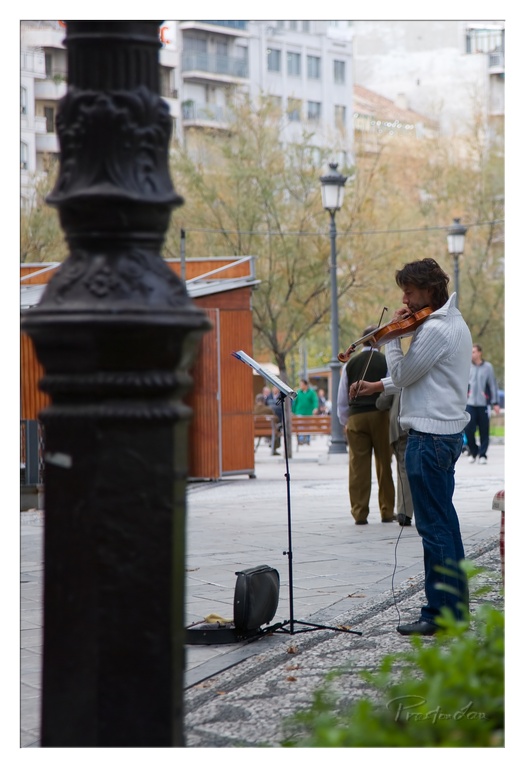

1. Overall Rating (0–10) — 6.0
This photograph captures a candid moment of a street musician playing violin in an urban park, evoking a sense of everyday artistry and quiet performance. The framing through a foreground lamppost adds depth and narrative context, while the soft natural light and muted tones lend a contemplative mood. Though the image feels authentic and well-composed, it lacks a strong focal point and visual tension, making it more observational than emotionally resonant.
2. Composition (0–10) — 6.5
The foreground lamppost creates a natural frame, guiding the eye toward the violinist, though the subject is slightly off-center and partially obscured by background elements. The diagonal lines of the pavement and the music stand add visual interest, but the composition feels slightly unbalanced due to the cluttered background.
3. Lighting (0–10) — 6.0
Diffused daylight provides even, soft illumination, minimizing harsh shadows and allowing the scene to feel natural and unposed. The lighting supports the mood of a quiet, everyday moment but lacks dramatic contrast or directional emphasis.
4. Color & Tone (0–10) — 5.5
The palette is subdued, dominated by earthy browns, muted greens, and soft grays, which contribute to a calm, realistic atmosphere. However, the colors lack vibrancy and saturation, resulting in a somewhat flat and underexposed appearance.
5. Creativity (0–10) — 6.0
The use of the lamppost as a framing device demonstrates thoughtful composition and a narrative intent. The scene captures a slice of urban life with authenticity, but the lack of a unique perspective or emotional intensity limits its originality.
6. Technical Quality (0–10) — 7.0
The image is sharp in the mid-ground where the musician is located, with clear focus on the violinist and music stand. The depth of field is appropriate, though the foreground and background are slightly soft, which is stylistically fitting but technically less precise.
7. Emotional Impact (0–10) — 5.5
The photograph conveys a sense of quiet dedication and urban solitude, but the emotional connection is restrained. The viewer is invited to observe rather than feel, as the subject remains distant and the scene lacks a strong emotional focal point.
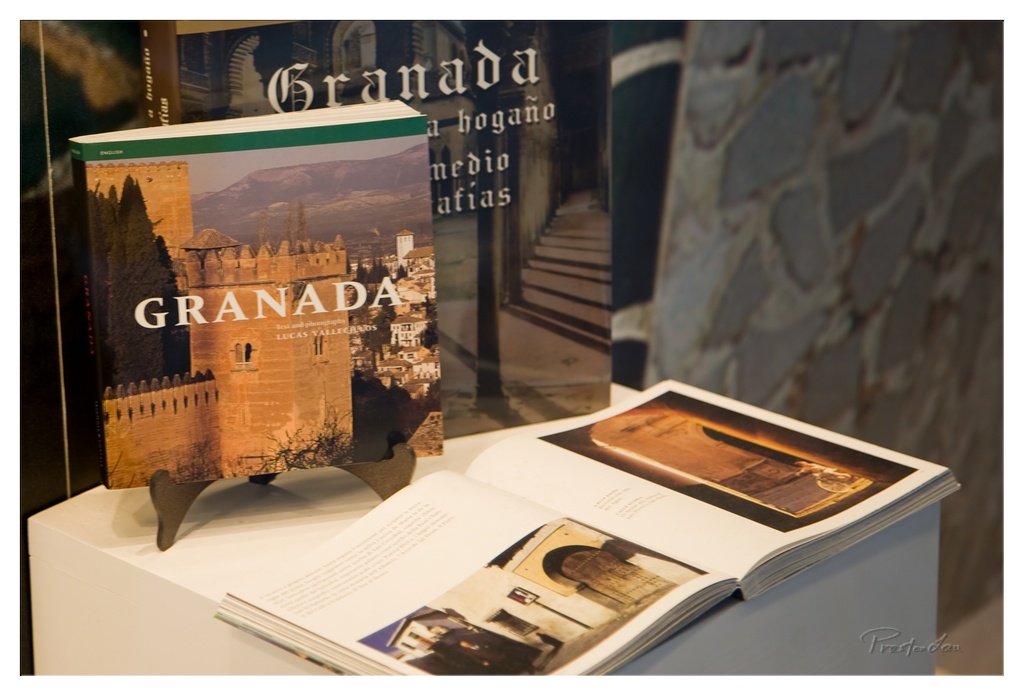

1. Overall Rating (0–10) — 6.8
This photograph captures the quiet reverence of a cultural display, where a book about Granada becomes both subject and symbol of heritage. The warm, golden tones of the book cover echo the historic architecture within its pages, creating a layered visual narrative. While the composition feels slightly staged and the lighting lacks dramatic depth, the image succeeds in evoking a sense of place and memory—its quiet dignity is its greatest strength.
2. Composition (0–10) — 6.5
The book on the stand is the clear focal point, but the open book in the foreground creates a natural leading line. The depth of field is shallow, blurring the background slightly, which helps isolate the subject. However, the placement of the open book feels slightly awkward, and the background text is distracting rather than enhancing.
3. Lighting (0–10) — 6.0
The lighting is soft and directional, likely from an overhead source, creating gentle highlights on the book’s cover and pages. While it enhances the texture of the paper and the image’s warmth, the flatness of the illumination prevents strong shadows or contrast, giving the scene a somewhat sterile feel.
4. Color & Tone (0–10) — 7.0
The warm golden and earthy tones of the book cover harmonize with the interior scenes, reinforcing the historical theme. The muted background palette allows the book to stand out, and the overall tonal balance is cohesive, though the color saturation is restrained, lending a subdued, documentary-like quality.
5. Creativity (0–10) — 6.5
The image plays with layers—physical books, architectural imagery, and text—to create a meta-narrative about memory and place. The idea of a book about Granada being displayed within a space that reflects its subject is conceptually strong, though the execution feels more illustrative than artistically bold.
6. Technical Quality (0–10) — 7.5
The focus is sharp on the book cover and the open pages, and the details are clear. The depth of field is controlled effectively, though the slight blur in the background is not entirely smooth. The image is free of noise and appears well-exposed, with good handling of highlights and shadows.
7. Emotional Impact (0–10) — 6.0
The photograph evokes a quiet contemplation, inviting the viewer to reflect on history, storytelling, and preservation. While the emotional resonance is subtle, it lingers in the warmth of the tones and the sense of stillness, creating a moment of quiet reverence rather than dramatic impact.
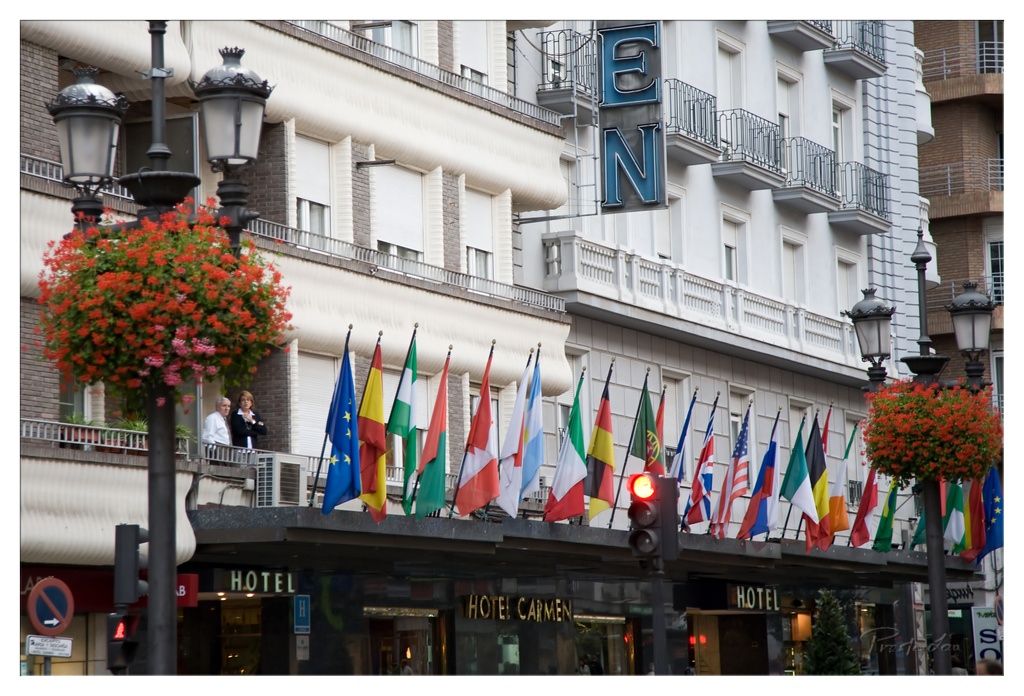

1. Overall Rating (0–10) — 6.8
This photograph captures the bustling charm of a European city street, centered on the Hotel Carmen, where international flags create a vibrant ribbon across the façade. The interplay of architectural detail, cultural symbolism, and urban life lends a documentary quality to the scene, though the visual density risks feeling slightly overwhelming. The image succeeds in conveying the energy of a cosmopolitan hotel, but its emotional resonance is tempered by a lack of compositional focus.
2. Composition (0–10) — 6.0
The diagonal line of flags draws the eye across the frame, but the cluttered foreground and busy background dilute the visual hierarchy. The placement of the two figures on the balcony adds narrative depth, yet they are partially obscured by the hanging baskets, creating a sense of visual tension.
3. Lighting (0–10) — 6.5
Natural daylight illuminates the scene evenly, with soft shadows suggesting an overcast sky. While the lighting is clear and functional, it lacks dramatic contrast or directional warmth, resulting in a neutral mood that aligns with the photograph’s observational intent.
4. Color & Tone (0–10) — 7.0
The rich reds of the flowering baskets provide a striking contrast against the muted whites and grays of the building, while the variety of flag colors adds vibrancy. The overall palette is balanced, with the blue and red hues of the flags creating a subtle visual rhythm.
5. Creativity (0–10) — 6.5
The image leverages a compelling combination of urban architecture, international identity, and everyday life, but its strength lies more in its narrative content than in artistic innovation. The framing feels like a snapshot rather than a deliberate composition.
6. Technical Quality (0–10) — 7.5
Sharp focus and clean detail are evident throughout, with good control over exposure. The depth of field is sufficient to keep both the foreground and background elements in focus, enhancing the scene’s clarity.
7. Emotional Impact (0–10) — 6.0
The photograph evokes a sense of place and movement, suggesting the transient nature of a hotel as a hub for travelers from around the world. However, the lack of a strong focal point or emotional narrative keeps the viewer at a slight remove, making the impact more intellectual than visceral.
Loading map...